










When the government released its Road to Zero Strategy, it declared that it would be technology neutral and that it would not speculate on which technologies might help to deliver its mission.
However, at this stage, the country is mostly geared up for electrification, with significant investments from government and industry to build adequate EV charging networks and incentivise the purchase of electric vehicles.
But in addition to adopting electric vehicles, what other ways can transport, specifically fleet operations, become net zero? This issue of GreenFleet explores the fleet industry’s progress on its decarbonisation journey, as well as the challenges that remain.
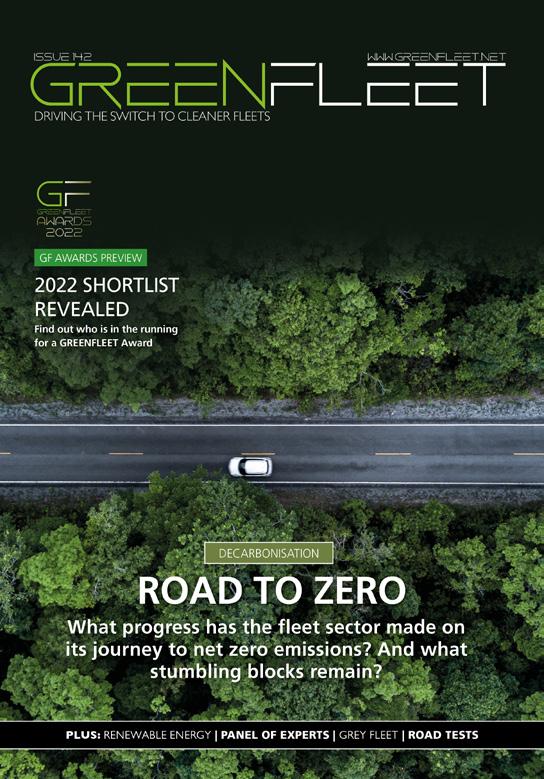

Jacob Roberts from the Association for Renewable Energy and Clean Technology takes on the renewable fuels debate, showing why it is still green to operate an electric vehicle, even if it’s charged using the grid which does not have 100 per cent renewable energy. He also explores ways for companies to ensure their EVs are truly zero ‘well-to-wheel’ emission.
We also preview the GREENFLEET Awards, with a look at the 2022 shortlist which showcases the huge amount of innovation going on in the fleet and transport sector. Good luck to all those in the running for an award.




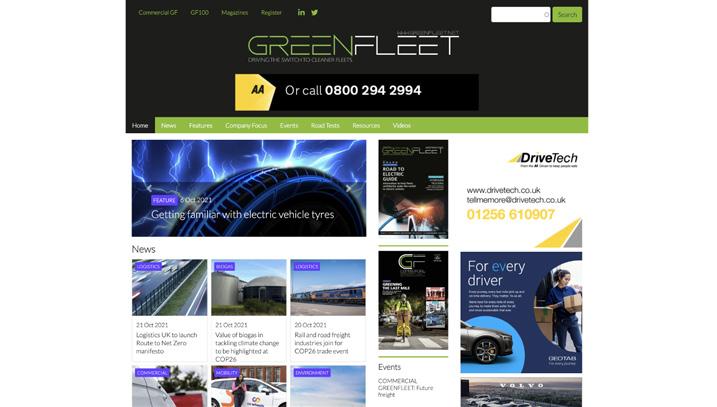
 Angela Pisanu, editor
Angela Pisanu, editor

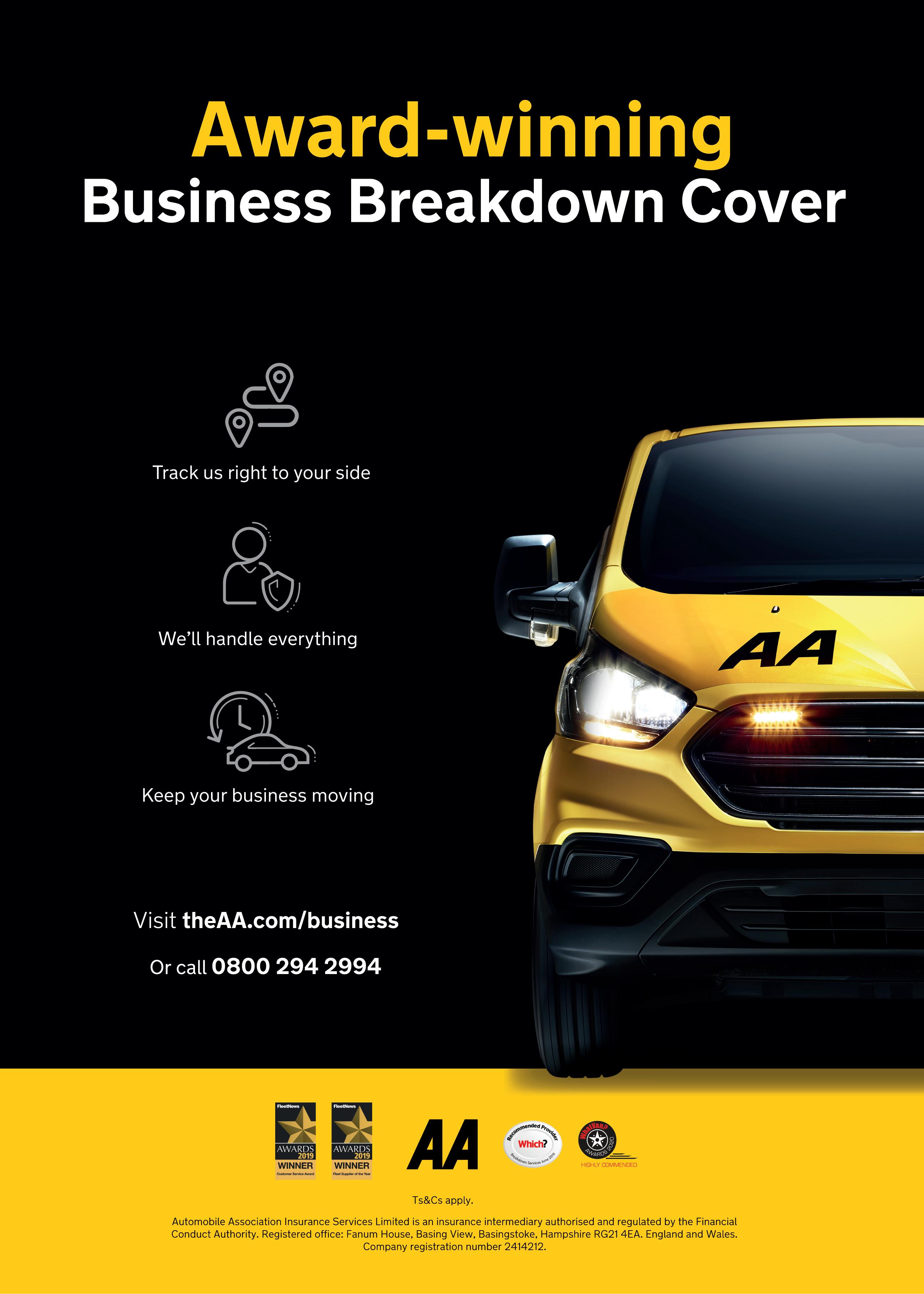
Zero Emission Vehicles Declaration at 210 signatories; Ultra Low Emission Zone to be expanded London-wide ; and GREENFLEET’S Great British EV Rally named ‘Event of the Year’
James Lancaster, chair of the Urban Mobility Partnership, explains why grey fleet reduction must be incorporated at the heart of clean air, environmental and transport plans, and how it can be done
The lack of 100 per cent renewable electricity in the grid should not hold fleets back from using electric vehicles. Jacob Roberts, transport policy manager at the Association for Renewable Energy and Clean Technology, explains why


The largest fleets in the UK continue to lead the EV transition but are facing challenges. Members of the UK

Electric Fleets Coalition are urging the government to offer businesses greater detail and funding to reinforce confidence in their EV ambitions

Electric vehicles are in high demand and fleets remain committed to bringing them onto UK roads. But if more fleets are to switch to zero emission vehicles, certain barriers must be tackled. The BVRLA’s latest Road to Zero Report Card reveals a snapshot of the progress made
The UK has a target to be net zero emission by 2050. When it comes to the decarbonisation of transport, electrification plays a central role. But is it the only route? And what happens if electric vehicles are deemed unsuitable? Our panel of experts discuss
When it comes to the decarbonisation of fleets, change is key. But change can pose significant barriers on the road to net zero. This was discussed at GreenFleet’s roundtable, which saw fleet managers and industry professionals gather at Anfield Stadium in Liverpool on 20th October

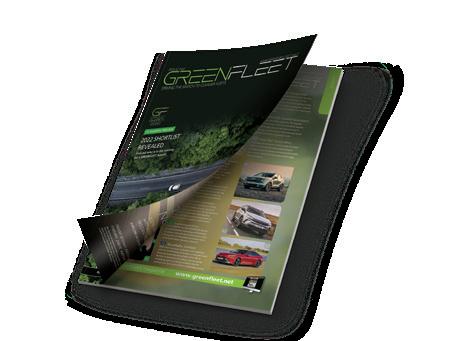
The shortlist for the 2022 GREENFLEET Awards has been revealed, showcasing environmental excellence within the fleet and transport sector. Taking place on 8 December, the Awards return to the British Motor Museum in Warwick
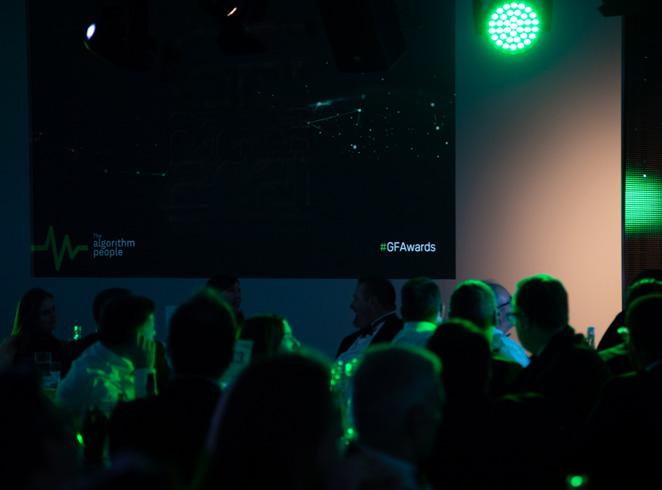
Whilst there are many challenges to be addressed with the electrification of transport, it was also noted during the GreenFleet Roundtable at The OEC in Sheffield in November, that diesel costs are quietly creeping up again. A sobering reminder, that the business case for net zero fleets is continually evolving
Reinvented and rejuvenated, the new Kia Sportage embraces plug-in hybrid technology in its fifth generation. Richard Gooding finds a striking-looking car packed with technology and equipment, with the promise of greatly reduced running costs from its new PHEV powertrain
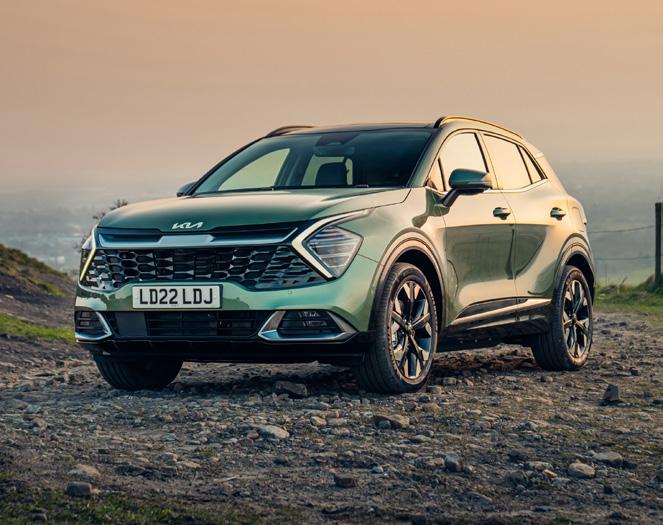
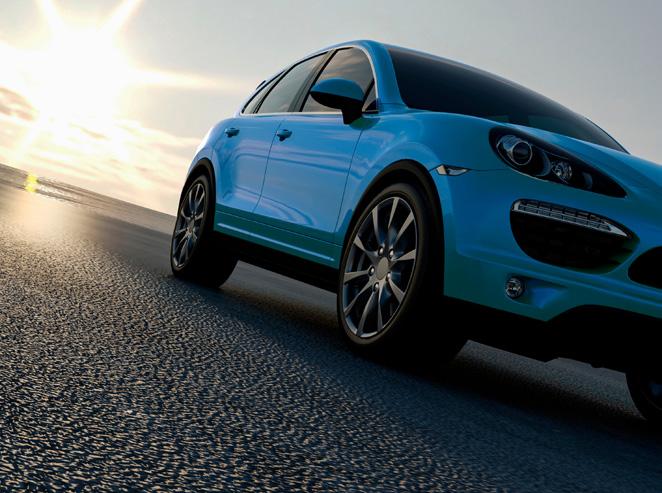
Competing in the highly important C-SUV segment, the Grandland plays a vital role in the UK for Vauxhall. Richard Gooding discovers the improved levels of technology and low emission PHEV powertrain should appeal to fleet drivers and managers alike

A hydrogen fuel cell electric vehicle pioneer, the Toyota Mirai has been comprehensively updated. Richard Gooding discovers the all-new second-generation model has a greatly improved driving range as well as many luxurious features
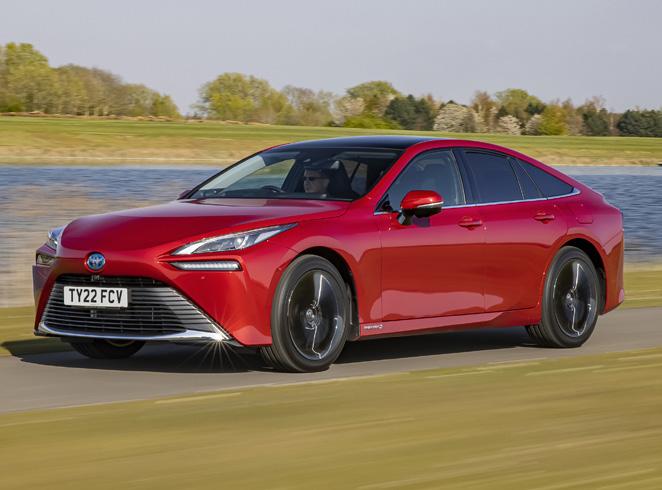

Campaign, who will work together to promote a faster global ZEV transition and help signatories implement those commitments by providing bespoke workshops, assistance and access to a international community of best practice.
Alok Sharma, COP26 President, said: “The ZEV declaration signed at COP26 was a major milestone bringing together leading actors to accelerate the transition to 100 percent new car sales being zero emission by 2040, and 2035 in leading markets.”
The Zero Emission Vehicles Declaration, which was launched at COP26, now has over 210 signatories (up from 130 at COP26). This includes commitments from national and sub-national governments, manufacturers, businesses and fleet owners. New signatories include France, Spain, Abou Ghaly Motors, and Vikram Solar.
To host the ZEV declaration from COP27 onwards, the Accelerating to Zero Coalition (A2Z) has been launched at COP27.
The A2Z Coalition is a partnership between the UK, the UN High Level Action Champions team, the Climate Group, the International Council on Clean Transportation and the Drive Electric READ MORE
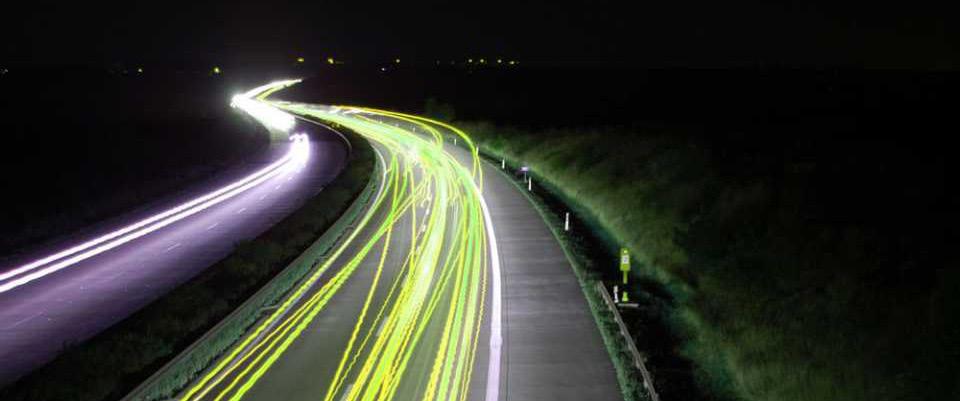
“There are still huge opportunities in emerging markets and developing economies which is why I’m pleased to formally launch the Accelerating To Zero Coalition today. This coalition provides the platform for countries to go further and faster and to ensure that no country is left behind.”
Centrica and Ryze Hydrogen are set to jointly build and operate hydrogen production facilities aimed at providing a reliable supply of hydrogen for industry and transportation.

The firms will jointly develop hydrogen production projects on existing Centrica sites and work with third-parties to build production on their sites too.
Among the initial projects under consideration, Centrica and Ryze will examine solutions for converting some of the British Gas fleet to hydrogen, including refuelling infrastructure, locations and van technology.
In addition, the partnership will explore how the UK can work with international hydrogen production facilities to move low-cost renewable power converted to hydrogen and hydrogen derivates to areas of high demand.
William Mezzullo, Centrica’s head of hydrogen, said: “Low carbon hydrogen will play a major role in decarbonising our energy
systems. It enables the increased use of renewable and low carbon electricity by offering the potential for storage in quantities that provide long term resilience and another choice for decarbonising hard to electrify sectors.
“We should be bold in our thinking, the UK should aim to be a net exporter of hydrogen, providing high quality green jobs, additional revenues for the UK treasury and a lower cost of transitioning to Net Zero for homeowners and businesses.”
Jo Bamford, green entrepreneur and executive chairman of Ryze, said: “The projects we have already discussed with Centrica will be gamechanging for the green hydrogen economy and will underline why hydrogen is such an important resource for the UK and the rest of the world in the fight against climate change.”
Bristol City Council has launched a Clean Air Zone, which covers a small central area of the city and the Portway, and means older and more polluting vehicles will be charged.
Daily charges for Bristol Clean Air Zone apply 24 hours a day (midnight to midnight), seven days a week, all year round, and must be paid within six days of travel.
Business owners can sign up to the Business Accounts Feature, to set up a Bristol-specific account to help manage payment for multiple vehicles entering and exiting the Zone.
The council will send Penalty Charge Notices to people who drive non-compliant vehicles in the Zone and do not pay the appropriate daily charge. However, for the next six weeks, people will be given the option of a Special Payment Offer which gives seven additional days to pay the appropriate daily charge for that journey. This is £9 for private cars, taxis and light goods vehicles and £100 for heavy goods vehicles, buses and coaches. If the charge is paid, the remaining Penalty Charge of £120 will be cancelled.
Failure to pay this daily charge will result in a full Penalty Charge Notice of £120, or £60 if paid within 14 days, as well as the outstanding daily charge.
Drivers in Bristol and surrounding areas are encouraged to look out for roadside signage showing when they are entering or approaching the zone. Some signs count down how many miles to go until the zone starts and others have a green cloud symbol on, with the letter D inside.
READ MORE
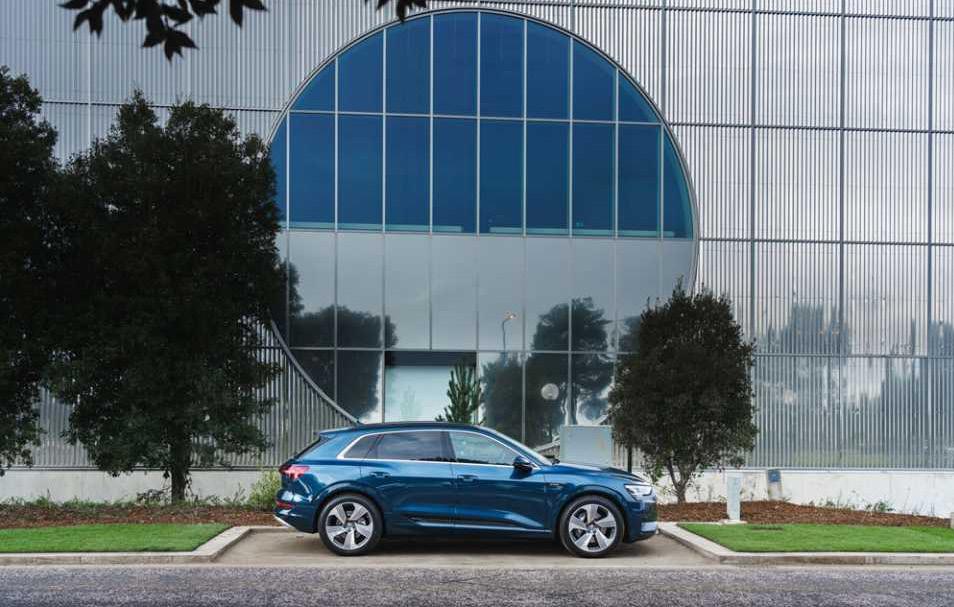
Audi is the first car manufacturer in the UK to receive Electric Vehicle Approved (EVA) accreditation across its entire network of centres. EVA accreditation was developed by the National Franchised Dealers Association (NFDA), endorsed by the Government’s Office for Zero Emission Vehicles (OZEV) and independently audited by Energy Saving Trust. The accreditation is a clear demonstration of electric vehicle expertise across all areas of automotive retail and Audi’s achievement is a reflection of the company being at the forefront of electric vehicle development. Audi is the first brand to achieve 100 percent EVA approval across its 113 Centres. The EVA scheme encourages dealerships to further develop their ability in selling and servicing electric vehicles and build consumer confidence in electric vehicle technology.
Andrew Doyle, director Audi UK, commented:
“Audi has a clear and unwavering commitment to electric vehicles - from 2026 every new model we launch will be fully electric. It’s therefore essential that our expertise and knowledge are applied across the entire business and visible to all – especially to our customers.
“Being the first manufacturer in the UK to achieve 100 per cent network EVA accreditation is a testament to our first-class teams across our dealer network and at Audi UK. We are matching rapid customer interest in our electric vehicles by equipping our company and staff with the tools and training they need to provide a seamless and confidence-inspiring experience to our customers as we accelerate the transition to a fully electric future.”
As part of the EVA accreditation, each Audi Centre is independently audited by
the Energy Saving Trust to verify that they meet a set of standards covering EV sales and aftersales. These include the customer qualification process, staff knowledge and training, EV demonstration and handover processes, as well as the availability of EV service bays and charge points on site.

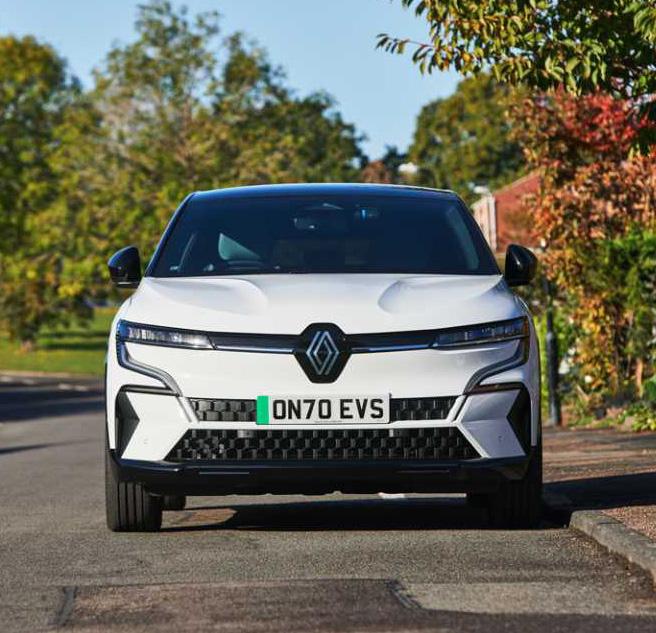
Electric car subscription service Onto has added the newly released Renault Megane E-Tech to its fleet. The Renault Megane E-Tech has a 60kWh battery, a range of 225 miles, and can charge from 10 to 80 per cent in just 30 minutes. Onto subscribers can choose the Renault Megane E-Tech in the Techno trim at £799 per month. Rob Jolly, CEO and co-founder at Onto, said: “The Renault Zoe has been a popular car amongst
subscribers since we partnered with Renault at the beginning of our journey. We’re thrilled to build on our partnership to launch the award-winning Renault Megane E-Tech and we’re seeing strong demand already. As we continue to grow, introducing new models to the fleet will ensure we continue to offer people flexibility and choice.”
READ MORE
The Ultra Low Emission Zone (ULEZ) will be expanded London-wide, the Mayor of London Sadiq Khan has announced.

The expansion will come into effect on 29 August 2023 and will operate across all London boroughs up to the existing Low Emission Zone boundary.
The expansion will be accompanied by a brand new £110m scrappage scheme to support Londoners on lower incomes, disabled
Londoners, charities and small businesses and sole traders.
Successful scrappage applicants will receive a grant to scrap or – for the first time –retrofit their vehicle for certain vans and minibuses. Successful car owners can opt to receive a smaller grant accompanied by up to two free annual bus and tram passes, which would give them a higher financial package.
READ MORE
The Great British EV Rally, which took place 4-8 July, has been awarded ‘Event of the Year’ at the 2022 Independent Publisher Awards.
The Great British EV Rally saw teams in electric vehicles driver over 1,200 miles from Scotland down to Land’s End, as a real life test of the capabilities of electric vehicles and the supporting charging infrastructure.
It followed the overwhelming success of the EV Rally Of Scotland (EVROS), which took place against the backdrop of the COP26 in November 2021.
Hydrogen supplier Air Products is investing £6.5 million in a trailer and cylinder filling station at its Llanwern hydrogen facility in South Wales.
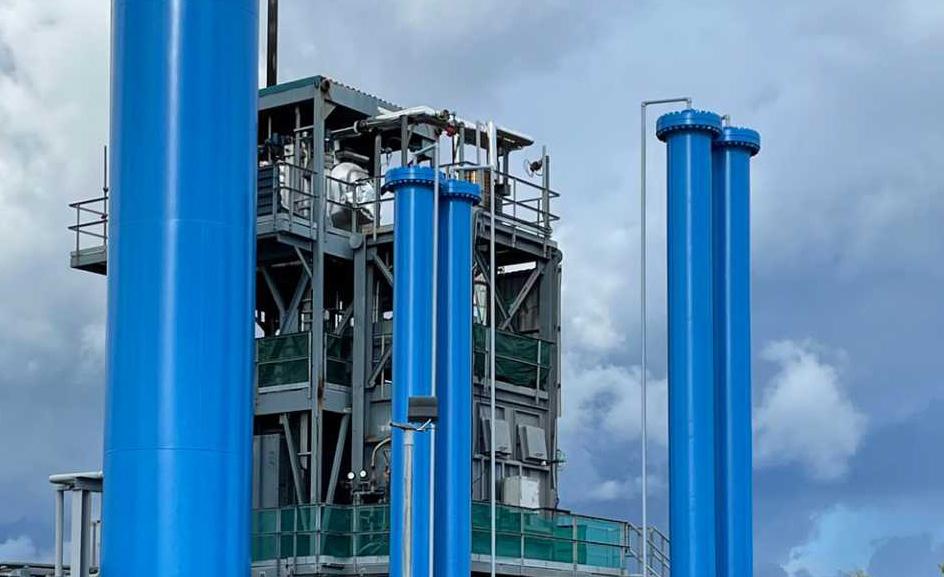
The hydrogen filling station, which is expected to be onstream in Spring 2023, will make an additional 1.5 tonnes of fuel-cell-grade hydrogen available daily to serve the transport and energy transition market, with capacity to serve a fleet of 100 buses or 50 trucks.
Manish Patel, Air Products’ UK hydrogen for mobility director, explains: “At Air Products, we are working with commercial partners and governments in the UK and around the world to drive the energy transition.
Air Products has made an industry-leading commitment of at least $15 billion to clean energy transition megaprojects to ensure when governments or industries want to make the switch to clean hydrogen, they will know they have a reliable and secure supply.
“With many countries looking to secure more diverse energy sources, hydrogen presents an opportunity to provide fuels that are lower-carbon and more secure. The production assets and infrastructure required also offer a major source of economic growth.

“Air Products already has multi-million pound hydrogen projects under construction in the UK, and are actively seeking future investment opportunities. We recently announced plans to bring the first largescale, green hydrogen production facility to the Port of Immingham, UK, together with Associated British Ports, as well as plans for the UK’s largest blue hydrogen facility.
“We look forward to continuing constructive dialogue with the Government on how the benefits arising from these investments may be brought forward quickly.”
The Independent Publisher Awards are recognition of the businesses, teams, and individuals who have made a true difference in the independent publishing community. They took place on 25 November in London.

The judges said: “The organisers of the event sparked a genuine interest with their attendees, and their approach helped secure widespread interest from national and local broadcast media.”
Zap-Map’s annual survey of more than 4,300 EV drivers has revealed that 20 per cent would be prepared to share their home charger with other EV drivers.
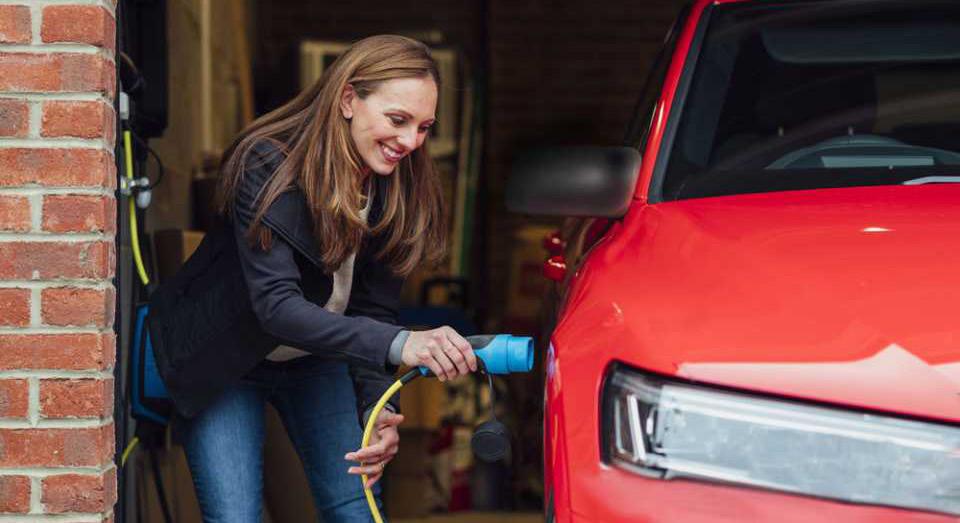
Following this, Zap-Map users now have the ability to find and book JustCharge chargers directly through the Zap-Map app.
The partnership, which aims to make EV charging simple and accessible, means that a total of 1,600 bookable JustCharge locations are now available on Zap-Map.
With 62 per cent of Brits citing concern over charging infrastructure as a barrier to buying an EV, this next step in community charging will not only provide thousands of additional charging locations to complement the public charging network, it also offers an ideal solution for the 40 per cent of UK drivers unable to charge at home, who can simply book onto a neighbour’s charging point, giving them confidence to make the switch to an EV. The new partnership will also benefit the homeowner. With the typical home charging point not being used for 90 per cent of the time, JustCharge hosts can bring in additional household income, helping to offset the costs of buying an electric vehicle.
In addition to the Zap-Map and JustCharge customer base, charging spaces will also be visible to the tens of thousands of drivers who already use JustPark for EV parking.
READ MORE
Twenty per cent of EV drivers willing to share their home charger
Zap-Map has released its annual public charging network satisfaction rankings, with Fastned and MFG EV Power – two ultra-rapid charging networks – coming in joint first place.
Now in its fifth year, the league table comes from Zap-Map’s annual EV charging survey conducted in September 2022. The survey saw record responses from more than 4,300 EV drivers.
As part of the survey, respondents rated their overall satisfaction for the networks they use regularly, which is then used to rank each network out of a maximum of five stars. They also rated their level of satisfaction with the networks in five key areas: reliability, ease of use, customer support, value for money, and payment options.
In joint-first place overall this year are two ultra-rapid networks, Fastned and MFG EV Power. The two networks – which both provide hubs with multiple chargers at each location – scored particularly highly for reliability and ease of use, and they both secure the ‘Best EV Charging Network’ badge.
Taking third place this year is rapid network InstaVolt, while Connected Kerb and Osprey come in joint fourth – meaning all three networks earn the ‘EV Driver Recommended’ title. This year there are six new entrants to the league table. European operator Fastned, which has recently been

expanding its UK charging network, has opened a handful of ultra-rapid hubs this year – and enters the list in joint-first place.
On-street provider Connected Kerb is in joint-fourth position, after rapid growth this year has seen its network expand to more than 1,000 chargers. ZapPay partner Mer also makes the league table for the first time, coming joint-seventh alongside Pod Point and ubitricity.
Be.EV, VendElectric and Dragon Charging are new entrants to the league table too, coming in at joint-10th, joint-12th, and joint-15th respectively.
It is also worth highlighting that ChargePlace Scotland – which holds joint-12th place overall – takes first place for cost, thanks to many of its extensive network of charge points currently being free to use.
Significantly, two networks to have slipped down the table since last year are GRIDSERVE Electric Highway and GeniePoint. From joint-fifth last year, GRIDSERVE Electric Highway now comes in at joint-10th, while GeniePoint has dropped from 11th place last year to 19th position overall. The two networks, which both operate a large number of chargers across the country, came lower down in terms of reliability than last year – an area both operators are working hard to improve upon.

Rarely a day goes by without some representative of the automotive media calling for the urgent construction of more EV recharging infrastructure, often suggesting that the insufficiency of chargepoints is – or will be – holding back vehicle uptake. While we certainly need to continue to invest in and build our charging network, the narrow focus on the total number of chargepoints misses fundamental questions around capacity and utilisation of the hardware. Chargepoints come in many forms and increasingly sophisticated and powerful shapes and sizes. ZapMap’s latest statistics for numbers of ‘slow’, ‘fast’, ‘rapid’ and ‘ultra-rapid’ chargers show that approaching half (40 per cent) of the capacity available to vehicles (in terms of kilowatts of power) is provided by just six per cent of chargepoints; specifically the 2100+ ‘ultra-rapids’ now available. For comparison, public ‘slow’ chargers deliver only five per cent of the charge capacity currently.
Overlay this potential capacity with the typical utilisation of different chargepoints and, based on a nominal 25kWh charge (the average energy delivered as reported in recent Mina data), we see that an on-street ‘slow’ chargepoint may only service two vehicles per day while an ‘ultra-rapid’ could service up to 140 in the same period.
Under the Alternative Fuel Infrastructure Regulation (AFIR), the European Commission proposes that there will need to be 1kW of public charging capacity per registered battery electric vehicle in each country (and 0.66kW per PHEV). Analysis by the ICCT suggests this level is appropriate for a mature EV market with 15 per cent or more of the vehicles with plugs, but higher targets are necessary whilst the infrastructure and parc are both developing. The UK’s charging network capability currently exceeds this level but, of course, with rapidly growing numbers of BEVs entering the parc, it’s vital that installed charging infrastructure keeps pace. (It should also be noted that the EU’s proposal falls some way short of what the European car industry association, ACEA, currently says is necessary – 3kW per BEV.)
While the number of chargepoints in the UK has increased only 17 per cent in 2022 year-to-date, their throughput capacity has increased 35 per cent. Another indication that relying solely, or mainly, on chargepoint numbers could lead to the setting of unhelpful or misleading targets.

Through our work at Zemo with the EV Energy Taskforce, we know Government and regulators are rightly focussed more on ensuring that installed chargepoints are available; working (where appropriate with ‘smart’ capability); accessible and easy-to-use, and less on the ‘headline’ number of chargepoints installed. We support this need to focus more on appropriate (typically locationdetermined) capacity and usage models for the infrastructure to ensure it supports the transition. But ’sweating the asset‘ through incentives to encourage sharing and the optimal utilisation of existing chargepoints – through initiatives like CoCharger and ChargeBnB – can also help to reduce the numbers of chargepoints required to service the full EV fleet. This is critical since we already know underutilised assets often get forgotten and fall into disrepair.
In summary, if we’re to deliver the most efficient and effective infrastructure for tomorrow’s zero emission vehicles, we shouldn’t be getting too hung up on statistics like the total number of chargers installed but focus more attention on a range of other indicators to ensure that EV drivers are getting what they really need and that we’re optimising their use. When it comes to chargepoints size does matter but how effectively you use them is even more important!
www.zemo.org.uk
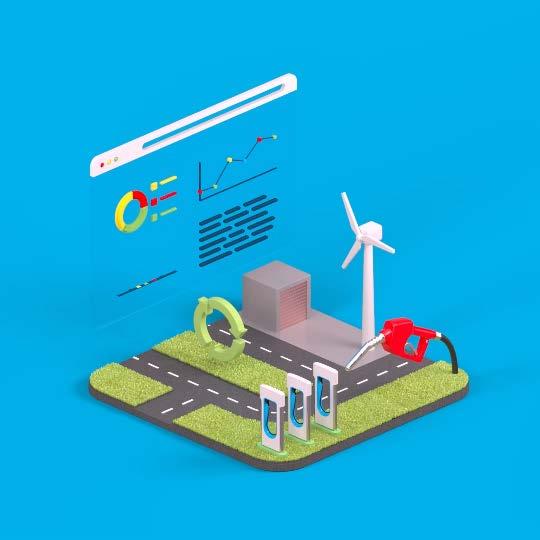
James Lancaster, chair of the Urban Mobility Partnership, explains why grey fleet reduction should be incorporated at the heart of clean air, environmental and transport plans, and how it can be done
There is a major role for local authorities and businesses to play when it comes to changing and decarbonising corporate travel and commuting practices, such as grey fleet reduction.
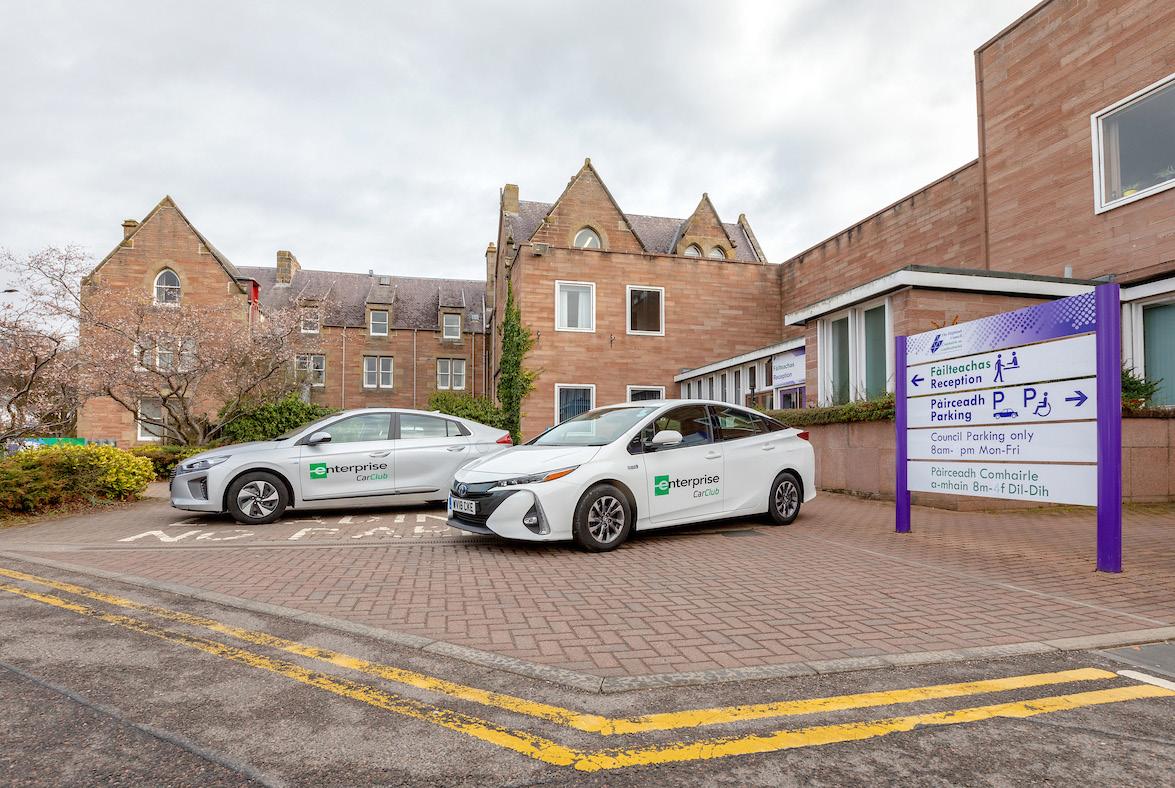
The term “grey fleet” describes any personal car or van, owned and used by an employee, for business travel, which is then reimbursed at a rate per milage back to the employee.
Traditionally, grey fleet is used by public sector bodies and local authorities, but private sector also makes use of the system.
Grey fleet usage is normally reimbursed at varying rates. Despite the Approved Mileage Allowance Payments (AMAP) system advocating that employees are reimbursed at 45p per mile for grey fleet usage, sometimes this figure is as high as over £2 per mile.
Grey fleet usage presents clear challenges focused on environmental concerns, high costings from the public sector bodies, and duty of care. Furthermore, the reimbursement model actively encourages private car usage, and is then regarded as a salary perk or additional benefit by the employee.
During Covid-19, the usage of private cars increased due to some of the government’s messaging
around shared and public transport during the pandemic. Now that we are entering a “post-Covid” world, it is vital that these habits do not become permanent, and that other options – such as shared, active and multimodal transport methods – are prioritised.
In terms of business travel, although home working and video conferencing have increased in our changed world, there must be a concerted effort to ensure that sustainable corporate travel methods are taken in favour of the private car usage when face-to-face business is happening. Without this corporate travel, commuting and grey fleet usage will continue to present a major environmental issue for public sector bodies and local authorities. The average grey fleet vehicle is 8.5 years old, which makes these vehicles some of the most polluting on the road. Furthermore, the daily commute alone contributes almost 18bn kg of CO2 annually.
The UK Government has set a net zero target of 2050, and many local authorities around the country have their own net zero targets or air quality targets. Some local authorities have implemented clean air zones to tackle pollution, yet continue to offer financial incentives to employees to utilise their own polluting private cars. The UK Government’s Transport Decarbonisation Plan has committed to developing policies that encourage a modal shift in transport,
During theCovid-19, usage of private cars increased due to some of the messaging around shared and transportpublic
which would include reducing private car ownership and usage in favour of public, active and shared mobility options. The use of grey fleet within public sectors – with high reimbursement levels which incentivise the use further – do not align with the UK’s national and local decarbonisation targets or ESG reporting obligations.
Research undertaken by the Urban Mobility Partnership and featured within its recently launched policy paper, Transforming Corporate Travel and Commuting, highlights the significant environmental and financial costs across local authorities. For example, the combined cost of grey fleet for over 400 councils across the UK is more than £170 million. Furthermore, the top 10 councils with the highest financial expenditures spent over £2.5 million each, with the top spending council spending over £4.5 million. This spending only relates to local authorities and not other public sector employers. UMP’s research only shows a small portion of the true extent of grey fleet. Furthermore, the research undertaken by UMP also shone a light on the length of grey fleet journeys taken. Most shockingly, there were some cases of local authorities using grey fleet for particularly short trips – for example, in the case of one local authority, of the 3,065 journeys made by council employees using grey fleet vehicles in one year, over 400 of these journeys were less than five miles, over 130 were less than 2.5 miles, and two were even less than one mile. This highlights how pervasive and engrained the grey fleet
usage is within many local authorities, and the need for a cultural and mindset shift. Across the board through shared public and active travel each of these journeys can be replaced, and in particular, very short journeys could be replaced by walking or cycling.
There are a key number of solutions to grey fleet travel. Most importantly, to reach national and local net zero and decarbonisation targets, corporate travel practices such as these need to be interrogated and shifted. Public sector and local authorities have a role to play in influencing this shift towards shared, active and multi-modal corporate travel, and in incorporating grey fleet reduction at the heart of clean air, environmental and transport plans.
In the case of practical steps that local authorities can do, the most important step is the awareness of the problem of grey fleet and the inclusion of grey fleet reduction as part of all local authorities and combined authorities’ clean air and transport plans. This includes removing the requirement for employees to have access to private vehicles from employee contracts and local authorities assessing the extent of grey fleet within their own practices and offering a suitable choice of sustainable alternatives to employees. For example, this could include local authorities ensure that there’s access to a car club scheme or bike sharing facilities, but also on a wider scale, to ensure that public and private sector are joined up in their development and approach of sustainable solutions.
For example, Derbyshire County Council, in partnership with Stagecoach, recently launched a Smarter Travel initiative which was designed to reduce the environmental and financial impacts of employee business travel. This included Stagecoach reducing corporate bus travel for some council employees and gave employees ticketing discounts. Overall, by giving employees the options of alternative transport usage, this reduces grey fleet and private car as a form of corporate travel and helps the council to meet net zero and decarbonisation targets. Grey fleet usage presents a number of environmental and financial challenges, but there are key changes which public sector bodies and local authorities can take, and a huge number of sustainable and alternative transport options which can be offered in place. Most importantly, local authorities and public sector have a huge part to play in changing their employee mindsets when it comes to transport usage. There is an exciting opportunity for local and national government to work with private sector to offer sustainable alternative corporate travel options. Collaborating to offer employees a wider range of transport methods will result in tremendous environmental and financial benefits for local authorities, and will help to enable a modal shift in transport, beyond the workplace. L
www.ump.org.uk

electrification is acknowledged as a vital step in the energy transition.
At the UN climate conference (COP27), sustainable transport and carbon-free technologies were highlighted as key actionable climate strategies. This year’s COP27 took place amid an international energy crisis, elevating renewable energy and low carbon technologies to the forefront of the discussions. Energy company Vattenfall attend the high-level meetings, represented by its head of sustainability, Annika Ramsköld. She said: “We are one of the founding companies of the First Movers Coalition and have previously committed to increasing our purchases of new technology that makes a difference to the climate regarding fossilfree steel, air travel and truck transport. We have now also made commitments regarding cement and concrete.”
An area of focus for Vattenfall is solving the many challenges of transitioning long-distance transport and shifting heavy industries away from their fossilfuel dependence. Given that these segments contribute some 30 per cent of global emissions, the potential upside is considerable. For transport in particular,
Vattenfall recently delivered 32 fast chargers to Tide Bus in Denmark’s fifth largest city, Vejle. This new project demonstrates how Vattenfall’s unique Power-as-a-Service model – via which they provide both the funding and expertise to help transport companies switch to electric fleets – is accelerating the transition to net zero.
Electricity is the key enabler for all nations – and was much discussed at COP27 –because of its’ ability to deliver energy without creating carbon emissions. For UK businesses which can’t generate their own renewable electricity, importing more clean, green electricity from the grid is an essential part of their net zero strategies.
But, as the UK’s ageing electricity grid was built in the 1960s, increased power from the grid is not always available when and where it’s needed. This is another area in which Vattenfall are offering solutions.
Vattenfall IDNO – an Independent Distribution Network Operator – specialise in securing grid capacity on behalf of clients and use a holistic approach to ensure all existing on-site power is being utilised as efficiently as possible so that clients are not over-paying for what they need.
Vattenfall Network Solutions supports, and invests in, businesses on site ‘private wire networks’ via Power-as-a-Service. This new model can provide a cash injection for business owners as Vattenfall take ownership of their critical energy infrastructure and manage all compliance, regulatory and environmental issues – leaving company owners free to concentrate on their core business. L
network-solutions.vattenfall.co.uk

Transport is one of the highest contributors to greenhouse gas emissions.
Which is why it’s so important for companies with vehicle fleets to play their part in moving to alternative fuels.
As the UK’s largest privately-owned contract hire and fleet management specialist, Grosvenor has helped companies such as Weetabix, Whistl, Tata Steel, Agrii and Glenmorangie Whisky drive down their vehicle emissions.
In fact, our 0Zone team has won awards for its expertise in helping companies

make the transition to ultra-low emission and electric vehicles.
Thinking of adding another petrol or diesel vehicle to your fleet? Talk to us first.
Whole life costs could show that an electric vehicle will be more cost-effective in the long run, and a better choice for our future generations.
As well as company cars and light commercial vehicles, we also have a Personal Leasing team who can help your cash drivers choose a greener car too!
Contact us today to see how we can help you:
Call 01536 536 536 or email us info@grosvenor-leasing.co.uk


The lack of 100 per cent renewable electricity in the grid should not hold fleets back from using electric vehicles. Jacob Roberts, transport policy manager at the Association for Renewable Energy and Clean Technology, explains why
Fleet managers can often be hesitant in switching to Electric Vehicles (EVs) if the vehicles would be using electricity from the grid, as there is no guarantee that the vehicles will be truly zero emissions. When the electricity comes from a 100 per cent renewable source, fleets can be declared to produce both zero tailpipe emissions and also zero well-to-wheel (WtW) emissions. However, using electricity from the grid, particularly when there is a low renewable mix, means that EVs may produce zero emissions at the tailpipe, but not from well-to-wheel. This is because much of the electricity on the grid is generated from non-renewable sources. It is easy, but also incorrect, to assume that charging an EV with electricity from fossil fuel sources makes it no better than using petrol or diesel. Even when electricity from fossil fuel sources is used to charge an EV, the transmission of electricity, the EV charging process and the EV powertrain itself are significantly more efficient than the fuelling and combustion process associated
with petrol and diesel vehicles. This means less energy is ultimately used and therefore emissions are still reduced. Emissions will also be reduced further over time, as renewable electricity generation increases. The lack of 100 per cent renewable electricity should therefore not hold fleets back from using EVs.
Before you even put petrol or diesel into a vehicle, it has already generated emissions through extraction, refining and shipping – in some cases from the other side of the world – which have a significant carbon footprint of their own. Alternatively, electricity gets from source to destination via an efficient transmission and distribution network, with comparatively minuscule losses. This means that, even if the energy ultimately comes from the same fossil fuel source, using electricity to power vehicles is more efficient than combusting petrol or diesel. This greater efficiency contributes to less energy needed per vehicle mile and, in turn, fewer emissions per mile. Electricity
is transmitted more efficiently, used more efficiently and therefore is lower emissions, even if it is from the grid. Even if you continue to rely on the grid, the grid mix of renewables is continuing to increase, and EV emissions will decrease further and further as time goes on, through ongoing commitments to net zero. Fleets looking to reduce their emissions should not hesitate to purchase and operate electric vehicles. Doing so will reduce well-to-wheel emissions from day one and, if fleets can then source renewable electricity in the future, they can reduce the emissions further, potentially to zero.
What are the different options for fleet operators to access renewable electricity?
In most cases, fleets can access renewable electricity by entering into a renewable tariff with their energy supplier. A number of suppliers offer 100 per cent renewable energy tariffs and these are the simplest way to reduce emissions from EV charging. Other suppliers, including Octopus E
Written by Jacob Roberts, transport Policy manager at the Association for Renewable Energy and Clean Technology Road to ZeroElectricity is moretransmitted efficiently, used more efficiently and therefore is lower emissions, even if it is from the grid
The most efficient combustion engines available today have a fuel efficiency of around 40 per cent, meaning they can convert only 40 per cent of the fuel energy into movement, with the other 60 per cent lost as heat. EVs, by comparison, are around 80 per cent efficient.
Energy, also provide time-of-use tariffs that make it cheaper for fleets to charge electric vehicles overnight when energy demand and costs are lower. The number of energy suppliers offering time-of-use tariffs is expected to grow in the coming years.
From a fleet perspective, it is particularly useful if vehicles are based at the depot, because you can then have one negotiated electricity supply to charge vehicles overnight when they are not being used. However, services are also available that allow fleets to manage the recharging of EVs that are kept at drivers’ homes overnight.
On a smaller scale it is common for charging hubs to micro-generate renewable energy onsite, often using battery storage to store renewable electricity when it is available so that it can be used as and when it is needed. Installing solar panels and/ or battery storage to support EV charging infrastructure also offers further benefits that are not always directly apparent: Firstly, the renewable electricity that would be generated and stored does not need to solely
be used for vehicles – it can just as easily be used to power other business operations, potentially saving quite a lot of money.
Secondly, battery storage can reduce the peak load on the grid. Banks of several chargepoints can create hundreds of kilowatts of additional electricity demand. This can often result in significant costs associated with reinforcing the local electricity network – although the exact costs vary from site to site, depending on the strength of the local electricity network. By using battery storage, some of the additional power demand can be avoided, as batteries can be charged slowly over a long period of time and then discharged quickly to recharge vehicles without putting any additional strain on the grid. Battery storage does not come cheap but, in some cases, the cost to deploy battery storage will be lower than the costs to upgrade the local electricity network to provide a more powerful grid connection.
Another effective option that is becoming popular to operators of multiple, high-powered EV chargepoints is entering into agreements
with local renewable energy providers, establishing what is known as a private wire connection to a local energy generator. There is a recent case study for this, outlined below.
The Energy Superhub Oxford (ESO) is a partnership between Pivot Power, Fastened and Oxford City Council, which has delivered a high-power charging hub at one of their park and ride sites. This hub is directly connected to a Pivot Power battery storage system which stores renewable energy and then provides directly to their charge points via a private electricity wire. That same battery storage system also provides electricity directly to Oxford City Council’s fleet, therefore their vehicles have been proven to be completely zero emission WtW.
The charging hub offers fast to ultra-rapid charging for 42 vehicles at once, all powered entirely by renewable energy. It brings together three different chargepoint operators at one location, and has been designed to cater for all needs, so that drivers can charge and be on their way in minutes, or while they visit the city centre and go about their day.
The site is directly connected to National Grid’s high voltage transmission network at Cowley substation via a four-mile underground cable. This means the site has 10 MW of installed capacity on site, and can scale up with EV adoption to provide charging for 400 vehicles, without putting additional strain on the local electricity network or requiring costly upgrades.
It’s innovative business model has meant that Energy Superhub Oxford scooped the prize for Charging Destination of
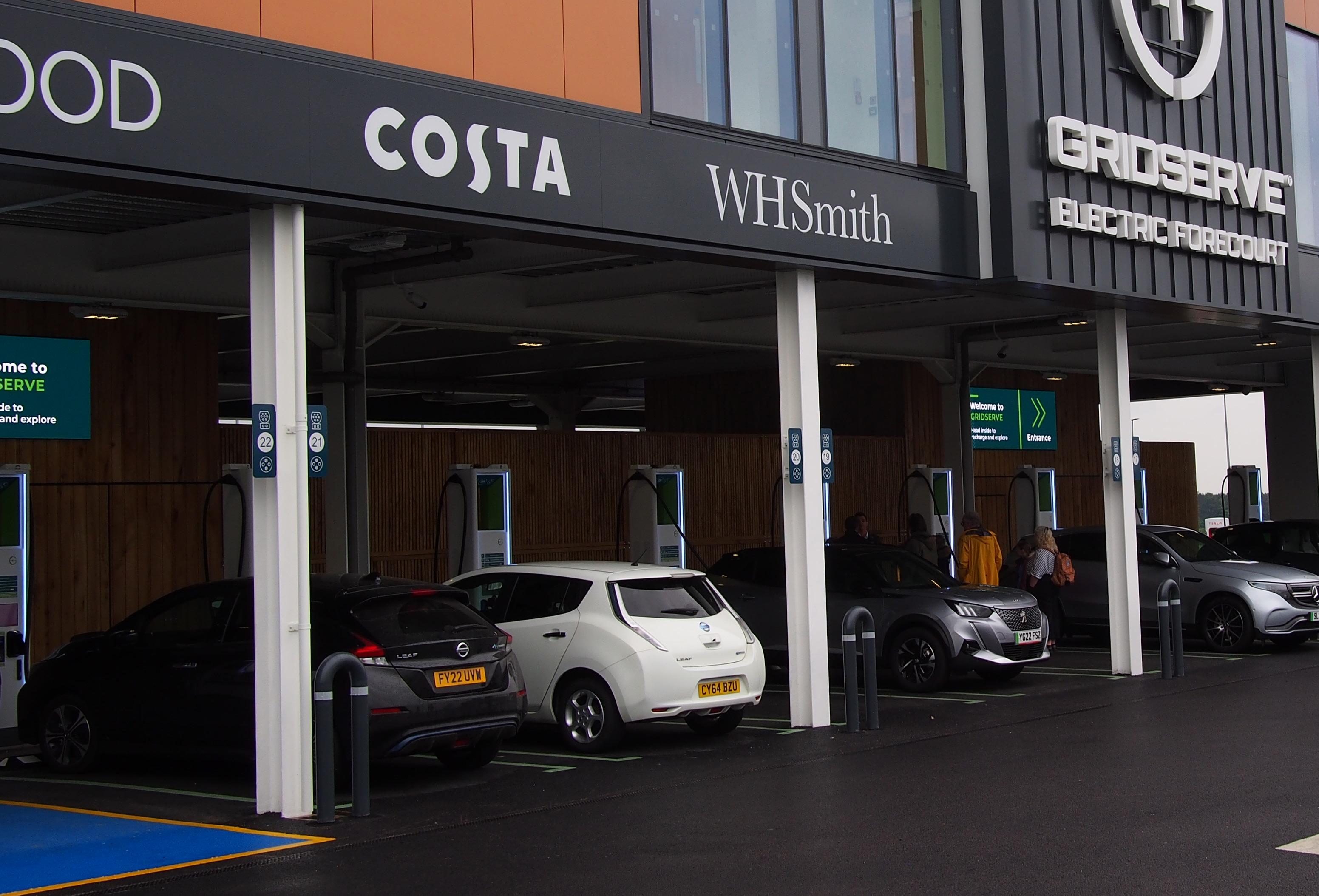
the Year at the EVIES, a prestigious industry award celebrating innovation and excellence in the electric vehicle industry.

Commenting on the win, Tim Rose, Programme Manager for Energy Superhub Oxford at EDF Renewables said: “To tackle the climate emergency and achieve net zero we urgently need to transition to cleaner modes of transport. Electric vehicles are part of the solution, but drivers need confidence that they’ll be able to charge quickly and conveniently, whatever their circumstances. The Oxford superhub is pioneering a new model for EV charging that can meet demand today and in the future. We’re delighted for everyone involved that it has been recognised with this fantastic award.”
The Energy Superhub Oxford is a great example of how fleets can work with renewable energy developers within wider projects to implement private wire agreements.

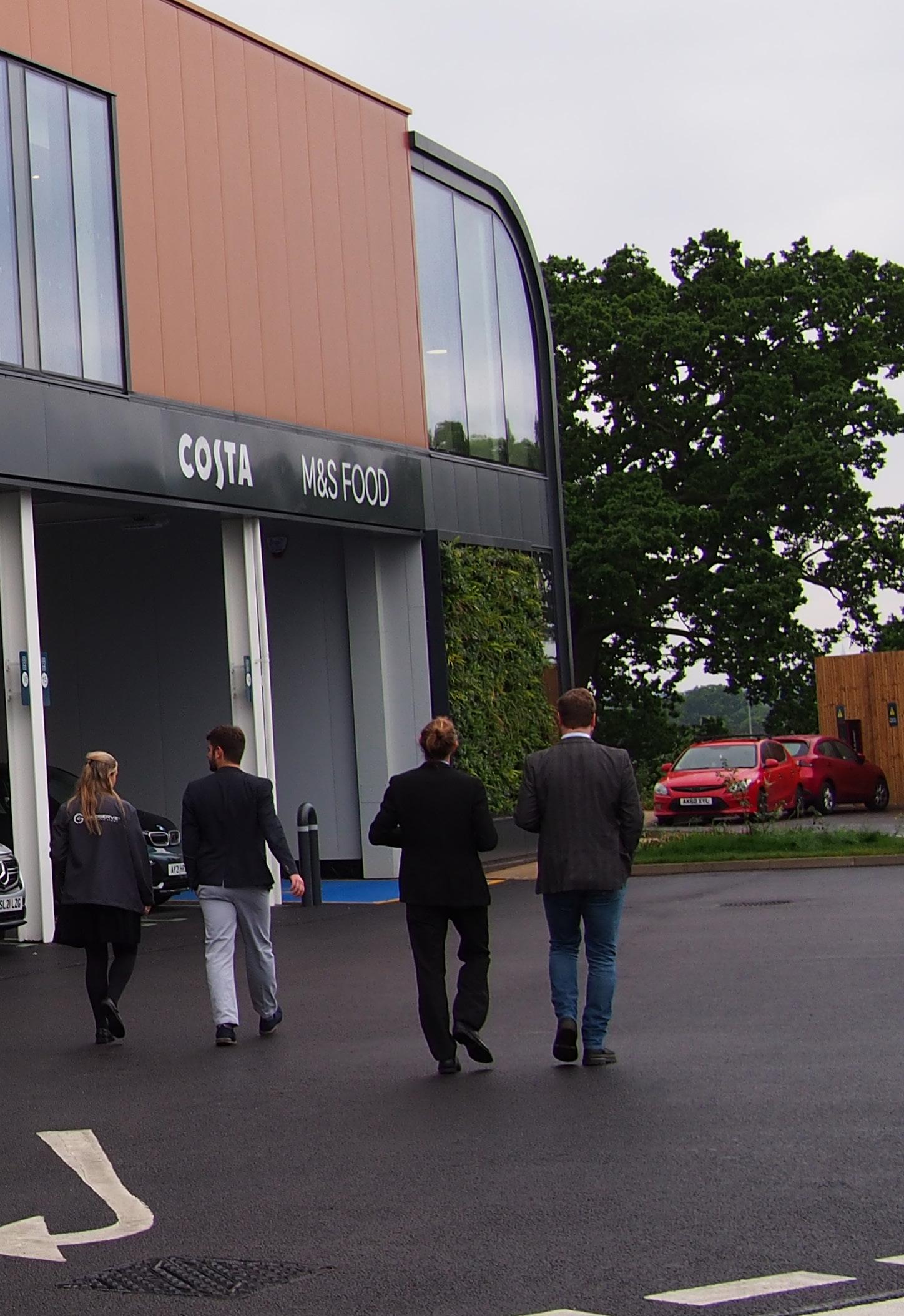
Another excellent example is Gridserve’s Sun-to-Wheel ecosystem, which is a way of distributing zero carbon energy to their UK-wide network, ensuring every kWh of energy used across the Gridserve Electric Highway is replaced with a kWh of net zero energy –giving all EV drivers a reliable source of sustainable charging.

Gridserve currently has two Electric Forecourts, one in Braintree, Essex and one in Norwich, Norfolk where they have created large-scale hybrid solar farms to provide and operate their own electricity. That electricity is safely stored on site in battery storage, building up a massive supply of clean energy to support the grid when the sun goes down – which is then used to power vehicles. These vehicles are still connected to the grid, in case of a huge spike in demand that completely emptied the batteries of all that solar electricity meaning they could still continue charging vehicles. But largely, the on-site solar farms and the battery storage means that all charging will be zero emissions.
At the REA, it is encouraging to see more and more solutions coming to market to make electric fleets accessible. Cleaner, greener mobility is on the rise, and it is important to be aware of the many different options available. L
Sometimes products or services grow suddenly in popularity. But within the fleet sector, it’s hard to recall an occasion when a funding solution grew at such speed.
Yet, that’s precisely what is happening with Salary Sacrifice which is growing at such rapid pace it makes sense for those in finance, HR and fleet to find out what all the fuss is about!
The rapid growth is all due to the very low Benefit in Kind tax (BIK) on Electric Vehicles (EV), that has resulted in Salary Sacrifice becoming the cheapest method by far to source an EV.
Put simply, if an employee decides to sacrifice a portion of their salary in exchange for an Ultra-Low Emission Vehicle (ULEV) or EV, the amount of Income Tax and National Insurance contributions they pay will reduce.
Their employer then provides the employee with a fully funded, maintained and insured vehicle, on which the employee pays very low Benefit in Kind (BIK) tax, providing an immediate saving compared to funding it through a personal lease.
The employer gains by making Class 1A National Insurance savings as well as offering an additional staff benefit, at no extra cost.
Grosvenor Leasing’s Salary Sacrifice scheme also comes with industry leading risk protection; for instance if an employee leaves the company or goes on extended sick or maternity/paternity leave.
Through a 10 – 15 minute consultation we can quickly help you identify whether Salary Sacrifice is something worth taking a closer look at for your business.
Why not get in touch and book in some time with one of our experts, with no obligation whatsoever. L
A lack of available electric vans has been one of many reasons cited by commercial vehicle operators for not going electric. Yet the quickly expanding range of electric models means the time has come for transport managers to have their electrification road map in place
“Their innovative thinking has helped speed up the process of us moving into electric vans and makes them a very deserved winner of our supplier of the year award in 2022.”
When it comes to future-proofing your charging strategy, Steve offers more guidance to commercial vehicle operators.
The financial argument is strong. The savings achieved on maintenance alone can be as much as 35 per cent on a EV van compared to its ICE equivalent, and van grants remain available, with a small van grant at a maximum of £2500, and a large van up to a maximum of £5000.
Electric van considerations But what should light commercial vehicle operators be considering when it comes to electrification? According to Steve Beadle, head of 0Zone at The Grosvenor Group, the UK’s largest privately-owned contract hire and fleet management specialist, there are some quick wins to get the ball rolling as well as considerations for the longer-term.
“Many van operators are under so much pressure to meet customer demand and fulfil their contractual obligations that they cannot imagine how electric vans could support their needs,” said Steve.
“Vehicle uptime is a key priority, with concerns about the speed at which a commercial vehicle can charge on the public network and the level of potential downtime caused by poor range and a lack of charging infrastructure.
“When advising our commercial vehicle customers, we appreciate that these are very real concerns, however we begin by identifying any possible quick wins to start the transition to EVs.
“Local logistics and route analysis come into this; mapping out where electric LCVs could be used within a tighter radius and which routes could offer the best support in terms of charging during periods of natural downtime –for example, overnight or during work breaks.
“We also look carefully at how each company is using its LCVs, including what the function of the vehicle is, what it carries and its daily mileage. There is a big difference between a delivery vehicle which is constantly on the move, to one which is effectively a mobile workshop taking an operative to a location and remaining stationary while a job is completed.
“Using whole life costs, and a wide range of technical and specification data, we can pinpoint which electric vehicles will be most suitable and cost-effective, and work closely with transport managers to make the transition as stress free as possible, with driver engagement, charging infrastructure, delivery KPIs and business objectives remaining a firm focus.”
Grosvenor’s 0Zone team has been offering specialist advice and support for over five years to help companies move to ultralow emission and electric vehicles.
A company that benefited from their advice is Whistl, where Grosvenor developed initiatives to help them move into electric vans as quickly as possible when suitable models became available from the manufacturers.
This was one of the reasons why Grosvenor was named Whistl’s ‘Supplier of the Year 2022’ as part of their supplier conference focusing on ESG (Environmental, Social & Governance).
Gareth Hughes, Whistl’s procurement, property & fleet director, commented, “The team at Grosvenor Leasing has done an outstanding job for Whistl in helping us reduce our vehicle emissions.
“Our advice to companies considering workplace charging is to place real focus on your options for future proofing the groundwork and cabling.
“The speed at which a commercial vehicle can charge will improve significantly in the next five years, and having a ‘dig once’ cabling policy could save thousands of pounds when an upgrade to the hardware may be required.
“Where possible, also consider commercial charge points to support overnight charging, or any other rest periods for that matter. If the work place cannot accommodate charge points or vehicles are taken home by employees, look at providing home charge points for employees, which for Grosvenor’s contract hire customers we wrap up within a vehicle lease.
“Training is also important, as the Government has have extended the LCV maximum gross vehicle weight limit for electric vans from 3.5t to 4.25t on a Cat B driving licence, largely to compensate for the additional weight of carrying the batteries.
“Whilst no specialist licence requirements are needed for the additional weight, there is a five hour training exercise that needs to be undertaken with one of the Government’s recognised members.”
The message, therefore, is that specialist support on moving to electric vans is available and, as well as the environmental reasons for moving to alternative fuels, there are also some clear financial advantages of running an EV van fleet too. L
For more information, call us on 01536 536 536 or email info@grosvenor-leasing.co.uk www.thegrosvenorgroup.co.uk

The largest fleets in the UK continue to lead the EV transition but are facing challenges. Members of the UK Electric Fleets Coalition are urging the government to offer businesses greater detail and funding to reinforce confidence in their EV ambitions
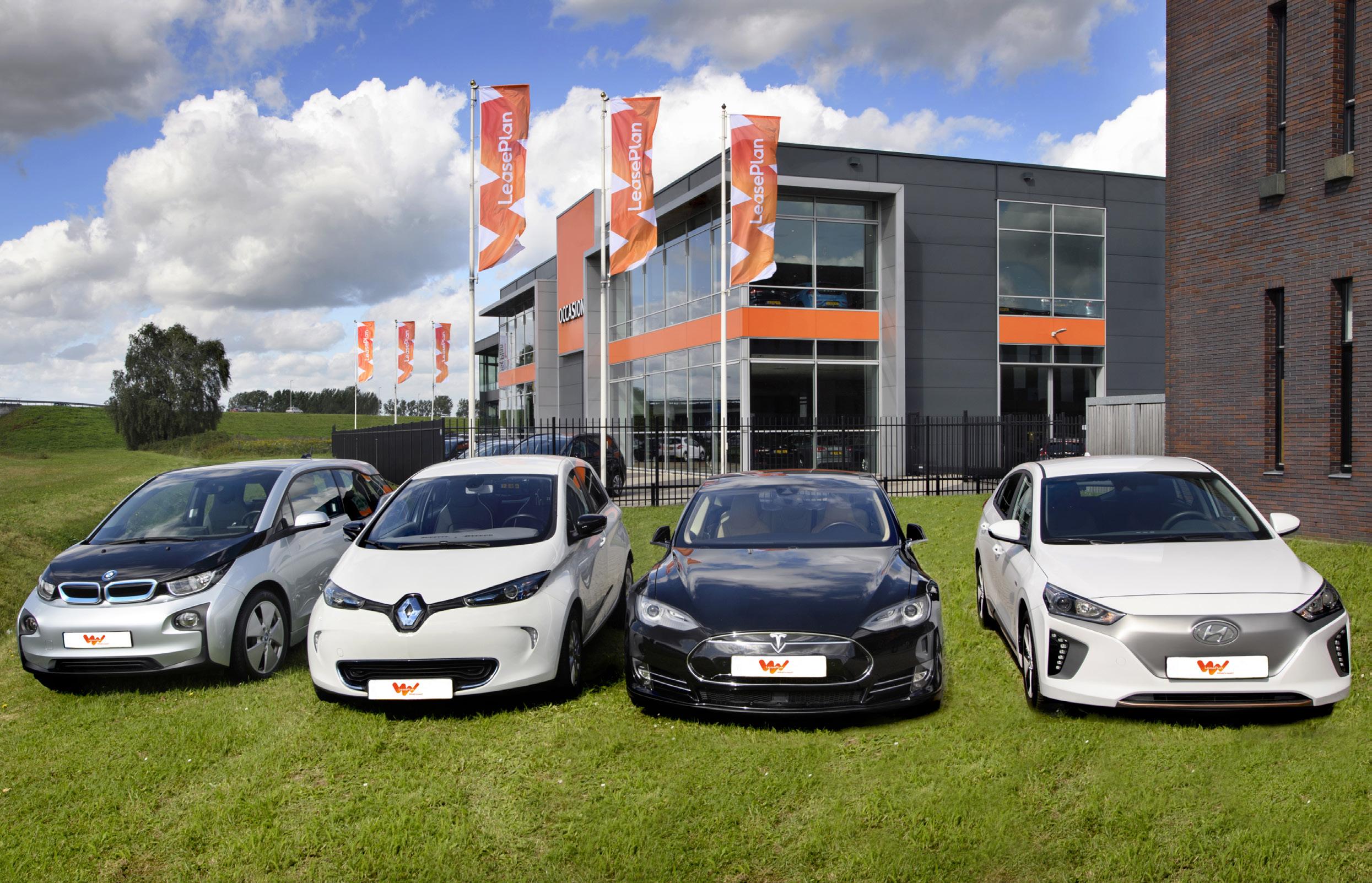
In 2020, Climate Group launched the UK Electric Fleets Coalition (UKEFC) with the goal of increasing UK policy ambition and action on electric vehicles (EVs). This was before the government had set a 2030 phase out date for petrol and diesel cars and when uptake of EVs looked very different.
Government ambition has increased dramatically and has been coupled by a surge in demand for EVs. While momentum continues to build, in extremely uncertain times, continued government support is badly needed.

Recently, the UKEFC sent a letter and policy paper to Prime Minister Rishi Sunak and key ministers in his government, calling for measures that will enable fleets to continue to lead the EV transition in the UK.
Back in 2019 the UK’s EV landscape looked very different. While the demand signal from EV100 members was clear, we needed to see more ambitious targets from government in order to send a message to car makers that now was the time to increase manufacture and supply of EVs to the UK.
We called for the then Prime Minister Boris Johnson to end the sale of new conventional petrol and diesel cars and vans by 2030.
Last year, acknowledging lack of supply of EVs as a key challenge to meeting an earlier phase out date, the group called for, among other measures, a Zero Emission Vehicle (ZEV) Mandate.

Since then, the EV Infrastructure Strategy and the Transport Decarbonisation Plan have helped provide detail on how ambitions will be realised. Meanwhile, take up of EVs has increased across all segments.
However significant challenges remain and the need for immediate and strong action can’t be understated. At the COP27 climate change summit, UN Chief Antonio Guterres stated: “We are in the fight of our lives, and we are losing.”
In the UK, road transport remains the most significant source of carbon
emissions. Meanwhile, air pollution, of which road transport remains the major source, cuts short over 40,000 lives a year, negatively affecting millions more. The technology that will underpin a zero emission transport system is already here and is improving in efficiency and affordability every day. Demand from the general public as well as business fleets, as evidenced by a growing EV100 membership, has never been stronger.
The new Prime Minister needs now to make sure his government delivers on existing ambition. Through targeted support and investment, businesses can enjoy greater certainty – both those that are looking to invest in EVs for their fleets, and for manufacturers making the EVs themselves. In addition to ensuring the vehicles on the UK’s roads are as clean as possible, investment in charging infrastructure, electricity distribution networks and British-based EV manufacturing will create good quality E
UKEFC Signatories are calling on the government to put in place measures to increase the supply ofvehicleselectric
jobs across the country. The measures that will address transport emissions will also place the UK at the heart of the increasingly competitive global market for EVs.
The UKEFC 2022 policy asks UKEFC Signatories are calling on the government to put in place measures to increase the supply of electric vehicles. Lack of supply and choice of zero emission alternatives is one of the leading barriers that is limiting uptake. Exacerbated by ongoing supply chain issues, long lead times, lack of choice (or no option at all for some vehicle types) and lack of availability are challenges that companies face and ones that are particularly acute for commercial vehicles. Due to lack of supply, EV uptake grew by less than the overall market for the first time since the pandemic last month, meaning October is the first month to see BEV market share fall year on year since May 2021. UKEFC signatories welcome the planned Zero Emission Vehicle (ZEV) mandate as a way to help secure supply of EVs to the UK. It is also recognised as an opportunity for the UK to attract additional Battery Electric Vehicle (BEV) manufacturing in the UK. This is a key facet to the UK government’s industrial strategy, although recent announcements have dented confidence. Electric van start-up Arrival has announced that it will scale back its UK operations to instead focus on the US. BMW has stated that it plans to manufacture the electric Mini in China rather than Oxford, and there have also been reports that UK battery start-up Britishvolt is facing serious financial difficulties.
Drive further demand Demand for Zero Emission Vehicles has significantly increased in the last three years. At the end of last year, ZEVs outnumbered diesel cars for new car registrations. Meanwhile, sales of electric vans have almost doubled over the last 12 months, although starting from a far lower baseline. While sales of EVs will clearly continue to grow especially if supply issues are resolved, increasing energy costs and inflationary pressures have affected the Total Cost of Ownership (TCO) for electric cars and vans. UKEFC members are calling for the new government to provide grant certainty for vans. Reductions or restrictions on grant applications should be announced in advance and in consultation.
UKEFC members are also calling for the government to commit to maintain favourable Benefit in Kind (BIK) rates for EVs BIK and increases should be no more than 1% a year between 2024/25 and 2030/31, with no cliff edges. What’s more, the coalition wants the Advisory Electricity Rates (AER) for reimbursing electric company car mileage to remain at 5p per mile, linked to 2021 electricity prices which have more than doubled over the last year. The AER for reimbursing electric company car mileage should be increased in line with increasing energy costs.
A reliable and interoperable chargepoint network
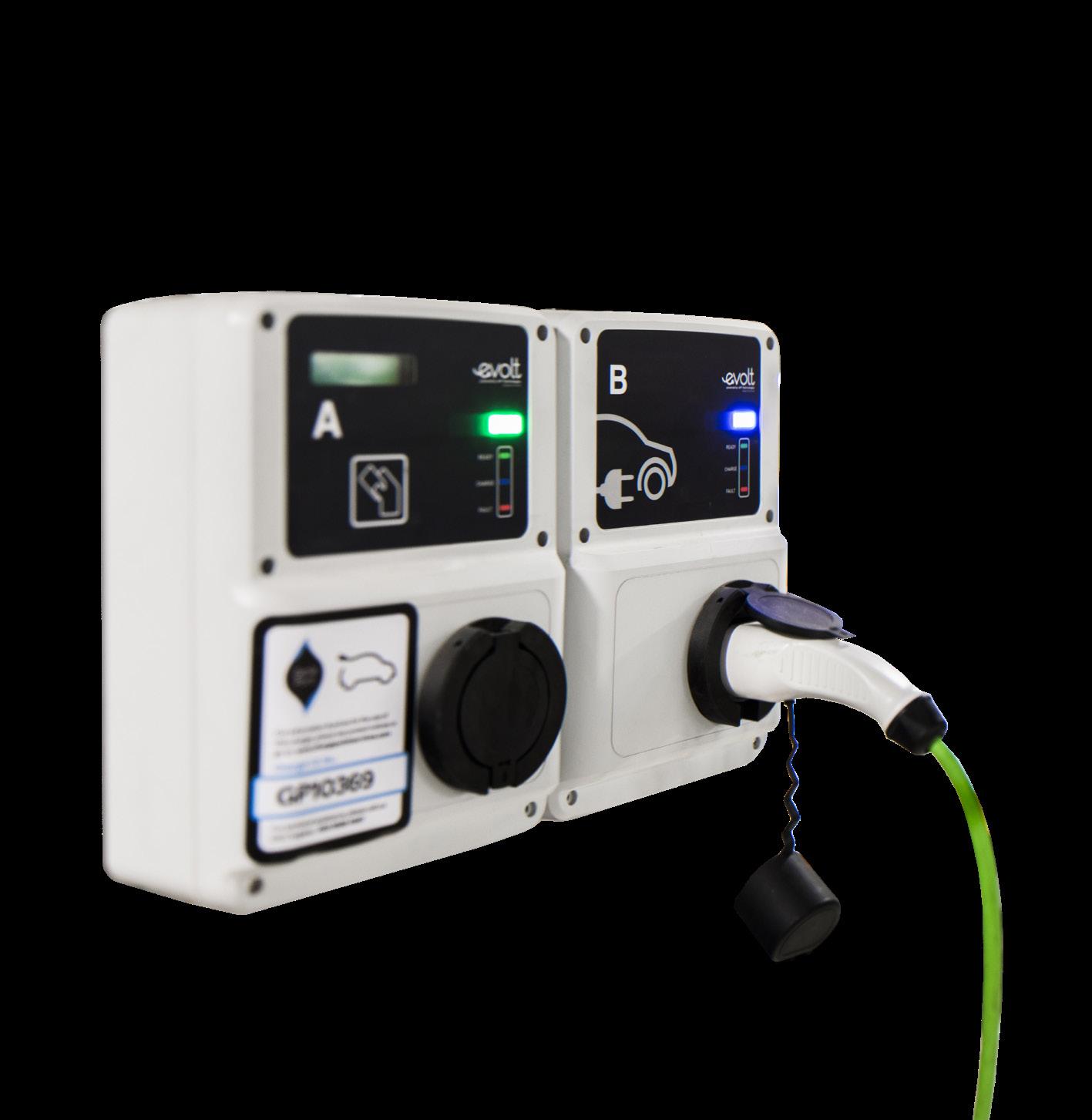

Eighty-two per cent of EV100’s UK-based members say that access to reliable charging infrastructure, both at-home and across the road network, is a ‘significant or very significant barrier’ to EV adoption. In particular, drivers lack options when they do not have access to at-home charging, with public charging infrastructure often being too slow, unreliable, or unavailable due to increasing demand.
OZEV’s recent consultation on a new regulatory framework was welcome, however companies are now keen to see the detail behind this. UKEFC members are calling for the new government to provide greater support for the installation of multiple chargepoints/upgrades to grid connections. A tendering process will help businesses in the near term to offset the cost of upgrading strategic grid connections
The coalition is also calling on the government to provide detail of how national ambition will be locally delivered. The almost £1 billion committed through the Local Electric Vehicle Infrastructure (LEVI) fund and On-Street Residential Chargepoint Scheme are welcome and will provide crucial funding for the coordinated delivery of changepoints across the UK. But we need clarity around
how these funds will be administered. A statutory obligation will empower Local Authorities to plan and deliver charging infrastructure. Local authority access to the Government’s LEVI charging infrastructure fund should be extended from 2025 to 2028. For many van drivers, charging overnight is the only option, yet many don’t have either a private driveway or access to on-street charging options. Changes in planning rules should guarantee the ‘right to plug’ to all those using an electric vehicle through requiring local authorities to install in areas where there is proven current and future demand.

The UK as a world leader in EVs The transition to EVs is well underway and the UK continues to lead the charge. Business fleets have demonstrated the most ambition for several years – both by getting EVs on the road, and by continued efforts to affect positive policy shifts to make this process easier for everyone in the future. The new government now needs to offer businesses greater detail and funding to reinforce confidence in previously stated ambition. L
FURTHER INFORMATION
www.theclimategroup.org
The coalition wants the Advisory Electricity Rates (AER) for reimbursing electric company car mileage to remain at 5p per mile, linked to 2021 electricity prices which have more than doubled over the last year
char.gy, the on-street EV charging network, is taking another step to level the playing fields between electric vehicle drivers with and without driveways by introducing cheaper rates for charging late at night
to level the playing field between public and home charging, the rates would be 25.5p/ kWh at night and 57p/kWh during the day.
Driving for less than 10p per mile Char.gy has structured its Night Saver tariff to make it easy for most drivers to do all their charging in a way that equates to 10p per mile or less. That’s roughly half the cost of driving a petrol or diesel car, according to figures compiled by The RAC.
The bigger picture: more benefits to charging late at night
Besides the cheaper prices for EV drivers, there are more benefits for everyone when drivers do more of their charging late at night.
Launching in December, the company’s new pay as you go tariff called Night Saver, will give these EV drivers the means to manage their charging costs by doing most of their charging at night. This includes working drivers. In char.gy’s most recent customer satisfaction research, 44 per cent of respondents said they used their electric vehicle for professional purposes.
Rising electricity prices drive up public charging costs
It’s hard to have missed the news of the dramatic rises in wholesale electricity prices in the last 18 months. Trouble began in mid 2021 as energy demand began returning to normal levels as economies emerged from the lockdowns. By the end of 2021, wholesale electricity prices had peaked at four times their historic norm. In August 2022, these prices briefly peaked at over 10 times historic norms. Although prices have fallen back, they remain above the level after Russia’s invasion of Ukraine – broadly five to six times long term averages.
By the autumn, public charging costs had risen to an average price of 54p/kWh according to data compiled by Leccy.net. The RAC’s Charge Watch campaign put the average price of charging on rapid chargers
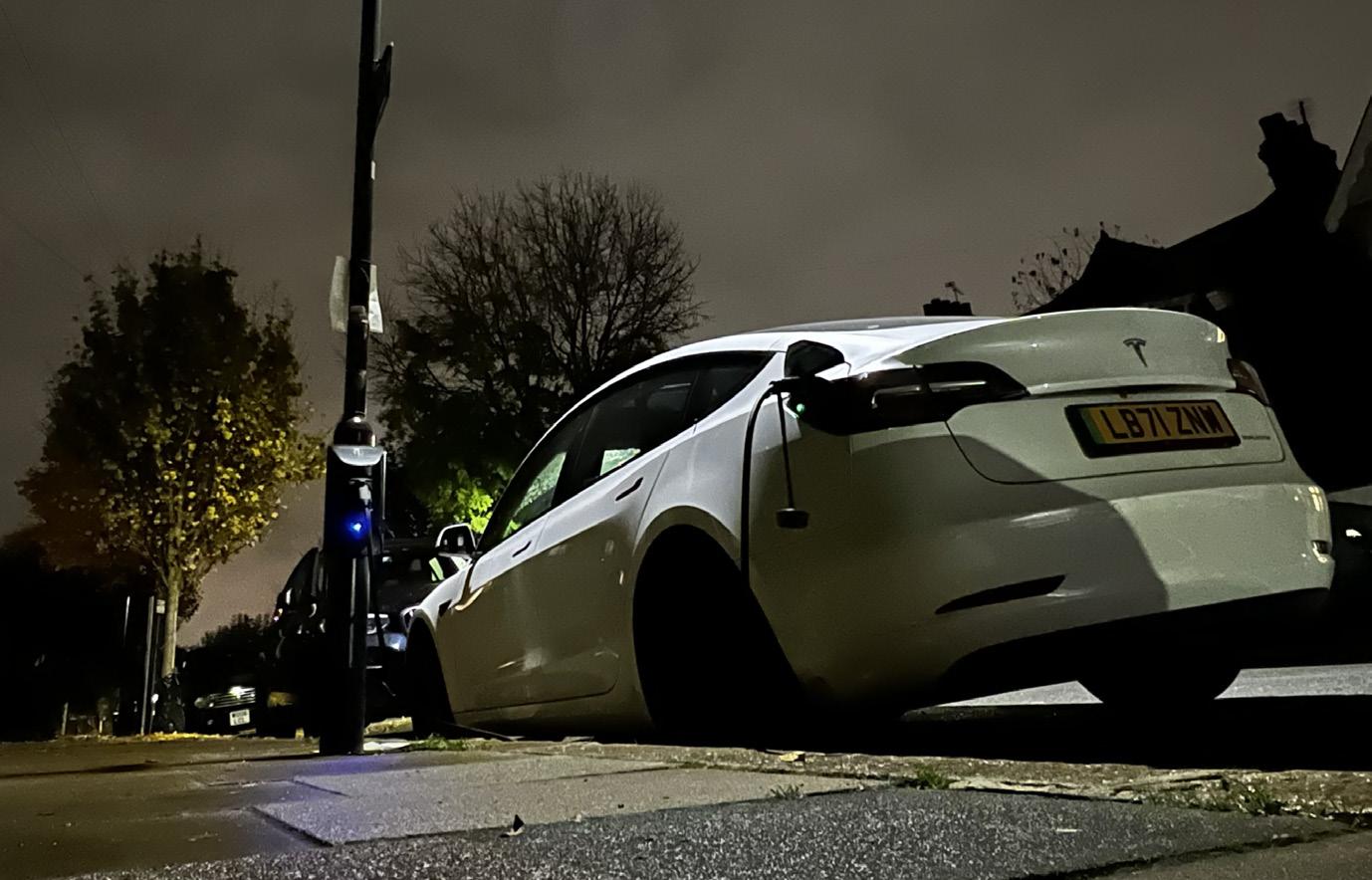
at 64p/kWh – double the average price recorded in March 2021. Some networks briefly raised prices to over £1/ kWh before the Government’s Energy Bill Relief Scheme came into effect.

Char.gy gives drivers better value with Night Saver However, electricity isn’t one price throughout the day. The differences are most notable comparing the expensive early evening period of 4-8pm against off peak times of midnight to 7am.
As the majority of drivers using char.gy’s network are plugged in overnight, the company has restructured its pay as you go tariff to turn this price variation into a benefit for its customers.
With Night Saver, drivers will now pay just 29p/kWh for electricity used between midnight and 7am. This is less than the 34p/kWh that many people pay for their home electricity under the Governments Energy Price Cap.
Charging at other times costs 65p/ kWh – in line with the average cost of charging on on-the-go networks.
These prices include 20 per cent VAT that public charging networks are obliged to levy. If the Government allowed five per cent VAT
Amid concerns of blackouts during winter or how the grid will cope with more EVs in future, drivers help reduce both problems. Timing their charging to start late at night means they will be charging when national energy demand is typically at its lowest. Crucially they will avoid charging their cars and vans between 4pm and 8pm on weekday evenings. That is when national energy demand is at its highest and the grid is under greatest pressure to keep the lights on.
Cleaner energy and cleaner air char.gy buys 100 per cent renewable energy for its customers’ charging. And while the UK’s electricity is increasingly generated by renewables, around half is still made from burning fossil fuels – mainly gas. This problem is normally much worse at peak times – the 4-8pm period on weekdays. The higher national electricity demand is, the more gas and coal fired power stations need to operate to ensure there is enough electricity to go around. When EV drivers charge at low power, away from peak times they help the grid make better use of renewables, and need less gas and coal overall. char.gy CEO, Richard Stobart, said: “During this crucial time, we recognise the frustrating disparity between charging rates for motorists with driveways and those without. The introduction of our new Night Saver tariff aims to provide a solution by giving all EV motorists access to the most competitive rates through our renewables-based charging service.” L
char.gy
Juice Technology AG, manufacturer of charging stations and software, leader in mobile charging stations for EVs, once again pulls an industry-changing innovation out of its hat on Juice World Charging Day

This year’s event was all about futureproofing, ease of use and high-quality aesthetics. The Swiss charging station manufacturer presented its latest highlights at the eagerly awaited industry event.
Melting pot of software and hardware
Clean lines, rounded corners, matt silver and glossy black: the new edition of the Juice Charger me with model number 3 comes in a new look that highlights the family resemblance to the most popular mobile charging station Juice Booster 2 even more clearly. It is now just as resistant as the Booster with IP67 and IK10 and has already received various design
awards in the short time since its launch: the Red Dot Award, the iF Design Award and the Green Good Design Award. The real highlight of the event is the eagerly awaited Juice Booster 3 air. Visually resembling a more compact version of the Juice Booster 2, the 11 kW charging station opens up completely new horizons. Users can look forward to no less than seven functional features. As the first j+ device, the Juice Booster 3 air can be controlled remotely using the j+ pilot app and can be easily updated over the air. It goes without saying that the Juice Booster 3 air is completely waterproof and incredibly robust (IP67, IK10). In addition to the familiar automatic output detection by adapter plugs, new error detections have been added to further enhance safety. For example, the device switches off if the sockets are incorrectly wired or if the vehicle draws more electricity than intended. With these safety features, the smart gadget weighing just 700 grams (without cable) will undoubtedly quickly establish itself alongside the Juice Booster 2 as a mobile alternative to the classic wall-box. Christoph Erni, CEO and founder of Juice Technology AG, says: “The Booster 3 air is
not only significantly more compact now but at the same time even more functional than any other mobile charging station”.
Delivery capability as a competitive edge
“We can deliver” is arguably the most important phrase at this year’s industry conference by the Swiss full-range retailer, given the ongoing supply chain issues around the world. Containers on stage in Munich’s Olympic Park were symbolic of this. Because Juice delivers by container – preferably for the aftersales business and to OEMs. Third on the list of target customers are electricity suppliers and real estate companies.
Daniela Märkl, Head of Communications and PR at Juice, added: “Procurement is a key pillar of Juice’s commitment to sustainability. Juice promotes collaboration with suppliers who work sustainably from a social, ecological, and economic point of view. This is the only way to ensure quality and achieve planning security for everyone involved.”L
FURTHER INFORMATION www.juice.world

Electric vehicles are in high demand and fleets remain committed to bringing them onto UK roads. But if more fleets are to switch to zero emission vehicles, certain barriers must be tackled. The BVRLA’s latest Road to Zero Report Card reveals a snapshot of the progress made
The fleet sector’s journey towards decarbonisation is being impeded by a one-size-fits-all approach to charging infrastructure, according to the BVRLA’s latest Road to Zero Report Card.
Produced as an annual snapshot of the UK’s progress towards a sustainable future, the Report Card considers demand, supply and infrastructure for zero emission cars, vans, and trucks respectively to identify what more can be done to achieve ambitious targets.
The overall picture for 2022 shows that demand from fleets is strong across the board. The car market is benefitting from fiscal incentives, ESG commitments and innovative mobility offerings, while order banks for electric vans are higher than ever, propped up by the Plug-in Van
Grant. From a lower base, demand for zero emission HGVs is also accelerating as firms are giving serious thought into how they can transition effectively.
The landscape for charging infrastructure is improving but continues to trail behind, creating a ceiling that is stopping the high demand from becoming reality.
Widespread investment in the UK’s charging infrastructure has bolstered the opportunities for car drivers. Gaps remain for van operators, with concerns over vehicle downtime and inaccessible chargepoints yet to be addressed.
For HGVs, the Report Card shows that infrastructure is ‘parked’, as a definitive powertrain roadmap still seems some way off. That lack of clarity is reducing confidence in the network and preventing operators from committing to the monumental investment that the move to zero emission vehicles requires.

There is a significant level of ambition across the sector, demonstrated through a rising number of commitments to decarbonise fleets. The UK has the second largest EV100 corporate fleet commitment (636,715)16. E
For fleets outsideoperating large urban areas, create“blackspots”chargingcan issuesoperational
Through its Plug-in Pledge the BVRLA has committed to the registration of 400,000 battery electric cars and vans each year by 2025, across the vehicle rental, leasing and fleet industry. This means it will be responsible for 80 per cent of ZEV sales in the UK, and the industry will own and operate 75 per cent of battery electric vehicles on UK roads. These commitments are translating in purchasing decisions, BEVs accounted for 32 per cent of new additions to the car leasing fleet in Q1 2022, demonstrating a high level of commitment. Salary sacrifice recorded the highest proportion of of BEV fleet additions at 84 per cent, with business contract hire second at 43 per cent.
Despite continued growth in the charging infrastructure, 50 per cent of fleets who have not taken on BEVs cite infrastructure availability as the reason why. Chargepoint numbers are growing rapidly, however, so are BEV numbers and there are concerns that chargepoint growth is not fast enough to keep pace with demand.

For fleets operating outside large urban areas, charging “blackspots” can create operational issues, particularly where fleets have limited downtime, need to top up in the day or drivers do not have home charging.
To remedy these issues, the BVRLA is recommending that local authorities develop their EV infrastructure strategies which acknowledge fleet users and cater for all users and vehicle types. They are also calling for VAT rates to be equalised between home and public charging, and that the government works with local authorities and the fleet industry to develop van-friendly chargepoint standards.

There has been a rise in available charging maps, apps and telematics for route planning. Looking ahead, there is a need for additional and timely information on the availability of chargepoints in use and those not working. While drivers could often find chargers online to travel to or to visit enroute, they did not know if these
would be out of service or in use when they arrived, potentially increasing downtime. The physical challenges for vans is compounded by a lack of available information letting drivers know if the chargepoint can fit a van. OZEV’s Open Data Project is working to resolve these challenges and was welcomed by fleet stakeholders. If this work can open up access to van charging specific information shortly it will be extremely beneficial to fleets. For those committing to the transition, access to chargepoint development information is needed to help fleets identify where charging locations would be in the future. While users have visibility of current locations, understanding what could be accessed in the future would help firms make the shift. Fleets view LAs as having a key role in collecting and distributing this information.
More consideration needed BVRLA chief executive, Gerry Keaney said: “Electric vehicles are in high demand. Fleets remain committed to bringing cleaner, greener vehicles to UK roads and are delivering ambitious strategies to make it happen. The government cannot rest on its laurels by taking that demand for granted. Incentives are making EVs cost effective, with low Benefit in Kind rates on electric company cars accelerating exceptional uptake. Those incentives must remain, otherwise the fragile market will stall in the face of severe economic headwinds. “Investment in charging infrastructure is not simply a numbers game. More consideration needs to be given to the needs of all road users. Fleet operators are ready to lead the
charge but are being left with one hand tied behind their back. The government is beginning to listen to these concerns and we will continue to push the issue until authorities across the country are building infrastructure strategies that fully meet fleet needs.”
In line with the BVRLA’s Road to Zero Report Card, the association has also published its sustainability credentials, showing BEV uptake and Clean Air Zone compliance across different fleet segments. The credentials are continually improving and show how the fleet sector is leading the way in the electrification of the total UK car parc.
For salary sacrifice, 55 per cent of vehicles are BEV; for car clubs, 12 per cent are BEV, and for company cars, it’s 17 per cent. All have seen their proportion of EVs increase vs 2021 figures. In the same period, the number of EVs in the car rental sector has more than doubled (from 0.6 per cent to 1.5 per cent).
The van sector has also made considerable gains from last year, but the overall proportion of the fleet able to go zero emission remains constrained by the supply and infrastructure issues highlighted in the Road to Zero Report Card. 1.8 per cent of the leased LCV market is made up of zero emission vans, up from one per cent in 2021. That has seen the wider van parc grow from 0.3 per cent to 0.7 per cent zero emissions, showing the scope of the opportunity for further progress. L
www.bvrla.co.uk
The overall picture for 2022 shows that demand from fleets is strong across the board. The car market is benefitting from fiscal incentives, ESG commitments and innovative mobility offerings, while order banks for electric vans are higher than ever, propped up by the Plug-in Van Grant.
Although a great many challenges lay ahead on our road to net zero, there is a growing realisation that by working together, we can advance the transport sector’s decarbonisation toolkit. Tech collaborations offer a tantalising glimpse of the potential for new industry innovations that can deliver on our carbon reduction targets
Although the starting gun for the e-mobility revolution has fired, we have just left the starting blocks.
With the future of our planet at stake – and the UN’s recent Emissions Gap Report calling for urgent transformation – we can ill-afford for what must now be a sprint to become a marathon.
The transport sector is at the heart of our ambitions to achieve a more sustainable pathway. And this places a burden of responsibility on all stakeholders – from government and industry to fleet operators and business leaders – to develop solutions that will drive change.
Moreover, with the clock ticking on the future of fossil fuel vehicles, collaboration is paramount.
But there is every reason for optimism. We can already see the decarbonisation of transport and the advancement of the electric powertrain being bolstered by a cooperative mindset – a collective will to deliver on our net zero targets.
There is a buzz of excitement in tech R&D labs, the seeds of entrepreneurship and open innovation are taking hold and we are seeing a growing ecosystem of advice, shared knowledge and guidance that will help shape our mobility reset.
The e-mobility marketplace may remain a competitive one, but with climate change signalling an existential crisis, there is a genuine impetus for partnering.
GreenFleet’s GB EV Rally earlier this year was a powerful illustration of the fleet transport sector’s shared aspirations and its spirit of togetherness. Mutual learning and a collective green vision were the fore of participating teams’ resolve.
From a technological standpoint, collaboration and co-creation have always been important ingredients to successful innovation. Gamechanging solutions rarely develop in silos, rather they are born out of cooperative thinking.
Chief among the voices that should be heard is that of customers – arguably the people who matter most. A tech solution must align with customer needs, and in the case of electrification, help fleets pivot away from conventional ICE (internal combustion engine) vehicles.
Here, Webfleet is taking a leading role, consulting directly with fleet operators and participating in and hosting industry leading events that act as knowledge sharing forums.
This approach is helping steer the evolution of our EV solution, which leverages vehicle data to help fleets make the electric transition, develop their charging strategies, optimise EV operations and realise a lower total cost of ownership.
Oxford Direct Services (ODS), for example, teamed up with Bridgestone Mobility Solutions to support a trailblazing fleet electrification project for Oxford City Council, and has signed up as an official Webfleet research partner. By doing so, it will help shape the company’s ongoing fleet electrification research and development programme.
ODS is using Webfleet’s dedicated EV solution with a vengeance to costoptimise EV utilisation and charging, supporting the council’s commitment to Britain’s first Zero Emission Zone (ZEZ).
Streamlining processes for greener operations
Elsewhere, the power of tech partnering is being demonstrated with the integration of vehicle data with third party solutions, resulting in ever smarter and greener ways of working.
Connected technologies have opened the door to streamlined, end-to-end processes, new ways of informing decisionmaking, optimising operations, reducing costs and improving service delivery.

Business-led interconnectivity has resulted in meaningful integrations between fleet management software and office suites, such as enterprise resource planning (ERP), invoicing systems, routing and scheduling optimisation, supply chain planning and asset management.
Mobile workforces, out on the road, have been metaphorically glued digitally to back offices, and traditional business processes –from company HQs, depots or warehouses to customers – have been transformed, helping reduce UK plc’s carbon footprint.
The world needs practical solutions that can help save our planet, fast.
Although a great many challenges may still lie ahead on our road to net zero, there is a growing realisation that by working together we can advance the transport sector’s decarbonisation toolkit. And where there’s a will.
The aforementioned tech collaborations offer just a tantalising glimpse of the potential for new industry innovations that can expand providers’ market reach, while helping deliver on our carbon reduction targets.
As Thomas Edison famously challenged his staff – “there’s a way to do it better, find it,” Transport’s net zero crusade serves as a great illustration of how cooperation can offer “a better way” to fleet electrification and a more sustainable future. L
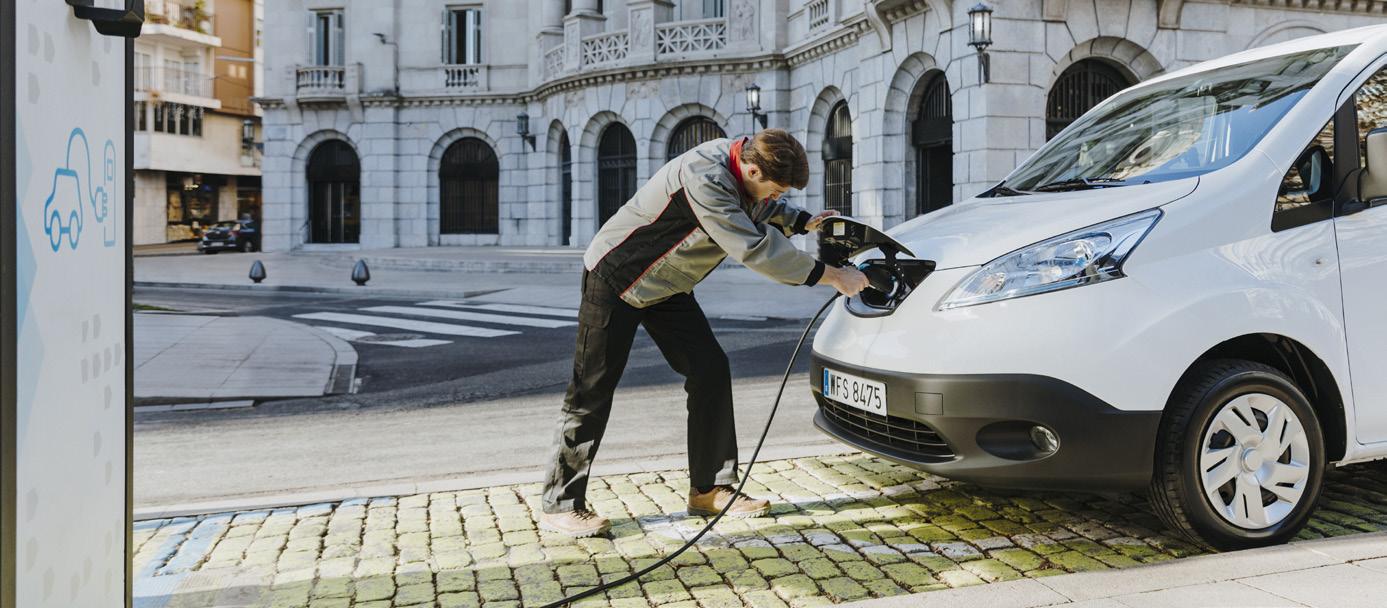
FURTHER INFORMATION
www.webfleet.com
The UK has a target to be net zero emission by 2050, and when it comes to the decarbonisation of transport, electrification plays a central role. But is it the only route? And what happens if electric vehicles are deemed unsuitable? Our panel of experts discuss
Shaun joined Arval in 2000 and leads a team of expert consultants who support clients with operating more cost-effective, safe and sustainable fleets. As head of Arval Mobility Observatory UK, he provides insight on the results of its annual Barometer, a research project that studies, analyses and interprets developments in mobility. He is a regular contributor to fleet publications through press articles, comment and interviews.
Steve Beadle is head of 0Zone, the Grosvenor Group’s innovative and market leading solution to help companies navigate their way smoothly towards ultra-low emission and electric vehicles. With extensive experience of helping companies make the smooth transition to ultra-low emission and electric vehicles, he offers a perfect balance between how fleets can drive down their emissions and the implications of policy setting.
Tristram Benson is joining Engineius from Michelin Connected Fleet, where he was previously director for the Heavy Goods Vehicle segment. His mission is to help Engineius offer customers and suppliers a market-beating service and digital solution. He plans to achieve this by being very close to our customers and suppliers.


When the government released its Road to Zero Strategy, it declared that it would be “technology neutral” and that it would not “speculate on which technologies might help to deliver the government’s mission.”
However, at this stage, the country is mostly geared up for electrification, with significant investments from government and industry to build adequate EV charging networks and incentivise the purchase of electric vehicles.
But what other ways can transport, specifically fleet operations, become net zero?
Steve Beadle, head of 0Zone at The Grosvenor Group, believes it is right to explore multiple avenues when it comes to decarbonising transport. He said: “Whilst we are all gearing up for electrification, there is a growing feeling that electric powered vehicles may not be the ultimate solution for the future.
“It’s hard to imagine how electric vehicles, battery supply and a global charging infrastructure can provide a robust enough transport solution around the world, and ultimately other carbon zero mobility solutions will grow in popularity.
Daniel is part of the Raleigh B2B team with a focus on local authorities and small businesses throughout the UK. He’s passionate about the development of cargo bikes in the UK and is the self-proclaimed cargo bike guru within the Raleigh HQ.


“It’s unlikely that there will be one single approach. Instead we’re likely to see a growth in hydrogen vehicles, a dramatic increase in car sharing and mobility (MaaS) as a solution, thus reducing the need for people to have their own vehicles, and while we are all focused at the moment on going electric, it is likely that EVs will be just one component part of a bigger transport mix in the longer term.
“For the time being however, electric vehicles offer the only truly viable solution for helping businesses and private individuals achieve zero emission motoring.”
Daniel Ainsworth, business development manager in the B2B team, Raleigh Tristram Benson, commercial director, EngineiusArval’s Shaun Sadlier echoes that it’s important to consider all the options when it comes to decarbonising mobility. He says: “Electrification is currently the government’s focus to achieve net zero for transport, however it is important that individuals and companies implement a multi-solution approach to mobility.
“At Arval UK, we follow closely the development of hydrogen as an alternative fuel type, but in the short term, we believe that its use will be focused on larger forms of transport than cars and light commercial vehicles, such as buses and heavy goods vehicles.
“Importantly, employers and their employees’ expectations have profoundly changed in terms of mobility and its environmental impact; they are increasingly looking to make betterinformed choices on their mobility based on its efficiency, cost and very importantly, its environmental impact.”

Tristram Benson, commercial director at Engineius, agrees that it’s right to take a varied strategy when it comes to reaching zero-emission transport. “Technology neutral is an interesting term and can be interpreted in different ways,” comments Tristram. “Given the lack of direction that the public have experienced from the Government in 2022, it would be fair to conclude that this statement is noncommittal. However, I would encourage you to see it in a more positive light.
“To quote Warren Buffet – the world leading investor and billionaire – ‘Diversification is a protection against ignorance’. To diversify
and in business, diversification leads to the reduction of risk.
“In the case of transport achieving net zero, a varied strategy is essential. Electric will work for some operations, whilst hydrogen will work for others. As such, it is key to invest in all green tech, such as the market sees fit. Importantly, this will lead to reduction of risk, we all know the dangers of putting all our eggs in one basket.
“It is a neutral position here, and continued openness to disruptive tech and opportunities which will see the UK continue to lead in this topic globally.”
Using cargo bikes for urban operations and last mile deliveries is another solution in the UK’s decarbonisation toolbox.
Daniel Ainsworth, business development manager in the B2B team at Raleigh, said: “The list of ways businesses are using cargo bikes to become net zero is becoming more prominent daily in the UK.
“By offering trails of e-cargo bikes, companies are testing out how they can fit into their businesses rather than them fitting around it. For example, this year alone, I have seen e-cargo being used for time-sensitive blood bank deliveries in central London and builders carrying building materials for cycle path repairs.
situations that show the tools to help an organisation become net zero are already there; we now need to work to make them fit into the organisation.”
With the UK aiming to bring greenhouse gas emissions to net zero by 2050, and dates in place for phasing out fossil fuelled vehicles, many organisations are making their own commitments to become net zero.
Pledges such as the Clean Van Commitment and the EV100 are public declarations from businesses to eliminate their fleet emissions – and to signal to the government and industry that the demand for clean transport is strong. That said, it can be daunting for some organisations, particularly SMEs that might have restricted resources, limited knowledge, and tight budgets. So for an organisation that hasn’t started its electrification plans, what’s the best way to assess whether electric vehicles are right for their fleet?
Shaun Sadlier from Arval comments: “With the average vehicle lease lasting around five years, 2030 is now less than two renewal cycles away. So now is the time to start implementing electric vehicles. “The work that we have done with hundreds of clients has been to position electric simply as a power choice alongside petrol and diesel for passenger cars on
ZeroRoadThetoStrategy says that the government will be “technology neutral” in its efforts decarboniseto



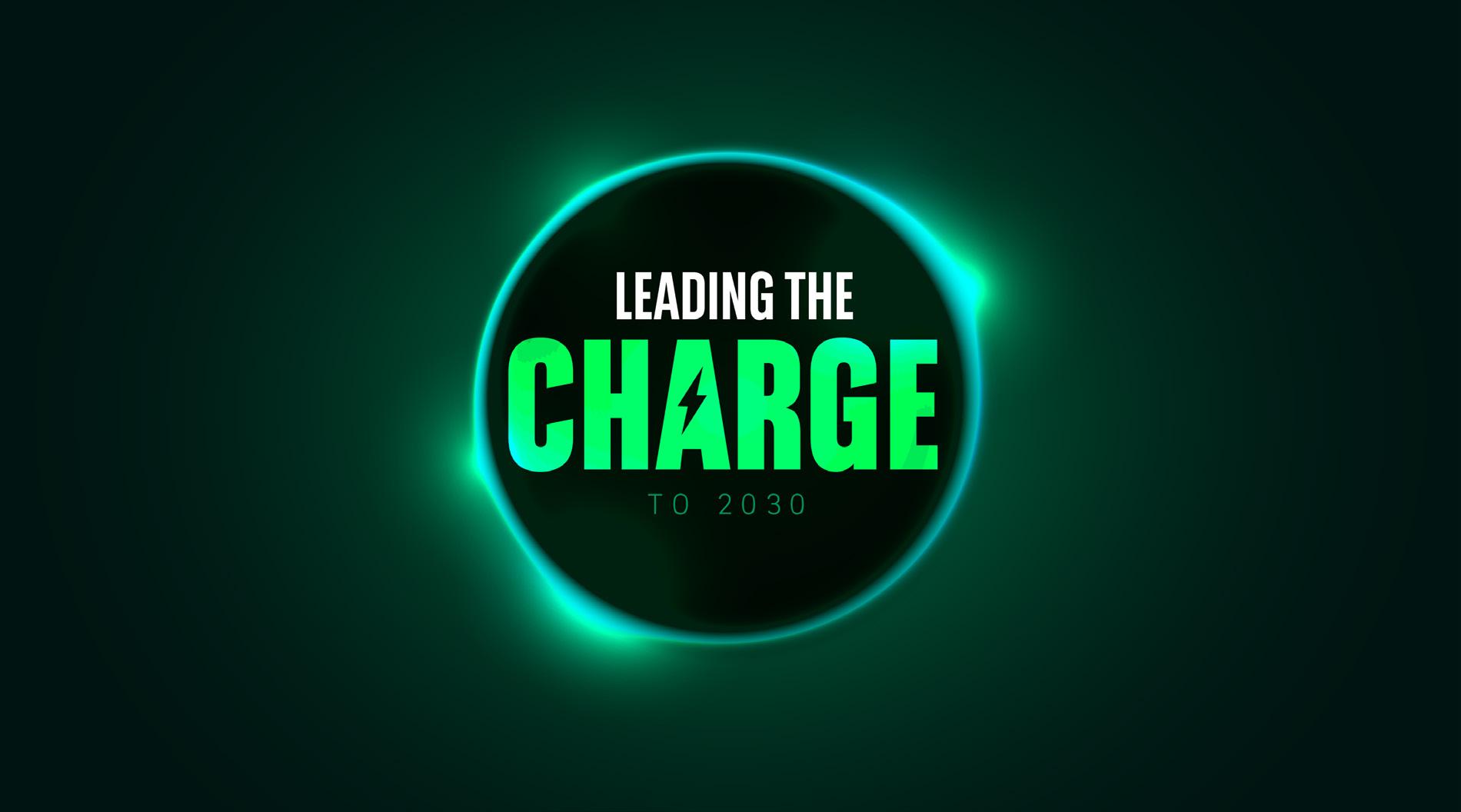






















provide information on what advantages having an electric vehicle has on both the driver and the daily operation of the business. To support customers, we have provided a large number of electric vans on a flexible basis so they can try the vehicles for a shorter period within their fleet.”
Tristram Benson from Engineius believes that changing your mindset and setting your vision are the important first steps when implementing a decarbonisation strategy. He says: “Companies are often too quick to think ‘let’s crunch some data and decide whether it makes commercial sense’. This is how we are trained to make business decisions, so fair enough.
“But, I would encourage you to step back and think of the big picture first. This is not just another project. The environmental sustainability of your organisation will directly affect your ability to do business over the course of the next five, ten or twenty years.
“Of course, in considering whether EVs are right for your fleet, you must also consider whether they make commercial and operational sense. But remember, if you are not willing to make sacrifices or embrace organisational change, it will have drastic implications for your business, long term.”
Steve Beadle from Grovesnor says that for those daunted by electric vehicles, it can be broken down, with the quick wins targeted first. He says: “We do come across a number of companies who are holding back because they can’t see how electric vehicles are going to work for them. But when you sit down and look at their vehicle usage, where their drivers are based, the journeys they’re making, the possibilities of home charging and the extent of the
what they will be driving post 2030. We have also seen many cases where we have demonstrated to drivers who believe they need a traditional petrol or diesel that a plug-in hybrid would be equally viable for them, which acts as a good stepping stone towards them having a full EV.
“Even where businesses have drivers travelling very high mileages, carrying a lot of equipment in their vehicles, or are operating in more remote parts of the country, the 0Zone team at Grosvenor can still map out the possibilities regarding reducing emissions and planning for the ultimate goal of zero mission motoring.
“We’re also now definitely starting to see orders increase for electric commercial vehicles, which shows that electrification rising in this sector too.”
For those assessing if electric cargo bikes are right for their fleet, Daniel
Ainsworth from Raleigh advises that the are asked: “Firstly, do you already use vans within your organisation? Secondly, are these usually kept within 15 miles of their office? Lastly, do you think it would work?
“If you answer yes to all three of these, you definitely should consider the switchover. The best way to do this is to trial an e-cargo option for a one to three month period to see if it works for your organisation.
“This answer has been simplified to consider switching from vans to e-cargo bikes; however, the truth is we are still finding places where this solution is more effective. In the next few years in the UK, it will be interesting to see people’s initiative uses for electric cargo bikes.”

What if EVs are not yet viable? What can be done in the meantime to reduce emissions if organisations decide to wait until electric vehicles become more viable and cost effective, or for other alternative solutions to come on the market?
Steve Beadle from The Grosvenor Group, said: “Where EVs are not viable, this is generally because the type of activities the vehicle is being used for, the journeys it is making, and the geographical area it is being driven in are not conducive to operating an electric vehicle.
“Unfortunately, where this is the case, services such as mobility as a solution are also not particularly viable either, and the priority is typically to give that driver a vehicle to meet their job requirements, lifestyle and be suitable for the area they live in.
“However that doesn’t restrict the possibilities around reducing emissions, because plug in hybrids and very fuel efficient petrol and diesel models can be provided while the battery range and charging infrastructure catches up.
“By using telematics, and monitoring vehicle usage, companies can also improve overall journey planning and, in the commercial vehicle sector, enjoy better scheduling and allocation of vehicles.
“For large, more niche vehicles, a lot of companies we work with are looking E


Transport is one of the highest contributors to greenhouse gas emissions.
Which is why it’s so important for companies with vehicle fleets to play their part in moving to alternative fuels.
As the UK’s largest privately-owned contract hire and fleet management specialist, Grosvenor has helped companies such as Weetabix, Whistl, Tata Steel, Agrii and Glenmorangie Whisky drive down their vehicle emissions.
In fact, our 0Zone team has won awards for its expertise in helping companies

make the transition to ultra-low emission and electric vehicles.
Thinking of adding another petrol or diesel vehicle to your fleet? Talk to us first.
Whole life costs could show that an electric vehicle will be more cost-effective in the long run, and a better choice for our future generations.
As well as company cars and light commercial vehicles, we also have a Personal Leasing team who can help your cash drivers choose a greener car too!
Contact us today to see how we can help you:
Call 01536 536 536 or email us info@grosvenor-leasing.co.uk
at drop-in fuels or biofuels that do not require modifications for the vehicle but are cleaner for the environment. It’s important to be aware, however, that this is not supported by the majority of manufacturer warranties.
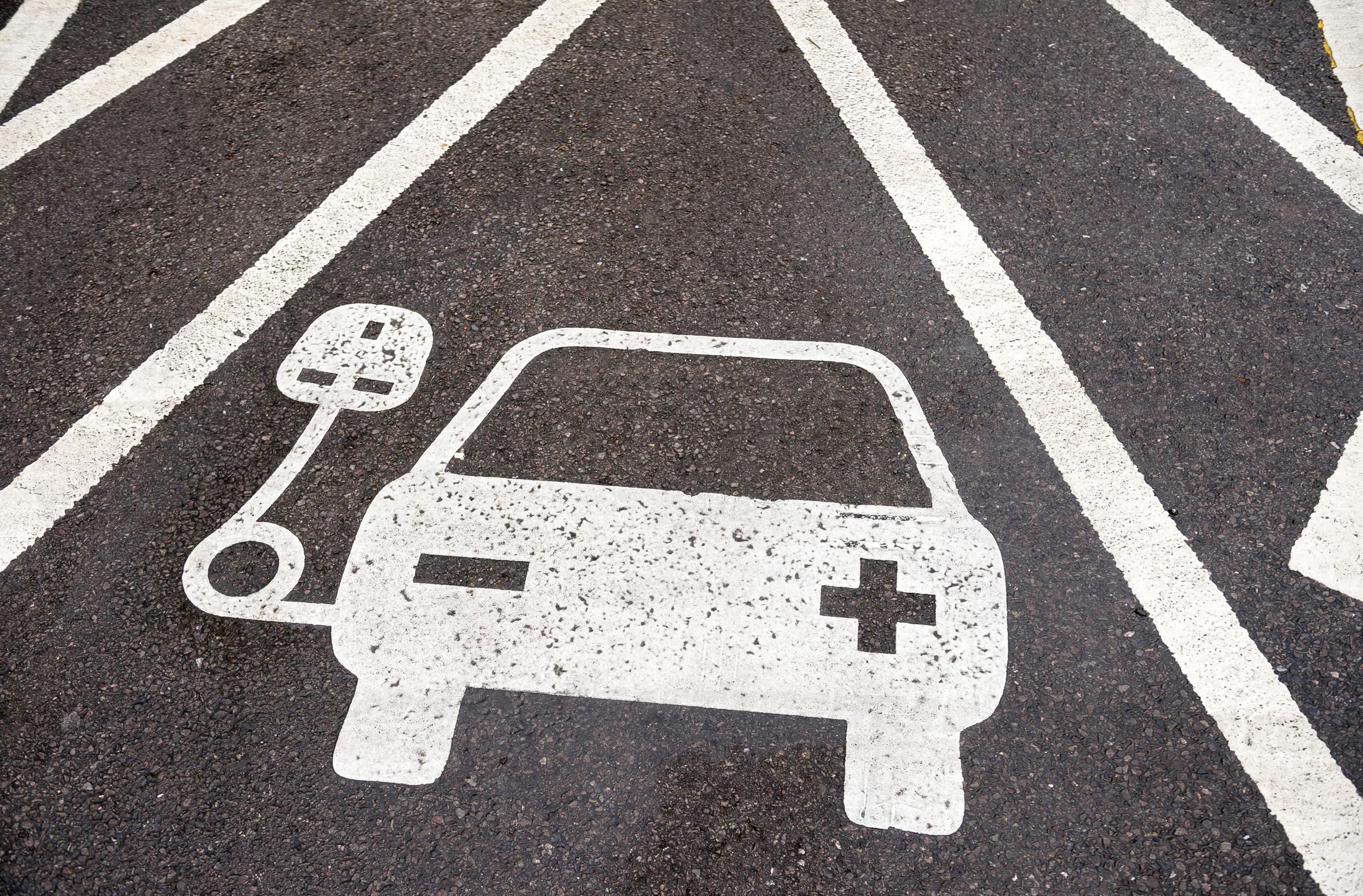

“It is all about adopting a pragmatic approach that reduces emissions year on year, while also being operationally viable.”
Arval’s Shaun Sadlier believes that technology can help fleets understand more about their transport and mobility needs. He said: “We believe that in many circumstances electric vehicles are both viable and cost effective, so companies should already have or be considering implementing them onto their fleet to reduce emissions. We strongly recommend fleets utilise real time data and the best source is through a telematics solution.
“Connected vehicle data will assist fleets in making informed decisions on three key pillars: fleet efficiency, fleet costs and sustainability, which includes environment and safety. In terms of overall mobility, companies should be considering their workforce mobility requirements, building a mobility policy which supports employees with the right tools and solutions to evaluate the best mode of transport based on cost, efficiency and environmental impact.”
Tristram Benson explains how his company approaches carbon reduction: “At Engineius, we have a clear vision and we believe that reducing your carbon footprint should be an organisation’s focus now, not in the future. We have taken a twin-track approach; firstly to set the business up operationally to avoid
Where electric vehicles may not be viable, e-cargo bikes are another option,
In considering whether electric vehicles are right for your fleet, you must also consider whether they make commercial and operational sense. But remember, if you are not willing to make sacrifices or embrace organisational change, it will have drastic implications for your business, long term
“We pay to carbon offset our corporate carbon footprint (CCF) by supporting a project for bamboo afforestation in
Introducing your next generation Raleigh Motus electric bike. Power up your next adventure, your Motus, your way.

Daniel Ainsworth from Raleigh says: “The great thing is that e-cargo bikes are more affordable than most EVs. As a business, you’ll save on fuel, maintenance, taxes and traditional motor insurance. Some companies have reported savings of up to £300 per month per vehicle when switching to e-cargo.
“One big benefit over electric vans is healthier employees. Even though the electric motor will assist the rider, the employee still has to pedal; this will benefit their physical and mental health.”
Many organisations are putting great effort into reducing their emissions. Yet it’s also important to understand and be accountable for the emissions created in supply chains. So how can companies effectively do this?
Steve Beadle from The Grosvenor Group, comments: “We are already seeing in most sectors that sustainability is a key requirement when supplying businesses, and companies without green credentials are being excluded from tenders.
“This is clearly because companies do not want to appoint suppliers that are damaging the environment, and are looking to achieve a zero emission supply chain in order to take their products and services to market.
“Quite simply, there is very little point in a company progressing towards carbon neutrality itself if members of its supply chain are not on the same page.
“It is for this reason that companies are now asking all of their suppliers to present to them their green strategies, provide certifications and accreditations, and this will naturally extend to a company’s vehicle fleet.
“Even if electrification across the whole fleet is not immediately possible, it will become increasingly important to demonstrate that businesses have a plan in place to transition to zero emission motoring, and if this plan is logical and clear it shows that the company has a fleet strategy it is working to.”
We are all part of the solution
Tristram Benson from Engineius believes that in order to overcome the climate challenge, we need to change dramatically, together.
Tristram explains: “According to Forum for the Future, systemic change is where relationships between different aspects of the system have changed towards new outcomes and goals.
“This is important when considering why you must be accountable for your supply chain emissions. Let’s focus on two parts from this statement. Firstly, the mention of relationships. This is where the drive for your partners, suppliers and stakeholders to change is just as important as yours. If we all take accountability for our supply chains, we create wide accountability. You are accountable for your partners, your partners are accountable for theirs and
the chain that is created can have a much larger impact that your company alone.
“Secondly, focusing on your operation is only one piece of the puzzle. We need dramatic change, and in order to achieve it, we need to take a wide lens.
“Speaking more practically, your first step is to ask your suppliers questions such as, ‘what are you doing to reduce emissions?’ ‘Are you measuring your emissions year on year?’ To go further, there are many organisations specialising in this. Engineius teamed with climate neutral experts Climate Partner to drive our green initiatives.”
Arval’s Shaun Sadlier, comments: “Being a sustainable and responsible organisation is key to any company’s strategy, never more so than now with climate impact needing to be factored into longer term planning. This includes not just operational carbon from a company’s own operations, but the wider impact of carbon produced as a result of products and services purchased from the supply chain.
“It is extremely important for the supply chain to be accountable and measure their own impact, with appropriate and visible carbon reduction targets, but also for companies who purchase from them to have visibility of their plans.
Working together on initiatives will be of growing importance, where companies and supply chains can evidence joint actions and appropriate changes to buying habits (e.g. move from ICE to electric vehicle purchasing). As a supplier in our own right, many of our customers are using their fleet electrification journey to demonstrate how they have lowered emissions to bolster their sustainability credentials in tender responses.”
With traffic, air quality issues, and parking problems in urban centres, how can organisations green their city operations and last mile deliveries?

Daniel Ainsworth from Raleigh believes that the answer to these problems is e-Cargo bikes. He says: “Currently, in the UK, I think the easiest way to green last-mile deliveries is to switch to e-cargo. Instead of having a large truck or van, make each delivery individually, which will be affected traffic and fuel inefficiencies. Have the deliveries dropped off at a hub for them to be delivered by cargo bikes. Quickly, you will notice both a short process time and a saving in fuel costs. Not forgetting the benefit to your staff’s health.
“It is a misconception that bikes are not affected by traffic; however, the truth is that even though they are affected by traffic, the ability to use bus lanes, cycle lanes and filter through traffic reduces the amount of time stationery. Results have shown that services provided by cargo bikes in London are 1.61 times faster than those performed by a van, saving over 14,5000kn of CO2 in a year.
It is extremely important for the supply chain to be accountable and measure their own impact, with appropriate and visible carbon reduction targets, but also for companies who purchase from them to have visibility of their plans. Working together on initiatives will be of growing importance as we move forwards
“As we all know, parking is a problem in most cities; the great thing about cargo bikes is car parking spots do not limit them. They can be taken right up to the destination’s door, eliminating the time wasted trying to find a parking spot.”
Shaun Sadlier from Arval said: “We want to be the provider of choice for sustainable mobility options for our customers and this is an especially acute need when we think about business travel and logistics.
“We are supporting clients who need to undertake deliveries in urban centres with a wider range of transport, including electric vans and even electric cargo bikes. They complement traditional vehicles and allow logistics companies to manage efficiency alongside being an
to go into cities options that are beyond driving their own car, while also providing a respite for existing infrastructure.”
Steve Beadle from The Grosvenor Group says that the first question companies need to ask themselves about city driving, is to what extent is it necessary.
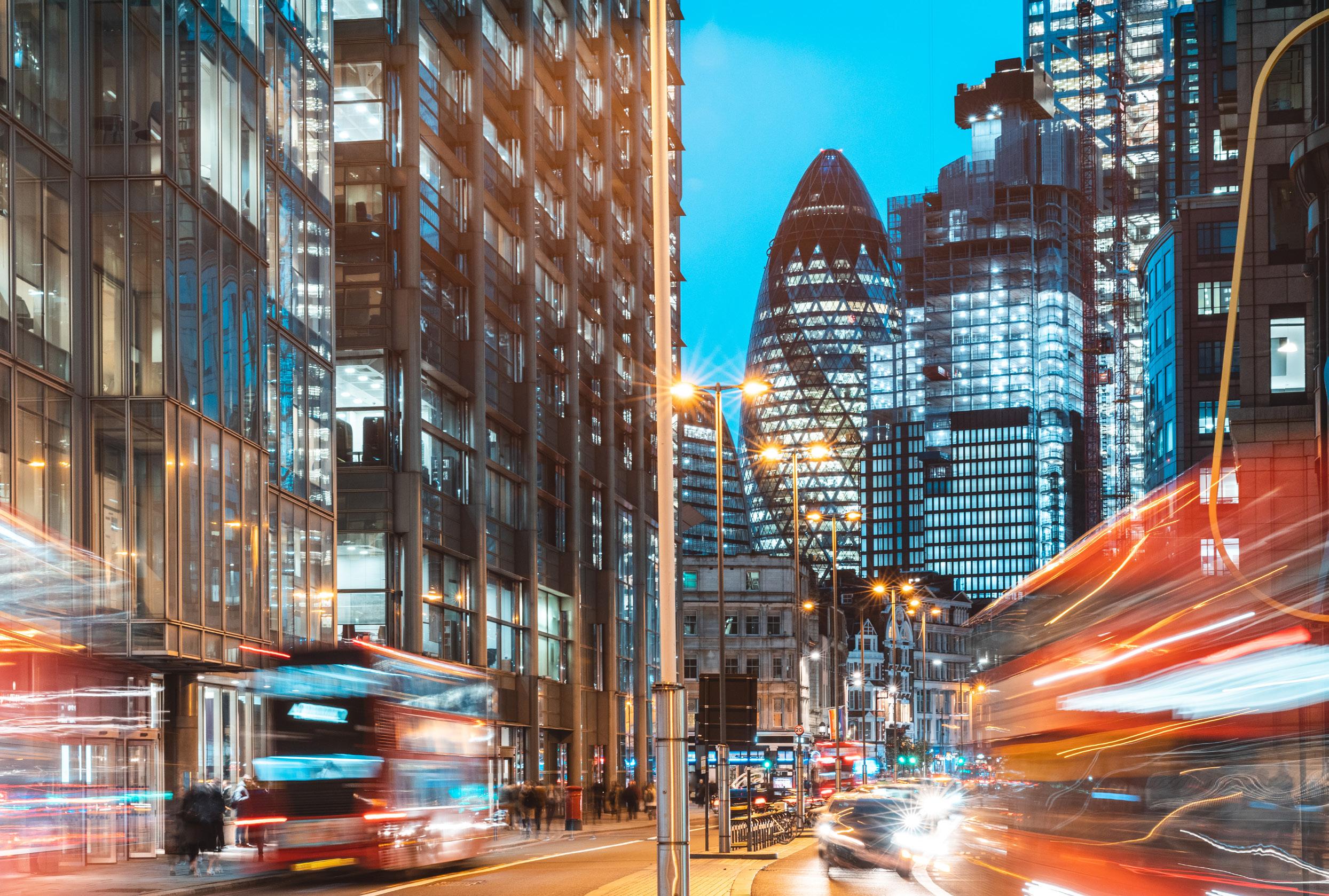
Steve explains: “If you have company car drivers in major urban areas, do they need a vehicle at all or can they rely on public transport alongside an increased use of video conferencing and online meetings.
“For those employees who do need a company car, it is highly likely that they would be able to have a fully electric vehicle because cities not only have a much stronger

for transport managers to have their electrification road map firmly in place.
“Regarding last mile deliveries, this is an area of intense scrutiny and consultation. Most commercial vehicle operators that we talk to are very much focused on this area, and electric light commercial vehicles can be a viable solution in urban areas.
“But with the rise of Internet shopping and the vast increase in deliveries, a whole infrastructure is inevitably going to be built around a last mile delivery model, with the vehicle manufacturers also developing a growing range of electrically powered e-vans, micro vehicles and e-cargo bikes that provide a better service to customers than traditional light commercial vehicles.”
Tristram Benson from Engineius, adds further advice on greening city operations: “Educate drivers through driver training, journey planning and speed awareness, and assess vehicle suitability according to journey types. When driving into a city centre make sure the vehicle is an EV or one with low emissions.
“When endeavouring to make the last mile as green as possible it is also important to consider noise and vibrations from vehicles too, which contribute to minimising city maintenance costs. Using smaller vehicles and the existing city infrastructure such as, electric scooters, bikes and public transport will help.
“Introduce car share and cycle-towork initiatives to actually reduce the number of vehicles entering the city, and reward employee participation.
“Weight salary and benefits packages in favour of EVs or purchasing rail cards and passes where appropriate.” L
Eliminating the use of diesel trucks for transporting electric vehicles and digitising the paper trail has made vehicle movement greener for many organisations. In fact, Engineius’ green approach to vehicle movement has saved fleets 1,838,232 tonnes of CO2 emissions in 2022. Here’s how
So far, in 2022 alone, Engineius’ awardwinning, technology-enabled service has saved fleets 1,838,232 tonnes of CO2 just by adopting a greener approach to vehicle movement. All fleets are tasked with finding new ways to reduce their emissions, and this is a great place to start.
How is this saving achieved? We don’t use chaser vehicles. This outdated practice more than doubles the miles driven for a delivery. Our EV deliveries are driven and not transported on diesel trucks, which sounds obvious, but is not yet the industry standard practice and we offer an entirely digital journey. Like in many aspects of life these wins are small, yet should not be overlooked as collectively they provide significant steps towards a greener environment,
Our research found that EVs were being delivered on diesel transporters, which is completely opposed to the EV cause, and more expensive! This is due to EVs being significantly heavier than their fossil-fuelled counterparts and therefore has implications for transported delivery, where a larger transporter is required to ensure it has the correct payload. Therefore, Engineius recommends that the greenest option is to drive and not transport. With EVs mileage range ever improving, this is an increasingly low-risk option.
A single vehicle movement historically created several pieces of paper for each transaction, which is not a particularly green process either. The Engineius digital journey removes the need for unnecessary paperwork and takes the whole process online, reducing administration and processing costs.
Engineius can help whether you run a fleet of 20,000 vehicles or just two. It is an on-demand service with no minimum order requirement or licence fee. Our one-stop-shop offering can cater

for all your vehicle movement needs whether driven, plated or transported operating across the whole of the UK.
How do our customers feel about working with Engienius? “As a premium luxury retailer, our customers expect a seamless experience at every step of their journey with us,” says Andy Wady, brand director at Jardine Motors Group. “Combine this with our reputation as industry leaders, we’re always working to stay one step ahead of consumer expectations. You can now order anything from food to medication online and track delivery in real-time –this is becoming the standard and the automotive industry is no exception.
“This is why we’ve partnered with Engineius; to give customers full transparency and control over their vehicle movement requirements, whilst also giving our colleagues the best tools to provide an exceptional customer experience. Ultimately, we want to make vehicle movement a seamless experience for our customers and position Jardine Motors Group as the dealer of choice: working with Engineius helps us to achieve this.”
Who else do we work with?
Literally anyone who needs a vehicle moving from A to B. Engineius’ service is utilised across many automotive sectors including, fleets, accident management, breakdown and recovery, SMR, rental, remarketing, leasing, auction and dealerships. Our clients benefit from the scale of our operation, a diversity of locations and requirements of all customers as the technology logically links jobs together. The minimising of ‘empty legs’ makes a massive contribution to increased efficiency in vehicle movement and is yet another win for reduced emissions.
AA Driving School commented: “After a short pilot period, it was clear that Engineius was able to provide the digital capabilities we were looking for, making them the ideal customercentric business partner. It was vital that we found a company that could offer a standalone “plug-in” for vehicle movement regardless of the preparation centre locations we chose.”
Vehicle movement for AA Driving School is a critical part of their fleet operation. The AA has one of the largest national Driving Schools with a network of instructors across the UK. Moreover, the delivery of a new vehicle is a special moment for instructors that mustn’t disappoint.
AA Driving School adds: “We have been delighted with Engineius – not only because the size of their driver network gives us a one-stop shop for all movements, but the quality of their service has also satisfied our exacting standards.”
Customers across all automotive sectors can manage their movements with total transparency; receiving a price for a job takes just 30 seconds and photos, GPS tracking, and timestamps can be monitored live online. Once an order is placed clients remain in control whilst Engineius takes responsibility for the logistics.
Engineius network of over 500 drivers and transport agents located across the UK. They are trained, scored and tagged to align with customer expectations. All drivers utilise a mobile app to provide text alerts and real-time photos to the customer, Engineius is driven by technology, and all users will benefit from our commitment to ongoing research and development to continually improve our digital journey and reduce the impact of vehicle movement on the environment. L
INFORMATION
www.engineius.co.uk
When it comes to the decarbonisation of fleets, change is key. But change can pose significant barriers on the road to net zero. This was discussed at GreenFleet’s roundtable, which saw fleet managers and industry professionals gather at Anfield Stadium in Liverpool on 20th October
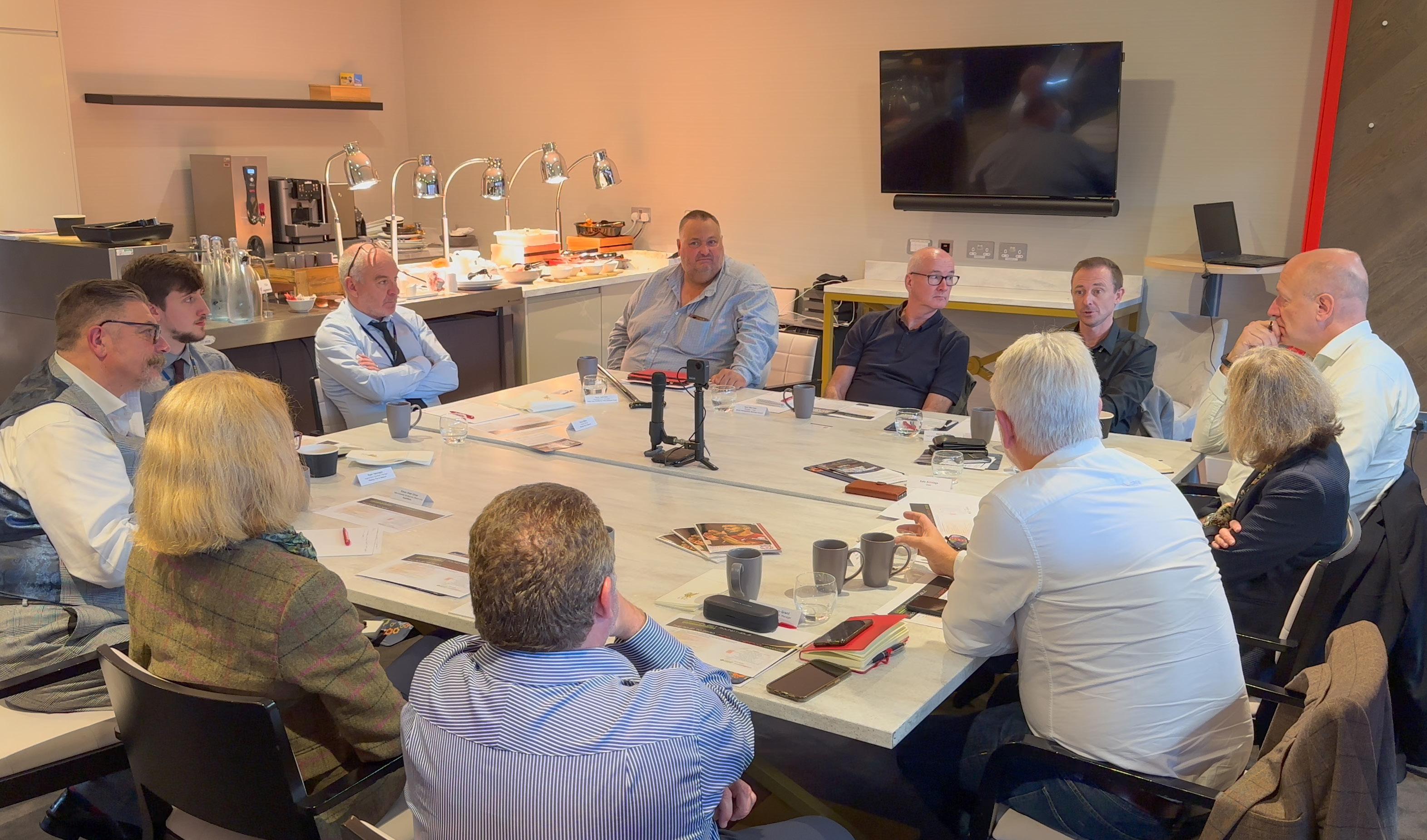
Change was the common theme in GreenFleet’s recent roundtable at the Anfield Stadium in Liverpool. Change is inevitable: we either change the way we live today and significantly reduce our carbon emissions, or we continue as we are until we have reached the point of irreversible climate change.
When it comes to the decarbonisation of fleets, change takes many forms such as culture change, behaviour change, operational change or organisational change, and each one poses a significant barrier in the road to net zero. Here in the North-West, we have seen plans for both the Manchester and Liverpool Clean Air Zone stalled or delayed as residents opposed change.
During our roundtable we explored how best to plan change, tools for tracking change, new mobility solutions as well as myth busting some of the barriers to change.
Net zero touches all parts of an organisation
For an organisation to achieve net zero; change must be far reaching and go well beyond switching company vehicles to zero emission. It is about creating a business wide net zero ecosystem that covers transport, buildings, energy and even suppliers of goods and services.
Simon West-Oliver, sales and business development director at Assetworks observed that net zero solutions need to be holistic and include, for example, air source heat pumps, photovoltaics, renewable energy supply and energy storage. Ensuring these
assets work together in harmony is an additional complication but is essential for a business to become truly net zero.
Merseyside Fire & Rescue has recognised this challenge and has created a net zero project team responsible for cross functional co-ordination that considers all power requirements including transport and buildings. Terry Giblin explained that the service must co-ordinate across five different boroughs with each borough having a different net zero target from 2032 to 2040.
Simon West-Oliver explained that despite the complexity, businesses starting the net zero journey all have the same questions; where to start? What does good look like? Where to go next?
When planning for change Assetworks helps clients to map the existing replacement cycle and identify where ULEV options exist today. The company also encourages a review of the traditional ownership route considering leasing, rental, subscription and possibly even retrofit.
And this approach is certainly working; Assetworks already has 14 million assets globally under their management,
including Royal Mail, one of the UK largest fleets with just under 50,000 vehicles.
We also heard practical advice from Helen Acott from the Energy Saving Trust who support fleets transitioning to net zero.
She advised: “Don’t worry about what you can’t do, focus on what can be done.” And make sure you have a plan for how and where these vehicles will be charged.
We have also seen significant change in the energy markets in the last 12 months, and the recent wave of energy price increases has placed a huge strain on operational budgets across most businesses, this was a cause for concern for our fleets.
Tony Johnson, development manager at Alderhay Children’s hospital reported that their annual energy bill has increased from £3m-£8m with no additional financial support. Inevitably this financial pressure will result in budget cuts elsewhere. The energy crisis, and the prospect of blackouts at peak time this winter, further highlights the importance of energy resilience and the benefits of local energy systems such as micro-generation and battery storage; although lack of capacity and the requirement for expensive electrical upgrades remain a significant barrier.
Change was commonthetheme in recentGreenFleet’s roundtable at the Anfield Stadium in Liverpool

Public sector fleets, like the NHS, are seeking to reduce the use of private cars (due to lack of parking and to improve local air quality), however progress is slow as it requires a big behaviour change. Artisan Electric Scooters is offering a low cost, low emission alternative to the passenger car. With a 60 mile range on a single charge, and running costs of 2p per mile the electric scooter is great in urban traffic. They are also easy to park and can easily be recharged from a domestic socket.
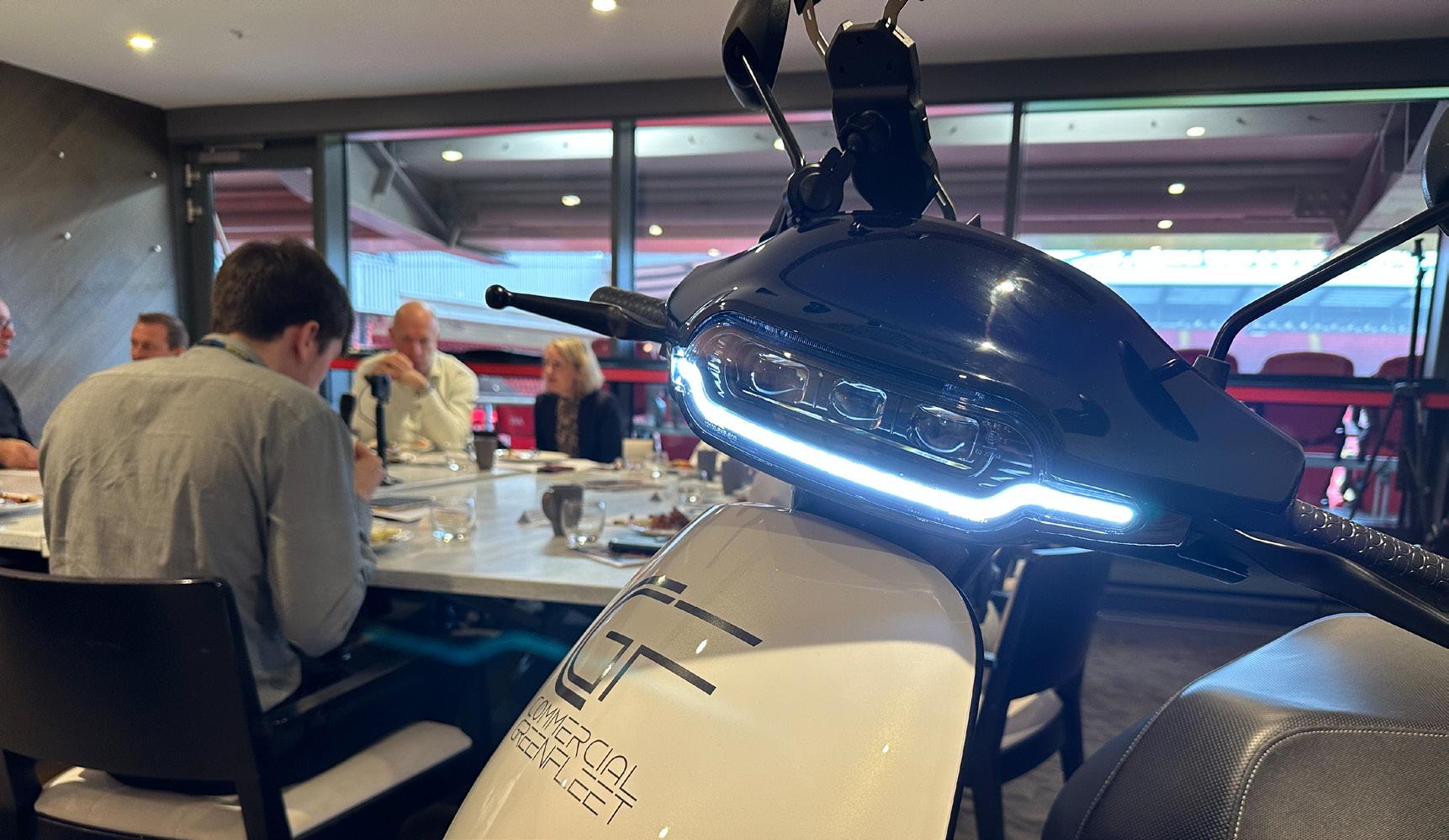
Artisan Scooters saw sales shoot up during COVID when commuters were looking for reliable personal mobility solutions. New lifestyle services such as the on-demand grocery delivery service Getir have also played an important role in changing attitudes towards scooters. Many forward-thinking fleets are also adopting electric scooters, Adam Bowen, business development manager at Artisan Scooters is working with delivery companies such as Just Eat, couriers, parking attendance services and even plumbers. Adam is on a mission to change attitudes and the culture towards scooters and motorcycles in the UK. He is keen to point out that electric scooters are not just toys for the weekend they are an important vehicle for urban businesses and commuters.
EV myths are also cited as barriers to change, with a variety of topics coming under scrutiny during the day. Battery life continues to be a cause for concern amongst our fleets; however Randall Smith was quick to point out that the evidence from auto OEMs shows a very healthy battery market, with new technology emerging such as sold state batteries, long warranties, solutions to replace cells and strong second hand values.
The discussion also touched on the growing market for second life car batteries (where
old car batteries can be repurposed) with companies such as Connected Energy and EDF forming strategy partnerships with Nissan and Renault to support the use of these batteries for energy storage (grid scale, or local storage) or even as a low-carbon alternative to diesel powered generators.
The whole life carbon intensity of EVs (particularly the production of batteries) compared to ICE vehicles also raised concerns. However, Helen from EST noted that a number of reports have been produced on this topic
such as The European Environment Agency (EEA) that disprove the myth that EVs have a higher carbon footprint that their ICE equivalent. There is also an online Climate Wheels calculator from Otherway.co which has the capability to run climate analysis on every single road vehicle in the UK. Otherway.co doesn’t just look at the tailpipe: they look at how the vehicle is made, how it’s used and what happens at the end of its life compared to an internal combustion engine, with the ultimate aim of driving positive change. L
For an organisation to achieve net zero; change must be far reaching and go well beyond switching company vehicles to zero emission. It is about creating a business wide net zero eco-system that covers transport, buildings, energy and even suppliers of goods and services.

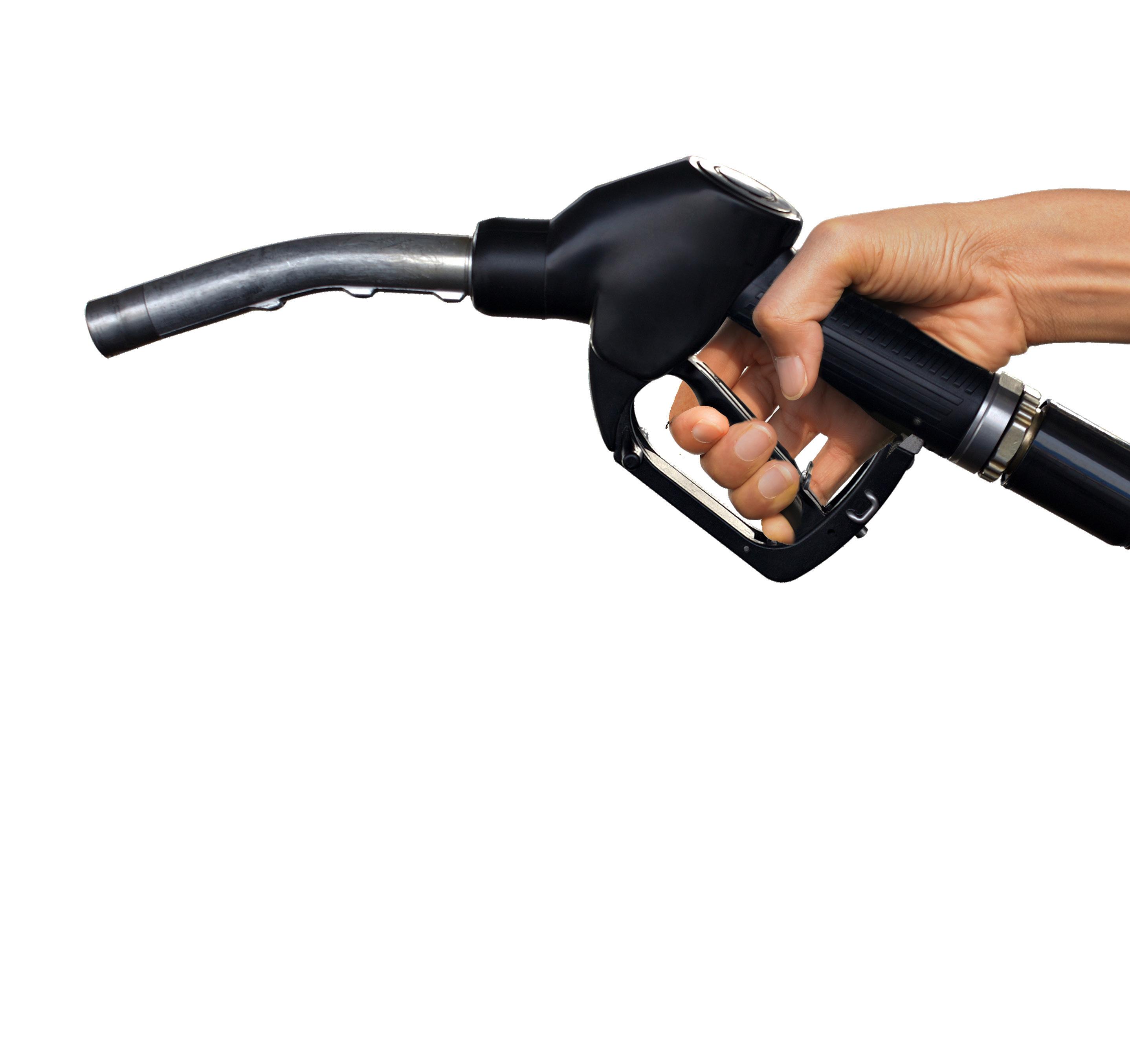





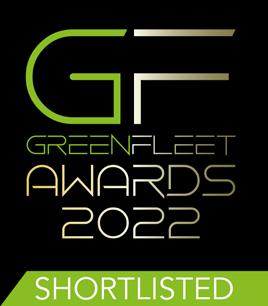
The shortlist for the 2022 GREENFLEET Awards has been revealed, showcasing environmental excellence within the fleet and transport sector


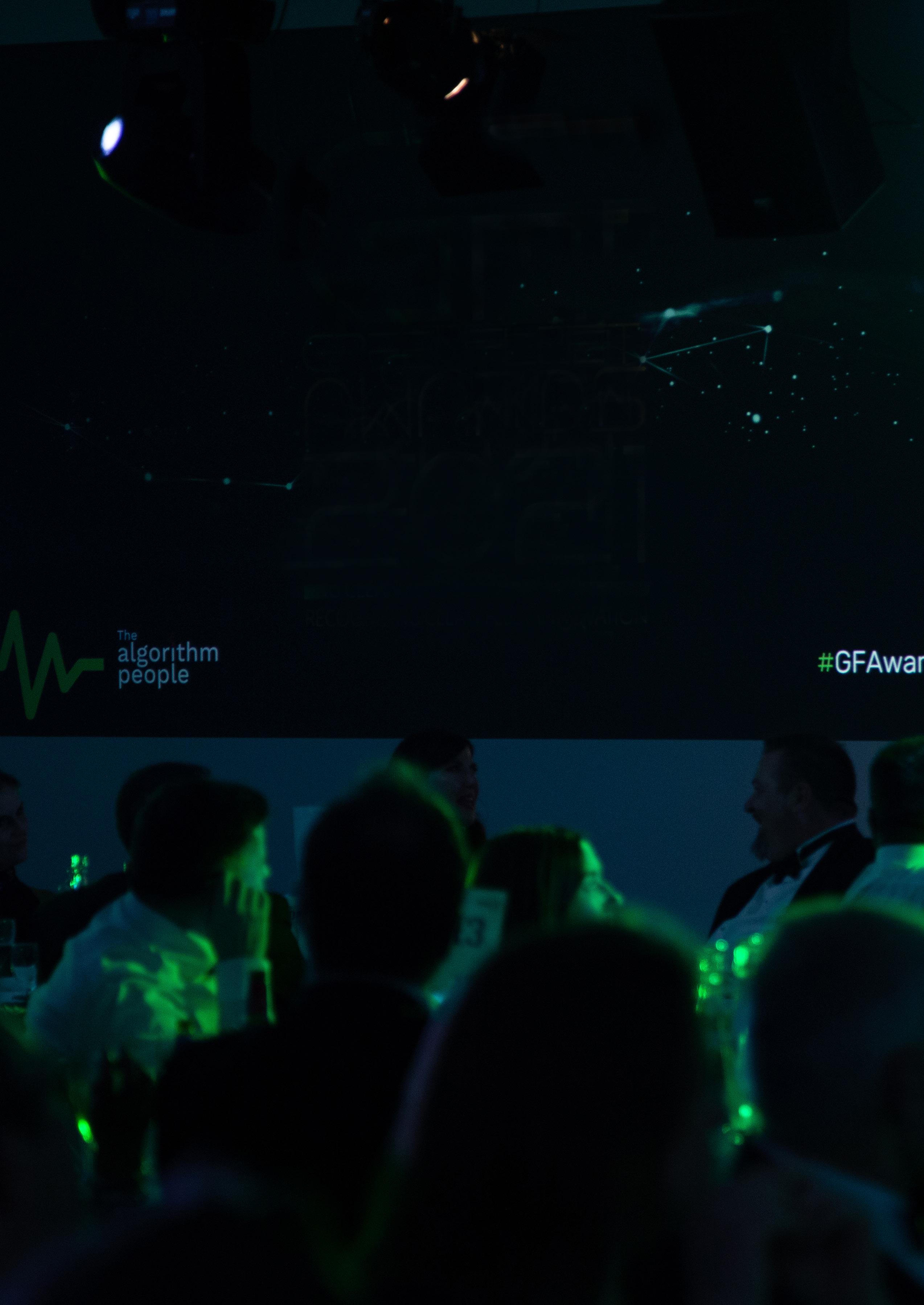


Taking place on 8 December at the British Motor Museum in Warwick, the 2022 GREENFLEET Awards, sponsored by the Algorithm People, will once again recognise the pioneering fleet operators that have risen to the environmental challenge, as well as the companies helping them do so. There is individual recognition too, with fleet manager awards, together with the coveted EV and AFV Champions.
For the second year, GREENFLEET will also be announcing its Vehicle of the Year award. As more and more manufacturers introduce cleaner, innovative models to their offering, this category will recognise

the environmentally-sound car, van or truck that has made the biggest impact on the UK fleet sector in 2022.
The awards will be presented by comedian Gary Delaney following a pre-dinner reception, sponsored by Maxus, and a three course dinner.
The shortlist is as follows.
Public Sector Car Fleet of the Year
The Public Sector Car Fleet of the Year award, sponsored by AssetWorks, will recognise the UK public sector organisation or charity that can demonstrate a reduction in CO2 through adopting cleaner vehicles and managing their operations in the most efficient way possible.
Redcar & Cleveland Council’s fleet has been recognised for achieving an almost 60 per cent CO2 saving since 2019/20, due to introducing low and zero emission vehicles, as well as transforming fleet operations through a digitalised workflow. The Council is also trialling hydrogen as a fuel and upskilling its workforce on electric and hybrid vehicles.
Environmental charity Changeworks has also made the shortlist for maintaining the growth of its fleet while simultaneously decreasing its total emissions from 41t CO2e to 28t CO2e, saving 13t of CO2e this year. The fleet has 25 vehicles, including hybrid electric vehicles, battery electric vehicles and ebikes, and has doubled the number of charge points from six to 13.
Recognised for its ‘no diesel’ and ‘Transition to Zero emissions Policies’, the City of London E
awardsThewill once again recognise the pioneering fleet operators that have risen to environmentalthe challenge

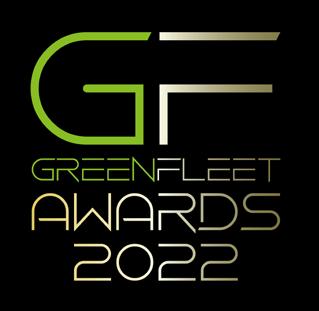
Corporation is also up for the Public Sector Car Fleet of the Year award. For every new vehicle purchased by the Corporation, it undertakes a business case study to ensure it chooses the best-suited vehicle for the job. Over the past seven years, it has reduced the fleet by over 150 vehicles which has equated to an average carbon saving of 389690000g. As well as trialling alternative fuelled vehicles over the past few years, the City of London has purchased a number of electric vehicles.
The Private Sector Car Fleet of the Year, sponsored by the AA, recognises organisations in the private sector that are making excellent progress in eliminating harmful emissions from their fleet.
Mitie, who won GREENFLEET’s Outstanding Achievement Award last year, has been shortlisted in this category for its substantial pure electric fleet in the UK, which makes up thirty-eight per cent of its 6,994 vehicles. Mitie’s 2,643 EVs prevent 15,858 tonnes of carbon from polluting the environment annually.
Galliford Try is another contender for the Private Sector Car Fleet of the year award. Operating a mixed fleet of 1,900 company cars, vans and specialist vehicles and using various procurement options to keep costs low for the company, Galliford Try offers an attractive and tax efficient car choice list for its employees. Over 40 per cent of the fleet are EVs and a further 18
per cent are PHEV. The company also has a further 710 EV and PHEV cars on order.
Eric Wright is also in the running for the Private Sector Car Fleet of the Year award. Sixty-nine per cent of Eric Wright’s car fleet runs on alternative fuels and 63 per cent is made up of ultra low-emission vehicles (ULEVs). As of the end of September 2022, Eric Wright has 97 battery electric vehicles on fleet, with an order bank of which 95 per cent are either battery electric or plug-in hybrid vehicles. Eric Wright is investing heavily in infrastructure and its head office power supply is being upgraded this year to accommodate an increase in EV charging points from five to 40 units.

The Public Sector Commercial Fleet of the Year award, sponsored by Fleete, will celebrate a public sector organisation or charity that can demonstrate achievements in eliminating CO2 from its fleet.
On the shortlist is Hampshire County Council, which has a number of electric vehicles on fleet and is currently in the second year of a pilot using hydrotreated Vegetable Oil (HVO) for its larger fleet. This reduces carbon emissions by 89 per cent, lowers PM2.5 by 70 per cent and NoX by 24 per cent on average. This has saved over 2,000 tonnes CO2e in this year.
Nottingham City Council has made the shortlist for continuing to push the boundaries
of what is possible to reduce emissions from its fleet. The council now has 243 electric vehicles which includes an electric minibus, sweeper, cage tipper and OEM RCV. The savings have been significant – £921,000 and 1,162t CO2 p/a and an expected £9.8m and 12,470t CO2 over their lifetime. The council has also invested in other innovations – from the UK’s first publicly-funded EV-only vehicle maintenance workshop and charge point load balancing, to 40 vehicle-to-grid charge points, solar panels on depot roofs and a 500kw battery storage solution.
Scottish Water, a public company accountable to the Scottish Government, has also made the shortlist in the Public Sector Commercial Fleet of the year category. Currently, there are 25 electric vans on the road, 12 fully electric pool cars and it operates an electric-car only managers and salary sacrifice schemes.
London Ambulance Service is also up for the Public Sector Commercial Fleet of the Year award. Following a significant investment and huge amount of innovation, London Ambulance Service has reduced the weight of its ambulances down to 3.5 tons, saving 30 per cent of the exhaust emissions.
London Ambulance Service has purchased 59 lightweight ambulances and four fully electric ambulances, as well as 42 Ford Mustang Mach-E fully electric response cars. This is set to make it the largest fully electric response fleet in the country. London Ambulance Service also has three zero emission motorbikes, E

My Electric Vehicles is our market-leading web portal for fleet, facilities and energy managers. Use it to manage your charging infrastructure - or mobilise its full potential by unifying your charge station, fleet and site energy consumption data.




energy.drax.com/ev
and the resuscitation training service has ten electric vans with range extenders.
The Private Sector Commercial Fleet of the Year, sponsored by the Algorithm People, celebrates those organisations that are taking great strides in reducing the environmental impact of their vans, trucks, and specialist vehicles.
Evri (formerly Hermes UK) is on the shortlist, recognised for its substantial use of biomethane compressed natural gas (CNG) as an alternative to diesel. In 2021/2022, the company ordered 70 new Bio-CNG tractor units, bringing the total to 160 – 50 per cent of its core tractor fleet. Evri partnered with CNG Fuels, which sources renewable Bio-CNG from food waste. Each new CNG unit reduces CO2 emissions by over 80 per cent when compared to a diesel equivalent – a reduction of 150 tonnes of CO2 per vehicle and 24,000+ tonnes of CO2 across the entire Bio-CNG fleet annually. In 2021/22, Evri ordered 168 zero-emission electric vans to support its out-of-home ParcelShop network. Evri is also exploring zero-emission last mile deliveries.
Anglian Water Services has been shortlisted for its focus on replacing its ICE vans for electric alternatives, as well as putting in place the supporting charging infrastructure, and implementing a new telematics system. Anglian Water has also commissioned & built the first all-electric jetting solution
to be operated in Europe, utilising a full electric van 3.5 ton van and electric jetter.
Mitie has also been shortlisted in the Private Sector Commercial Fleet of the Year category for consistently exceeding its environmental targets. Mitie’s 2,643 EVs prevent 15,858 tonnes of carbon from polluting the environment annually. As Mitie’s fleet makes up 94 per cent of its operational emissions, transitioning to EVs has significantly contributed to Mitie reducing its emissions intensity by 43 per cent to 5.28 tonnes.
OVO Energy is recognised for growing its EV fleet - by the end of 2022, 66 per cent of OVO’s total fleet will be electric, 65 per cent of which will be electric vans. At the beginning of 2022 OVO’s average g/ km CO2 was 141 g/km for vans and by the end of the year, the company predicts the average CO2 will be 53 g/km for vans.
Speedy Asset Services has also been shortlisted for an award for its progress in switching more than half of its 1,100-unitstrong commercial fleet to electric or hybrid units by 2025. Based on trials with Ford Pro UK, Speedy has placed an order with Ford for 100 of its E-Transits, which are used to deliver and collect its top 350 core products across the UK and ROI. This has a solar panel roof to save the EV mileage range.
The Public Sector Fleet Manager of the year, sponsored by Rivus Fleet Solutions, is awarded to the individual
that has put in place a successful fleet decarbonisation strategy.
Gareth Healy, fleet manager at Redcar and Cleveland Council, has been shortlisted for the award for his achievements, which include championing and implementing a digital workflow process for the entire fleet, fully modernising the council’s workshops, and advancing the fleet’s sustainability plan and green credentials.
Andrea McKenzie, fleet manager at Changeworks has been recognised for her dedication to environmental fleet management, despite the challenges that have risen this year. Andrea McKenzie has maintained the growth of Changeworks’ fleet while simultaneously decreasing its total emissions from 41t CO2e to 28t CO2e, saving 13t of CO2e this year. Andrea has also doubled the number of charge points from six to 13 and worked around lengthy lead times for EVs by hiring or leasing electric vehicles.
Chris Rutherford and Rob MacIntosh at London Ambulance Service have been recognised for their pioneering work with the emergency fleet, such as reducing the weight of ambulances, as well as adopting electric ambulances, response vehicles, motorbikes and range-extender vans for the resuscitation training service.
Matt Ralfe, innovation and change manager at Nottingham City Council has also been shortlisted for the Public Sector Fleet Manager of the year award. Matt has been instrumental at pushing the boundaries E
Registrations of electric vehicles (EVs) rose 75% last year demonstrating a growing interest in going green from British fleets to create a zero-emission future. Answering this need and supporting businesses to transition to full electric or hybrid company vehicles, Allstar launched the Allstar One Electric fuel card giving drivers access to on the road public charging with more than 8,600 charge points across a multi-branded EV charging network of 13 CPOs.
Though strategic partnerships, Allstar has actively enhanced its offering in the last 12 months, including providing customers with access to an increasing

amount of charging sites. Allstar One Electric is also accepted in the Zap-Map app, enabling drivers to search, plan and pay for charging across the Allstar electric charging network. Overall the EV charging card is accepted at over 90% of fuel sites across the UK, alongside access to 1,600 Discount Diesel sites, enabling operators to manage all fuel types on one payment card. By aggregating merchants and locations, this results in lower costs and increased convenience.
Using RFID chip technology, customers tap to activate an EV charge and tap again to finish the charge and all payments are done through one card. Where CPOs allow,
Allstar also leverages its partnership with Zap Map to allow mobile payments. Combining this proposition with Allstar Homecharge, powered by its partnership with Mina, offers complete visibility of charging and payments on the road and at home. Allstar Homecharge simplifies the settlement of drivers’ business home charging by paying their energy supplier directly. This mitigates any out-of-pocket expenses, administration or bill shock, something that is critical amid the steep rise in energy prices. Employees also have access to their charging history and payments through the Allstar Driver Homecharge portal.
Allstar’s suite of EV charging solutions provides a one-stop-shop for fleets, with a holistic view of drivers charging sessions on the road and at home with consolidated billing, accurate driver settlement and reporting. With the right tools and initiatives in place, we can together drive down CO2 emissions long into the future, and Allstar will be there for every step of the way. L

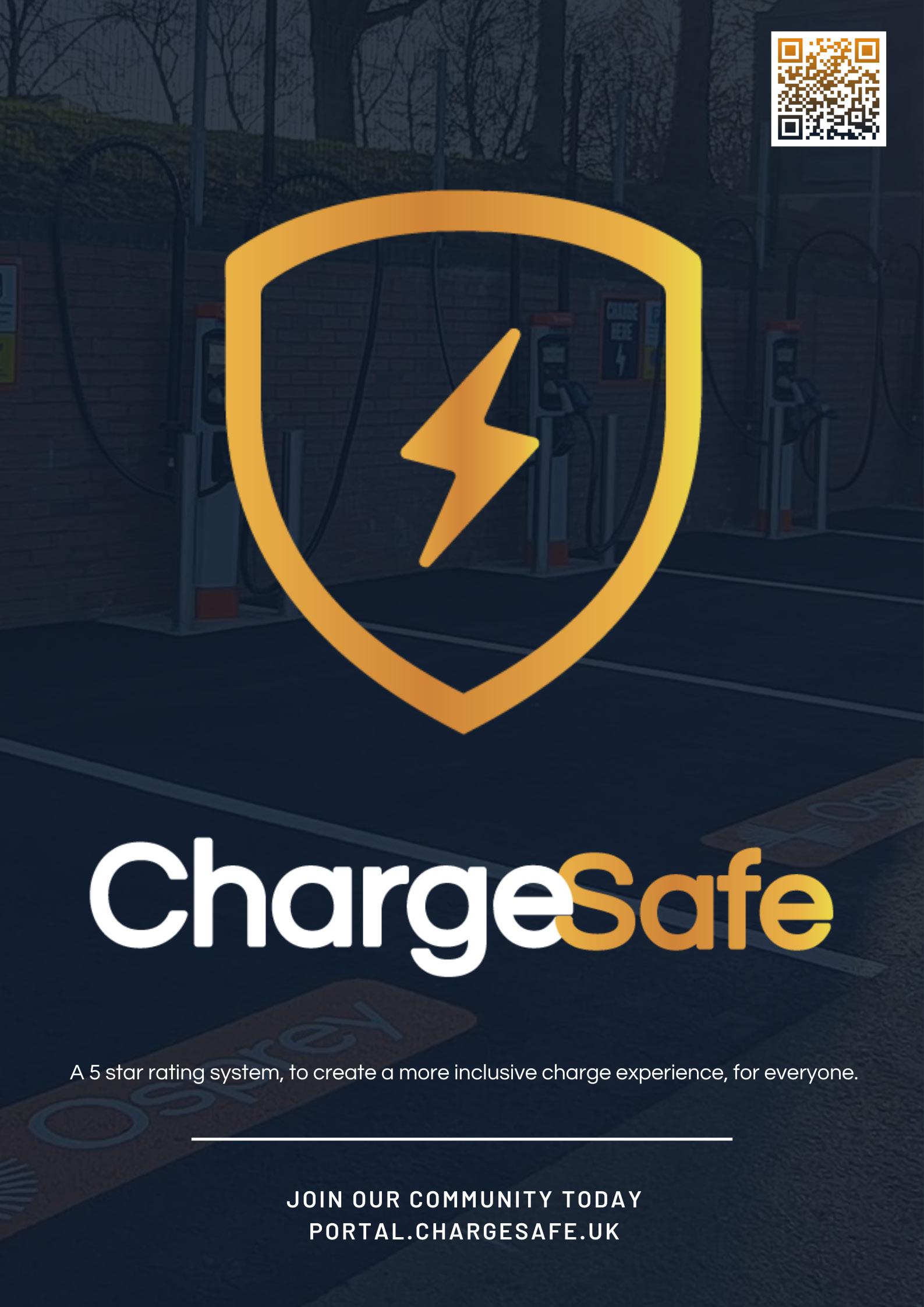
of what is possible with its mixed fleet. The council now has 243 electric vehicles, which includes an electric minibus, sweeper, cage tipper and OEM RCV. The savings have been significant – £921,000 and 1,162t CO2 p/a and an expected £9.8m and 12,470t CO2 over their lifetime.
The Private Sector Fleet Manager of the year award, sponsored by Synetiq, celebrates an individual that has been successful at reducing its fleet emissions through innovation and creative thinking.
Steve Openshaw, fleet manager at Eric Wright Group has been shortlisted for the award in recognition of his commitment to electric vehicles, investment in the charging infrastructure, as well as working closely with the company’s supply chain to terminate high CO2 diesel vehicles.

Also shortlisted is Aaron Powell, Fleet Director at Speedy Asset Services for his work reducing the company’s overall carbon foot print. Aaron has completely changed the company car list from diesel vehicles to full EV and PHEV vehicles, as well as implementing the roll out of EV chargers at its locations. Aaron has also worked with the body conversion company to design the industry first chassis cab half box half curtain vehicle. This vehicle will allow Speedy to deliver its kit in all weathers dry and securely. The first vehicle is a mild hybrid diesel version
but a version based on the Maxus E Delivery 9 chassis cab is also being worked on.
S-J Mitchell, senior fleet manager at OVO Energy has been recognised in this category for the huge task of merging two very different fleets, following the acquisition of SSE Retail. The fleet size almost tripled overnight with different fleet mixes and driver behaviours.
Through the last two years, she has led the way in harmonising the fleet and influencing drivers into the EV space. By year end she will have put over 550+ new ELCVs onto the fleet, with 66 per cent of all vehicles being BEV.
Alan Baker, head of fleet at Galliford Try, has also been shortlisted for embracing the challenge of providing the right vehicle to cope with the varied requirements of a diverse group of companies, operating a mixed fleet of 1,900 company cars, vans and specialist vehicles. With the adoption of electric and plug-In hybrid vehicles, Galliford Try’s average CO2 across the company car fleet has reduced from 125g/km in 2012 to 52g/km today.
The Mobility Provider of the Year award recognises companies that are helping to facilitate a transition to greener travel, utilising innovative and flexible solutions.
Europcar Mobility Group UK has been shortlisted for continuing to add zero and ultra-low emission vehicles to its fleet this year, including 100 LEVC VN5s and more than 200 Tesla Model 3s. Seventy-five per cent of Europcar’s company car vehicle orders for
its own employees are EV and 15 per cent are hybrid. The average CO2 for this fleet is 17g, compared to 114g 12 months ago.
Enterprise Car Club (ECC) has been shortlisted for its work enabling over 160,000 members adopt flexible and green mobility options. It has over 2,200 low emission vehicles, with 113g average CO2 value. Fortytwo per cent of the fleet is either hybrid or full EV (including some hydrogen vehicles), and just under 200 vehicles are full EV.
Northgate has been shortlisted for utilising its knowledge of business mobility needs to put together a full suite of tools to ensure customers have a smooth EV transition for LCVs. A thorough fleet analysis is the first step, assessing the immediate suitability for a transition to EVs for any business, using telematics data. Northgate can then offer vehicles on trial to fleets before a full commitment.
Reflex Vehicle Hire has been shortlisted for its investment in its Drive with Reflex modular risk management service to aid the fleet decarbonisation journey, particularly for SMEs. Using information about the current fleet and journey patterns, data can be filtered to identify cars and vans that would be suitable for plug-in technology today and to help plan a strategy.
Elmo has also been shortlisted for making it easy to switch to an electric car. Users ‘subscribe’ to an electric car on a flexible, monthly basis (like Netflix and Spotify). There’s no deposit to pay, and when you want to E


end or swap to a different car, 30 days’ notice needs to be given after your first month. The subscription package includes insurance, maintenance, breakdown, vehicle excise duty and congestion charges as standard.
Volkswagen Financial Services Fleet (VWFS Fleet) has been shortlisted for Leasing Company of the Year. The company developed its own bespoke fleet information portal, giving customers access to an innovative and intuitive digital fleet management solution. The portal combines intelligence-led features and accessible services to connect account management, customer service, thirdparty suppliers and customers together.
LeasePlan UK has been shortlisted for expanding its flagship offering to include LeasePlan Flexible, which is an EV-focused, mid-term rental proposition, with a digital showroom where customers can self-serve through vehicle-selection and contract e-signing. From 2,661 vehicles in 2021, the LeasePlan Flexible fleet has grown to 4,092 vehicles and is predicted to exceed 6,000 vehicles by end-2022 – a 125 per cent increase.
Another contender for Leasing Company of the Year is Lookers Leasing. The company has grown the electric vehicles it offers customers - from 0.4 per cent of its fleet in 2019 to 17.25 per cent, and has recently created a Whole Life Cost calculator to demonstrate why going electric is cheaper overall than an ICE vehicle.
Ogilvie Fleet has also been shortlisted for its central, independent and open-source hub for EV knowledge to help customers with commercial fleet electrification. What’s more, Ogilvie Fleet set up an internal ‘Green Fleet Taskforce’ to discuss changes and developments within the EV landscape, ensuring that all its staff are well informed about the future of EVs. The rapid adoption of EVs and PHEVs by Ogilvie’s drivers has resulted in a drop in emissions across its passenger vehicle fleet over a short period of time - 45 per cent of all car orders taken for the year ahead are for pure EVs, and when plug-in hybrids are included, this rises to 78 per cent of all vehicles.
ElectriX from LV= General Insurance, has also been shortlisted for its one-stop shop offering drivers everything they need to switch to an electric car – from leasing a vehicle, through to buying a home charger and getting electric car insurance.
The IT Innovation award examines the latest advancements in fleet technology, including fleet management software, telematics, route tracking and other IT related transport technology.
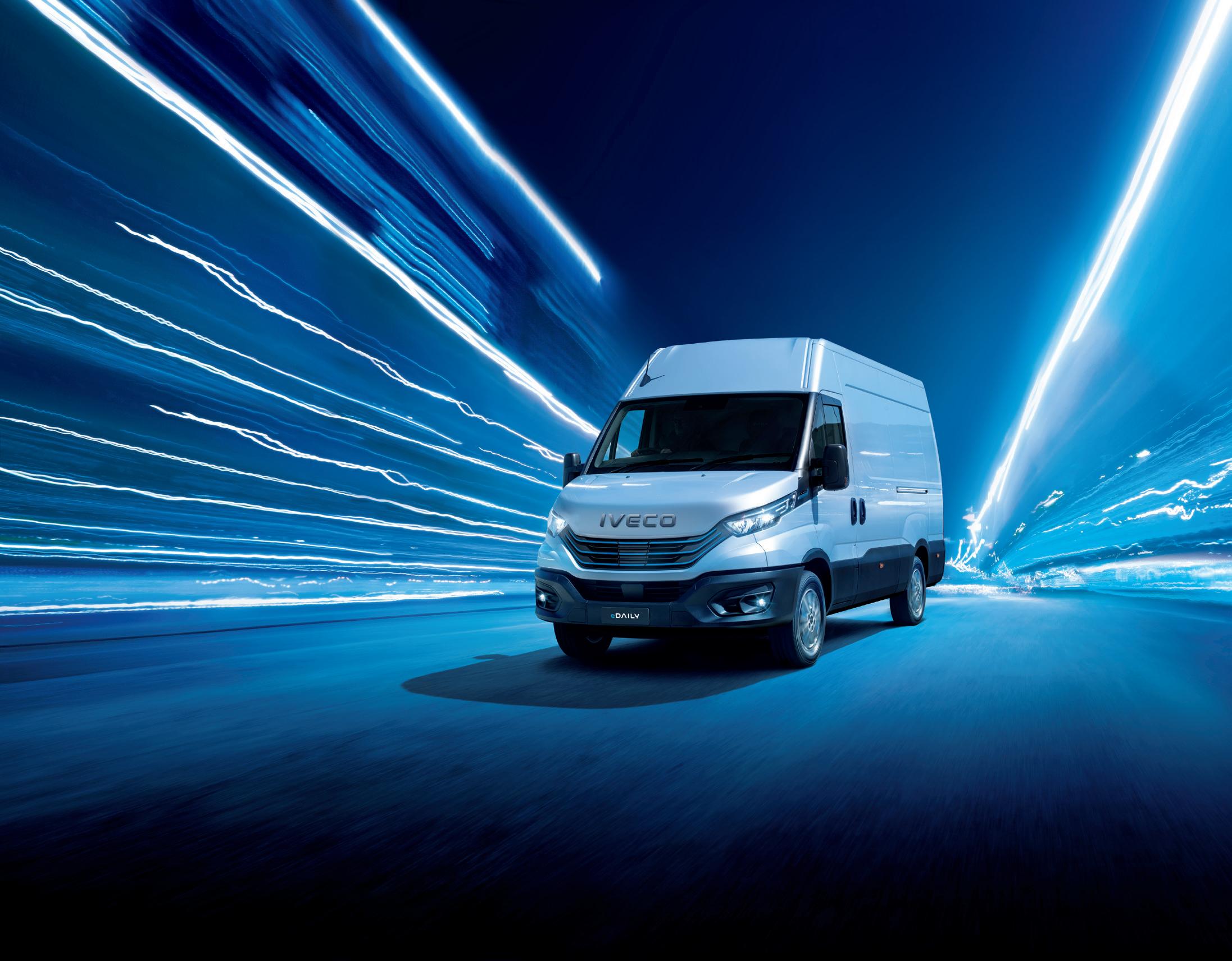
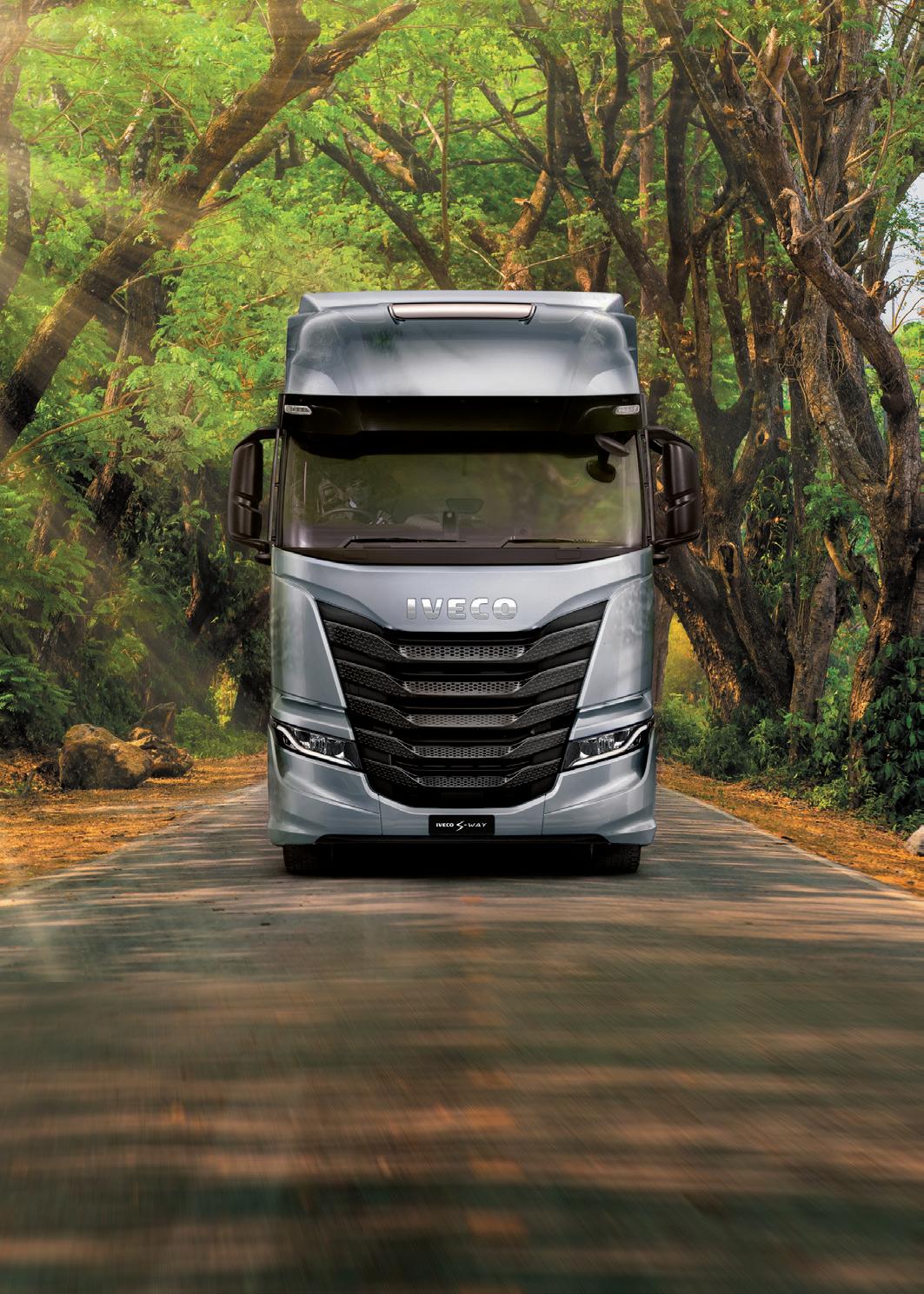
Paythru has been shortlisted for taking an innovative approach to managing and paying for parking and charging. Through Paythru’s platform, users manage the length of their parking, and the amount of kW
be accessed in any way; through an app, website, or smart parking terminals.
Paua has also been shortlisted for recognising and solving a problem of business customers using and paying for the public network. With the Paua app and card, drivers can find, charge, and pay for charging on public infrastructure networks. The app allows drivers to find out if a charge point is active, the connector type, the charging speed, the costs, and the availability. Paua provides a 100 per cent renewables guarantee and a fleet manager dashboard to monitor all transactions; plus fleet managers can receive a single VAT ready itemised bill for accounting.
Drax is also in the running for the award for its EV-investment management tool, which is a one-stop-shop EV management system where users can manage their vehicles, charge stations and energy consumption in one interface. The portal provides genuine value to fleet managers, facilities managers and energy managers.
Jumptech has been shortlisted for its online platform to streamline the installation of EV charge points, for both domestic and commercial projects. Jumptech’s niche platform connects all parties involved in the rollout of EV charging points. When customers implement Jumptech’s platform, they are able to access everything related to installation projects in one place.
Webfleet – the fleet management platform
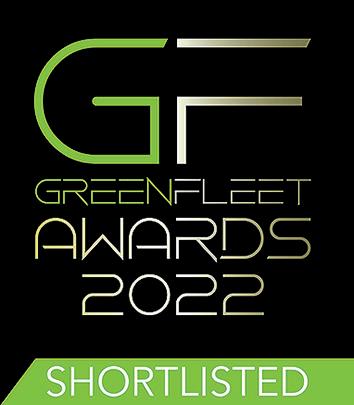
The New Generation DAF XD sets amazing new standards in direct vision and safety for busy urban areas and beyond. The unique cab design is not only stylish and spacious, it also delivers exceptional aerodynamics for unbeatable fuel efficiency and reduced CO2 emissions. Get ready to start the future in distribution.
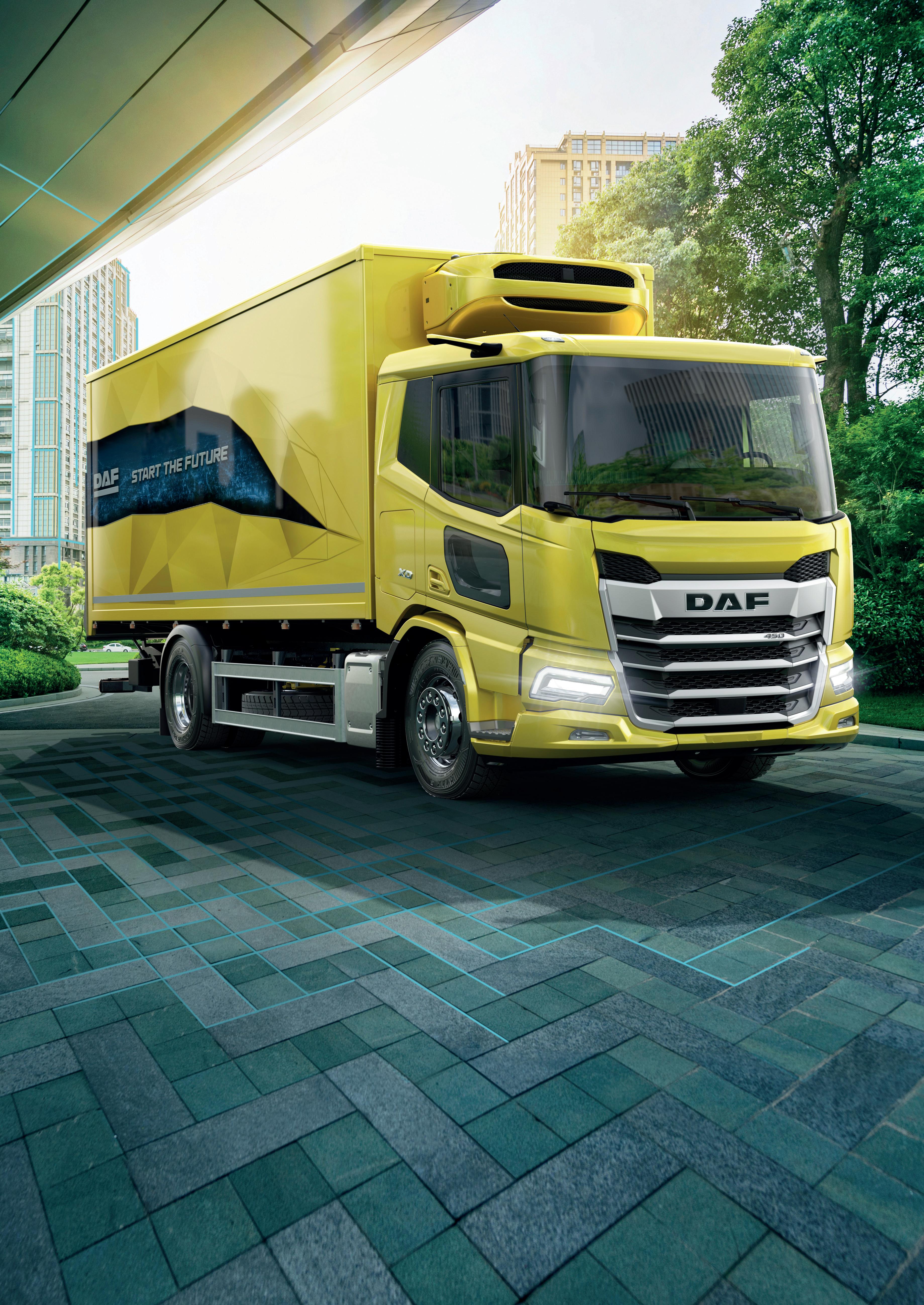
for continuing to break new ground in helping businesses electrify their fleets. Its most recent innovation has seen a transformation in its Webfleet Energy Consumption Report. Fleet managers can not only keep track of the energy usage for every trip made, by every vehicle, but also via a visual, journey trace on a map. Energy efficiency colour coding offers an immediate picture of the energy used. Webfleet OptiDrive driving behaviour data for coasting and constant speed can then be monitored and analysed, alongside the energy consumption insights, to improve driver performance.
Also shortlisted for IT Innovation is Geotab for its part in helping the British Antarctic Survey (BAS) take place. Together with its research ship, RRS Sir David Attenborough, its fleet comprises snowmobiles, snow groomers and tractors, all operating at distances up to 3,000 kilometres away from base. Connecting these vehicles and leveraging their data is a monumental challenge for BAS. Geotab created a customised solution to ameliorate the risks of such situations. Today, BAS has been able to leverage the power of Geotab GO and MyGeotab to fully map out every journey taken by its researchers.
Trakm8 has launched an EV Telematics offering within its Insight platform, specifically enhanced for electric vehicles. Building on the existing suite of vehicular health insights available in Trakm8’s standard offering, such as true odometer readings, service intervals and a host of other diagnostic data points, the newly configured version provides a host of additional datapoints unique to electric vehicles. These include real-time state of battery charge updates so dispatched vehicles can complete the job at hand, and a regularly
updated charge post mapping function.
Coastr has been recognised for its role in digitising the vehicle rental, leasing, subscription, and car sharing ecosystem with its Software-as-a-Service (SaaS) platform for vehicle rental and fleet management. Its unique contactless rental solution enables mobility operators to offer keyless entry to their customers. This project was initially funded by the Innovate UK sustainability grant for delivering a post-covid mobility solution to improve car-sharing across cities.

The GREENFLEET Award for Industry Innovation Award is presented to the organisation that has introduced a new technology, practice or method that reduces emissions and demonstrates innovation in its design and/or implementation.
Drivetech (UK) Limited , part of the AA has been shortlisted for the award for the launch of its two new powerful educational and training support services. EV Co-Driver helps fleet managers and their drivers easily understand how to begin adopting fleet electrification with a series of seventeen online video based modules. Driver’s Mate meanwhile is a new way of communicating with professional drivers, giving them little reminders of their moral and legal obligations before they start their driving shift.
Zemo Partnership has made the shortlist for its Renewable Fuels Assurance Scheme, which addresses a key barrier to the deployment of biofuels. The scheme is a national assurance scheme that verifies claims made from companies of their product’s life cycle GHG emission performance and
feedstock supply chain sustainability.
Allstar Business Solutions is in the running for its One Electric and Homecharge schemes. The One Electric fuel card gives drivers access to on the road public charging with more than 8,600 charge points across a multi-branded EV charging network of 13 CPOs. Though strategic partnerships, Allstar has actively enhanced its offering in the last 12 months, including providing customers with access to the GRIDSERVE Electric Highway locations. Allstar One Electric is also accepted in the Zap-Map app. Combining this proposition with Allstar Homecharge, powered by its partnership with Mina, offers complete visibility of charging and payments on the road and at home.
Dropless has been shortlisted for its Hydroloop system, a new mobile water recycling system that washes large fleet vehicles efficiently and effectively, enabling fleet managers to demonstrate value for money and significant water savings.
Hydroloop is a bespoke closed-loop water recycling system, enabling the company to efficiently jet wash fleet vehicles and then reclaim and filter 95 per cent of the used water. The reclaimed water is pumped through a series of filters which extract the dirt and produce clean water, ready for use again.
Another shortlisted organisation is White Motorcycle Concepts, recognised for its Aerodynamic First Responder Hybrid Motorcycle. White Motorcycle Concepts has engineered an pioneering duct into a first responder motorcycle, reducing drag by 25 per cent and enabling the motorcycle to go further for the same input. The company has also added a detachable battery 5kW electric drive system, supplementing the 300cc petrol engine at low speed where E
installation of a 7kw charging unit. The units come with maintenance included within the monthly price, so it really is a plug-and-play option for businesses.
Northgate is delighted to have been shortlisted for the GreenFleet Mobility Provider of the Year Award.
As a leading vehicle fleet solutions provider, Northgate is proud of its award-winning, industry leading emission reduction programme, Drive to Zero, which provides customers with a full suite of tools and solutions to aid the transition to electric LCVs.
Northgate provides EV industry experts to ensure that it can support businesses, which begins with a thorough assessment of a company fleet and its suitability for electrification.
Northgate builds a complete understanding of vehicle needs, movements, distances travelled and journey times, which allows customers to understand which vehicles can be immediately switched to electric without any other considerations.
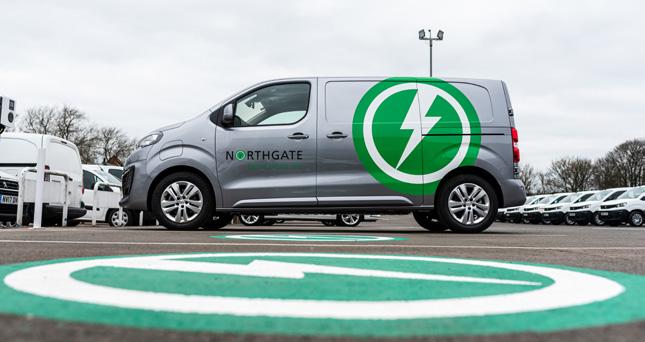
Vehicle choice plays a major part in fleet electrification, and Northgate works closely with OEMs to continually
add to its range of eLCVs. Northgate has a wide selection of brand new eLCVs ready to go, so manufacturer delays needn’t become a hold-up. Technology is evolving rapidly, so being able to swap to the latest models is an important consideration for fleets. Northgate’s flexible hire packages provide the opportunity to change vehicles without being stuck in long-term, inflexible contracts.
The provision of suitable charging infrastructure is crucial to ensuring a smooth transition. Northgate works with leading EV charging installation experts, ChargedEV to ensure that whether a customer needs to consider workplace charging, home charging or even public charging facilities, the best possible solution can be found.
Newly launched, and the only product of its type on the market, Northgate offers rental and charging bundles as part of its 12months+ contract. In addition to Northgate’s full-service rental proposal the bundle includes
Better still, businesses also gain access to an online platform for full visibility of drivers’ charging use and a ‘company wallet’ function which can be used to set charging reimbursement plans.
The change to EVs can seem a daunting one, and so it has a suite of EV training modules available to help address this challenge, helping drivers adopt new driving techniques to optimise EV range free of charge to all its EV customers.
Northgate’s proposition is designed to let fleets focus on their business, whilst it focuses on running their vehicles. L
www.northgatevehiclehire.co.uk
ChargedEV specialises in the supply and installation of Electric Vehicle charging equipment across the UK and having installed over 35,000 domestic and workplace EV chargers to date, it has become the leading independent EV charging infrastructure specialist in the UK.

ChargedEV is committed to helping our customers along every step of their electrification journey, helping them navigate an area that can often be fraught with concern for those new to electrified vehicles.
ChargedEV knows that for drivers looking to move to an EV for the first time, the process of ensuring that the right infrastructure for their needs is installed, at a cost which works for them, and which includes any government grant available, can seem overwhelming. It’s a process that ChargedEV is proud to simplify for its customers.
As a truly independent charging specialist, unallied to any energy supplier or chargepoint provider, ChargedEV offers expert consultancy from the outset, ensuring that we find the right solution for every individual customer, every time.
ChargedEV offers a truly ‘turnkey’ solution, undertaking to manage every aspect of the process from local authority authorisation, groundworks and connection to the local grid supply, to advising on leaseholder agreements, building regulations, installation and maintenance.
ChargedEV knows that now more than ever, efficiency is key, and our consultancy services extend beyond domestic services, to helping fleets manage electrification.
ChargedEV’s experts can calculate business running costs, allowing businesses to set up their own energy tariffs for vehicles or provide free charging for their company vehicles. With detailed cost calculations, ChargedEV can ensure that electrification will work for customers across every area of their lives and businesses.
All ChargedEV installers are qualified to NVQ / Diploma Level 3 and have either gained a recognised 3-year electrical apprenticeship or experienced worker route to entry.
ChargedEV sees the ongoing training, skills and knowledge development of its installation specialists as being of crucial importance for its business. All ChargedEV installers undergo a week of intensive training where all aspects of health & safety, manufacturer specific training and
installation practices (the Code of Practice for Electric Vehicle Charging Equipment Installation, latest edition are covered).
Following this, new starters join a fully qualified EV Installer and set about demonstrating the high expectations we demand of our workforce before receiving a final sign off audit.
After more than 35,000 installations across the UK, ChargedEV’s expertise in these areas is unparalleled. L FURTHER INFORMATION www.chargedev.co.uk
it’s most efficient, then bleeding out the electric drive the higher the speed, where the aerodynamic benefit takes over, meaning the batteries don’t drain really quickly. The overall result is a reduction in CO2 by up to 44 per cent and a fuel efficiency of 104mpg.
Co Charger has been shortlisted for the industry innovation award for finding a way for private chargers to be used by others, as research shows that most are unused for 95 per cent of the time. The idea addresses the challenge that some fleet drivers cannot install a charge point at home. After just 18 months, Co Charger became the third biggest EV charging network in the UK.
EV ChargeSafe has been shortlisted for its 5-star rating system to create a safe and accessible charge experience for everyone. The 90+ inspection points look at site placement, environment, lighting, security, facilities and chargepoint maintenance, with accessibility measures influenced by the PAS 1899:2022 standard published this year.
Fischer Panda UK has been shortlisted for its work with Sky’s Vehicle Technology department, where a system was created so they could be used daily for core functions, such as news reporting with the engine turned off. The new system has helped bring down Sky’s vehicle emissions by an estimated 105 tonnes of carbon over the fleet of 8 vehicles and in practice are generally now operating with zero emissions when on site stationary powering broadcast kit on location.
The Charging Provider of the Year award, sponsored by Paythru, recognises the efforts of vehicle charging providers and the progress made in installing infrastructure to drive the transition to electric vehicles.
ElectrAssure has made the shortlist for its solid reputation for delivering EV charging solutions that provide reliable, scalable support for its clients. In 2021, ElectrAssure was selected from a pool of all the major names in the EV charging market to provide critical charging for National Grid’s operational fleet. At over 300 sites and 1,600 charging units, the contract will take up to five years to complete.
The Energy Superhub Oxford by EDF Renewables UK & Oxford City Council
has also been shortlisted for the award.
The Energy Superhub Oxford is home to Europe’s most powerful electric vehicle (EV) charging hub at Redbridge Park & Ride. Unlike any other charging hub in the UK, the site is directly connected to National Grid’s high voltage transmission network. It currently offers fast to ultrarapid charging for 42 vehicles at once, all powered entirely by renewable energy.
InstaVolt’s network has also made the shortlist, for its extensive network powered by renewable energy. The business was the first UK network to launch contactless payments with a transparent pence-perkWh price – free from registration or usage fees. What’s more, the company has an unrivalled 99.8 per cent network reliability.
Joju Charging has seen a year of exceptional growth, increasing projects sold by 230 per cent. In recognition of this, the company has been shortlisted for the Charging Provider of the Year award.
Joju is working with over 100 different local authorities, councils, and other public bodies on various charging projects, from scoping studies through to EV infrastructure installation and after care. In the past year, it has completed 1,300 more projects.
Vital EV Solutions, who is the appointed UK distributor for Kempower DC EV chargers, is also in the running for the award. Vital EV is able to offer a wide range of chargers, from mobile DC units to pantograph systems. Its hub-and-spoke charging solution is modular and allows fleets to costeffectively scale their charging infrastructure over time. The company’s S-Series unit offers the highest power-to-footprint ratio on the market (up to 400kW from less than 1m2).
Mer Fleet Services makes the shortlist for its growth and expansion this year.
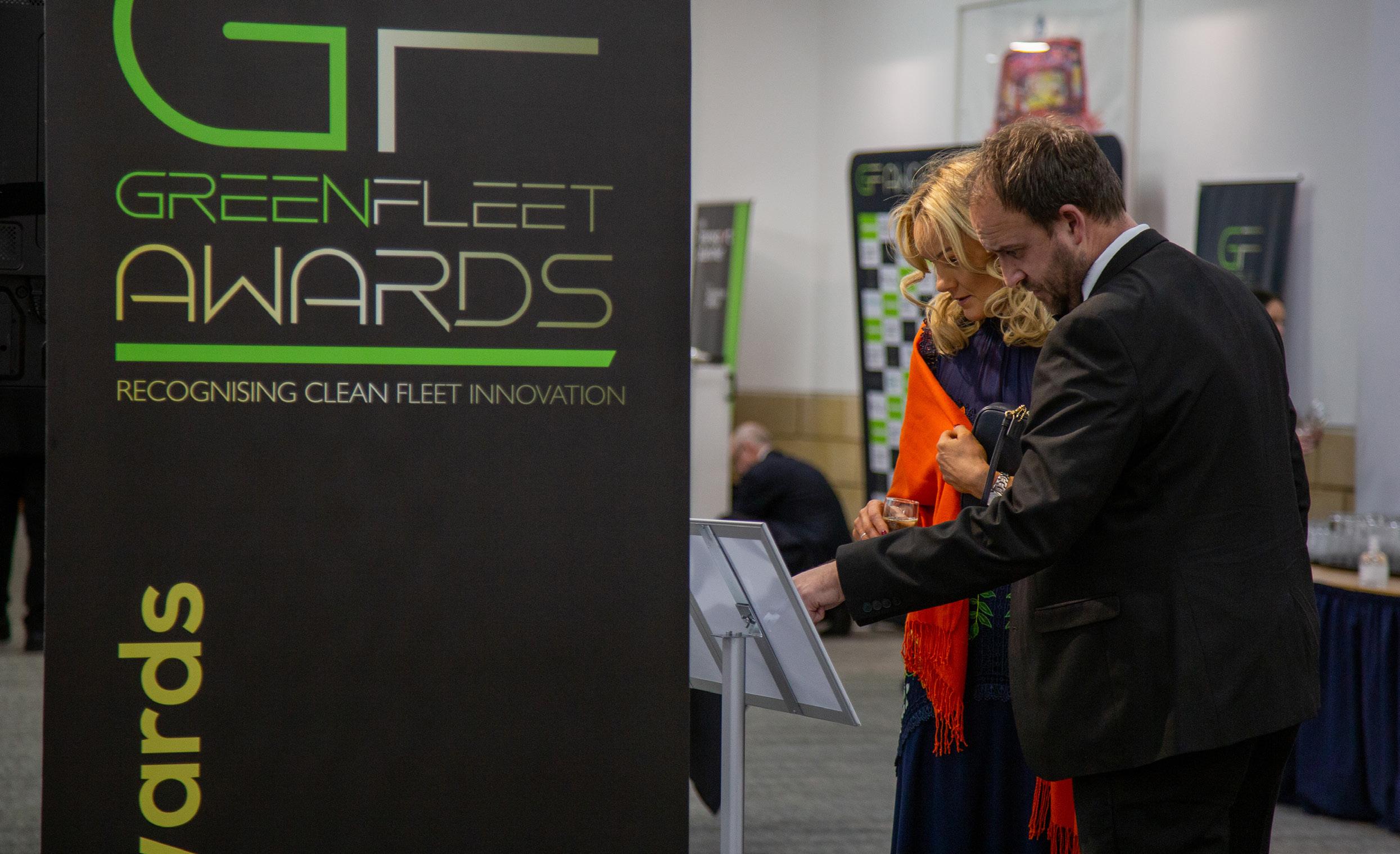
Owned by Statkraft, Europe’s biggest producer of renewable energy, Mer significantly expanded its UK operations with the acquisition of Elmtronics in 2022. The company offers active load balancing technology, which makes the most effective use of the available power on each site, often preventing the need for expensive DNO upgrades. Mer Connect, meanwhile, enables organisations
to set flexible tariffs on workplace chargers. Key client wins in the past year include Asda, DX Group and Tarmac.
The shortlist for Charging Provider of the Year also includes ChargedEV, which specialises in the supply and installation of electric vehicle charging equipment across the UK, having installed over 30,000 domestic and workplace EV chargers to date.
Another contender is ChargePoint who offers charging across home, ‘near home’, workplace and public routes and has a truly integrated back-office solution providing payment solutions, capacity management, load balancing, management information and much more in one robust, easy to use system.
The HGV Manufacturer of the Year Award recognises advancements in the Large Goods Vehicle Sector (Over 7.5 Tonnes).
DAF Trucks’ growing family of all-electric commercials has ensured that the company has been shortlisted in this category.
Amazon UK has taken delivery of five 37tonne CF Electric tractor units for its middle mile delivery fleet. The CF Electric has an all-electric driving range of around 124 miles and through smart battery charging, customers can travel up to 310 miles a day.
Iveco has also been shortlisted in the heavy goods category, recognising its expertise in developing alternative fuel vehicles. The Iveco S-Way is an established workhorse in the LGV segment, and the Iveco S-Way Natural Gas is powered by a 453bhp Cursor 13 engine, that when run on bio-methane, has a carbon reduction of up to 95 per cent versus a conventional diesel truck.
Mercedes-Benz Trucks, which is responsible for all Daimler Truck products sold in the UK, including Fuso trucks, is on the shortlist, hoping to continue its success after winning the 2021 GreenFleet LGV Manufacturer of the Year Award. In September, three new e-trucks were announced; the Next Generation Fuso eCanter comes in 42 configurations, with up to 125 miles of range; the eActros 300 4x2 tractor; and the new eActros LongHaul has a 600kWh battery capacity and a range of up to 310 miles. E
Nottingham City Council has declared a climate emergency and implemented a carbon reduction action plan with the core aim of making the whole of Nottingham carbon neutral by 2028 (CN28). A key part of its contribution towards achieving CN28 focuses on decarbonising its vehicle fleet which, in 2016, accounted for 18 per cent of the Council’s total CO2 emissions. Since then, the Council has made significant progress in this area, with 243 vehicles now fully electric – over half of its fleet.
The fleet includes the UK’s first fully electric compact sweeper, minibus and cage tipper, as well as the world’s first OEM electric refuse collection vehicle.
To help share its lessons learnt and facilitate the uptake of ultra-low emission vehicles (ULEVs) and electric vehicles (EVs) by public sector organisations across the UK, the Council created a Public Sector ULEV Procurement Framework. The framework covers the purchase of ultralow or zero-emission cars, vans, sweepers, minibuses and Hackney Carriage taxis up to 7.5t. It provides access to an OJEU compliant process which purchasing authorities can use to access vehicle specifications that have been created by
industry experts and have been proven to work in a local authority setting, offering security to purchasers that the vehicles can operate effectively in a real-world environment. As part of this framework, the Nottingham team will guide purchasers through the entire process, advising on anything from the vehicles themselves through to charging infrastructure, maintenance, driver buy in and operation. The Council’s fleet decarbonisation journey and support via the framework is a continuation of the pioneering transport measures introduced by the Council. Arguably the most innovative
transport scheme introduced is the Workplace Parking Levy (WPL) as a congestion capping scheme. Since its introduction in 2012, the WPL has helped Nottingham invest over £1 billion into sustainable transport in Nottingham; reduce congestion growth by 47 per cent; reduce emissions across the city by 58 per cent and generated annual savings of £15.4 million for businesses and the local area. With the WPL being the first of its kind in Europe, coupled with growing demand by central and local governments for measures which tackle congestion, air pollution and greenhouse gas emissions, the Council have begun consulting with other local authorities to assess the viability and benefits of introducing their own WPL schemes.
Nottingham is a leader in transport innovation and the Council is keen to help other urban areas benefit from its learning to help decarbonise the UK quickly and improve air quality for all. L
transportnottingham.com
deliver projects with minimal environmental impact, of which site deliveries play a vital role. This significant investment in new electric vehicles demonstrates our commitment in helping our customers achieve these aims.”
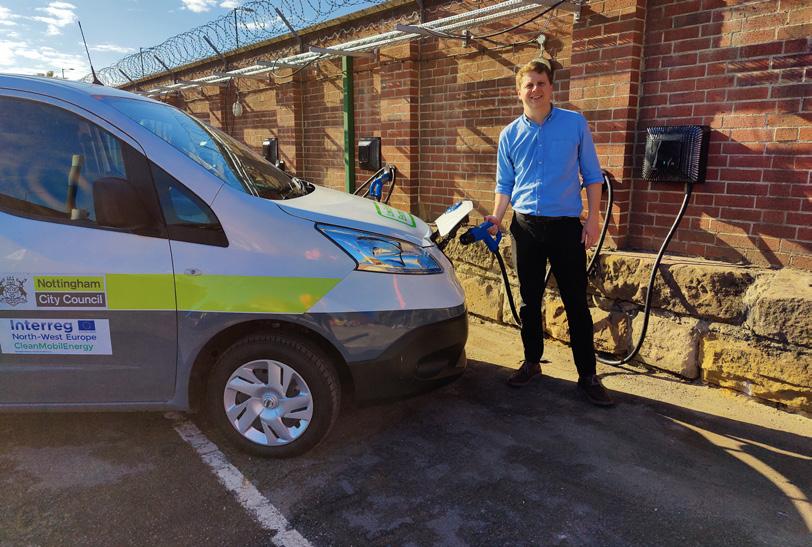
The latest initiative is part of Speedy’s plan to becoming a net zero business, they also aim to help contractors reduce their supply chain emissions through zero carbon equipment delivery and running the heavy fleet on HVO whilst also delivering HVO to their customers.
Speedy has ordered 100 4.25-tonne single chassis cab Ford E-Transit models and 50 3.5-tonne E-Transit vans, which will be distributed across its UK-wide network to replace internal combustion engine (ICE) within the fleet. Transforming the fleet with low and zero carbon models is crucial to them leading the hire industry’s journey towards decarbonisation and aligns with their strategy of de-carbonising its property network and expanding its lowemission ECO tools and equipment range.

Chris Dempsey MD Operations states “The Speedy strategy supports our customer’s sustainability objectives as they strive to
Speedy’s Fleet Director Aaron Powell has been instrumental in creating our strategic road map to net zero. Powell sates, “the business is looking to cut its carbon emissions, and unnecessary travel of all vehicles in our fleet. Speedy’s aim is to reduce commercial travel year on year”.
Speedy are already operating 4 fully electric commercial vehicles in central London with an industry first full EV 27t HGV, and 2 x

3.5t Maxus panel vans, and the first 4.2t E transit chassis cab. Speedy also have an industry first half box half curtain full EV Maxus running out of its Leeds Superstore, which is designed to carry all its core products, including ladders and stagging boards.
One of the main initiatives Speedy introduced over the last year is to reduce travel by company car and grey fleet drivers, this has produced cost savings in recorded mileage claim and reduced overall Co2 as a business. L
FURTHER INFORMATION www.speedyservices.com
FURTHER INFORMATION Renault Trucks joins the running for the HGV Manufacturer of the Year Award. The company’s factory in Blainville has been mass-producing medium-duty 100 per cent electric trucks since 2020, and celebrated production of 1,000 such vehicles in October 2022. The company is also expanding its all-electric range, announcing the start of sales for two new models of up to 44 tonnes – the T E-Tech for regional transport and the C E-Tech for the construction industry.
Scania has also been shortlisted for its battery electric vehicles as well as its work with hydrogen and fuel cell solutions, while Volvo Trucks is in the running for its electric LGV vehicles which has proved popular in companies such as DFDS, the Norwegian Postal Service and Amazon’s fleet in Germany.
LCV Manufacturer of the Year Award LCV Manufacturer of the Year award recognises the efforts made by manufacturers to reduce CO2 and increase fuel economy in the Light Commercial Vehicle Sector.
Citroën has made the shortlist for launching the latest version of the all-electric e-Berlingo van, as well as securing fleet deals and updating its products. The new e-Berlingo Van Electric is available as either a Panel Van or Crew Van, with a range of 171 miles, and a choice of two different body lengths on Panel Van versions.
Ford Pro has made the shortlist for its solutions that combines software, charging, servicing and financing for commercial vehicles. This first-of-its-kind venture in the
CV sector helps customers manage their fleets with convenience and efficiency.
Harris Automotive Distributors, the company that distributes Maxus vehicles, has been recognised for its three eLCVs – the T90EV, an electric commercial pickup, the eDeliver 3 and the eDeliver 9 electric vans. What’s more, in 2022, Maxus launched a multi-million EV Support Programme to encourage and support fleet buyers to switch to electric motoring.
Iveco has also been shortlisted in recognition of the launch of the eDaily, as well as its extensive range of Daily CNG vehicles. Iveco LCV customers now have a broad choice of powertrains encompassing efficient diesels, natural gas, and all electric.
Peugeot has put in place a raft of upgrades to its all-electric light commercial family in 2022. Sitting above its smaller e-Partner and e-Expert stablemates, the e-Boxer van is now available with a larger 75kWh battery and an improved range of up to 154 miles (WLTP). This is an increase of 15 miles over the previous 70kWh version, and has no effect on cargo volume of between 8 and 17m3. Payload is up to 1,150kg. The new battery is mated to a 122bhp electric motor with maximum torque of 258lb ft (350Nm).
Renault Pro+ is up for the award for the arrival of its brand-new Kangoo and all-electric Kangoo E-Tech Electric compact van, while Toyota Professional has been recognised for its new Corolla Hybrid Commercial.
Vauxhall meanwhile comes to the 2022 GreenFleet Awards as the 2021 LCV
Manufacturer of the Year winner. In 2022 it has done much to consolidate on its victory last year. During the first half of the year, the mid-sized Vivaro Electric van was the the best-selling e-LCV in the UK, with over 2,649 vehicles sold. That success has continued, the Vauxhall electric light commercial notching up 3,254 registrations to the end of October.
The Fleet Car Manufacturer of the Year Award is presented to the car manufacturer that has improved CO2 ratings of its standard fleet offerings and expanded the range of zero and ultra-low emission options available to fleet customers.
The shortlist for this category includes BMW, Citroën, Cupra, Hyundai, Kia, Nissan, Peugeot and Vauxhall.
The BMW fleet car portfolio is recognised for the inclusion of the i4, a model which sits at the heart of the brand itself. A four-door ‘gran coupé’, the all-electric model is based on the popular 4 Series, but packs an 83.9kWh battery underneath its stylish body, along with the fifth-generation of BMW’s eDrive technology. The very popular 3 Series has also been revised, with styling updates and a range of powertrains including mild-hybrid and plug-in hybrid options.
Citroën has gained attention for its fleetattuned products, such as the diminutive – and distinctive – Ami electric quadricyle and last-mile’ Ami Cargo, plus the new e-C4 X with range of over 200 electric-only miles. E
under-utilised asset, and the ‘Chargee’ gets all the benefits of a home charger – just with a longer walk to their front door. What does this mean for fleet operators? More vehicles starting every shift with a full battery; fewer vehicles needing to stop to charge; more predictable, reliable and efficient fleet operations; lower costs; and better driver wellbeing and retention.
One of the greatest challenges facing fleet operators is that of charging returnto-home electric vehicles. With most drivers unable to have home charge points the majority are dependent on unbookable, expensive and unreliable public charge points. The result is that each return-to-home vehicle can lose dozens of hours and thousands of pounds every month on finding, waiting for and using public chargers during working hours. Operations become chaotic, costs rise and drivers become frustrated.
The commercial, legislative and cultural pressure to decarbonise fleets is relentless, yet these problems have put the brakes on electrification for many companies.
Co Charger, the UK’s Community Charging platform, provides an immediate, easy solution. By enabling more drivers to charge off-shift while at home, it dramatically reduces dependency on public charge points. It is the new “must-have tool in the box” for fleet electrification.

The concept is simple: while the UK has over 30,000 public charge points, it has over ten times as many private ones – mainly in residential areas, extremely reliable, and used less than once per week. Co Charger simply enables the owners of those home and business charge points to rent them on a bookable, dependable and simple basis to neighbours who cannot have their own. The ‘Host’ makes money on their
Most UK residents live within a mile of one of Co Charger’s thousands of registered hosts, which means the opportunity is there to make an immediate improvement for existing drivers of EVs. It’s easy to start and costs nothing to set up: Just get in touch with Co Charger and they will help to get you up and running. They will help you –free of charge – to identify the drivers already near hosts, to get those drivers up and running, and to progressively electrify your fleet using Co Charger. No hidden costs; no catches, contracts or tie-ins. It really is that simple!
INFORMATION co-charger.com/fleets www.youtube.com/ watch?v=DrhWMnac95E
Cupra joins the line up for its highly efficient models, strong residual values and impressive TCOs - plus seventy-five per cent of the range is now available with a PHEV or BEV powertrain.
Hyundai got 2022 off to a good start with fleet awards for the new all-electric Ioniq 5, which was swiftly followed by upgrades to make the car even more appealing. Enhanced with a new 77.4kWh battery, an optional conditioning feature for enhanced charging times was also added.
Kia makes the shortlist for the fleetpopular models introduced in 2022 such as the Sportage SUV, Niro, and Soul EV, while Nissan makes the shortlist for its two new products, Townstar and Ariya, as well as for its new Public Sector Specialist role. It has also simplified its structure and processes to match the various fleet sub-channels making it easier to do business with, and better able to meet a range of fleet needs.
Peugeot’s wide range of electric and electrified cars have seen the company attract fleet orders in 2022, such as AA Driving School, Onto, and Furniture Village, and Vauxhall’s inclusion is in recognition of its popular electric cars such as the Corsa Electric and Mokka Electric.
The PHEV Manufacturer of the Year award is presented to the manufacturer of either a commercial or consumer PHEV that has demonstrated the best performance and best suitability for purpose in its class.
BMW is recognised for its plug-in hybrid models, such as the very popular 3 Series, with the two-wheel drive 330e, and all-wheel drive 330e xDrive offering CO2 emissions of 30-37 and 33-42g/km respectively. The completely re-engineered and restyled 2 Series Active Tourer features also features a raft of mild hybrid and plug-in hybrid engines.
Citroën has strengthened its plug-in hybrid family in 2022 with new and technologically improved versions of familiar models, such as the C5 X and the new C5 Aircross.
For Kia, 2022 has seen many new launches add even more versions of PHEVs to entice fleet drivers. The ever-popular Sportage has been relaunched and features a PHEV variant and the second-generation Niro builds on the many strengths of its predecessor, offering a family of hybrid, PHEV and EV models. The XCeed PHEV has also been refreshed in 2022.
Mazda joins the plug-in hybrid fray with the all-new CX-60 PHEV, which features the company’s first plug-in hybrid powertrain with a Skyactiv-G 2.5-litre four-cylinder petrol engine with a 100kW electric motor and a 17.8kWh battery.
Meanwhile 2022 has seen Peugeot launch the all-new 308 and 308 SW to UK fleet drivers. The family car comes in hatchback or estate (‘SW’) body styles, with the option of a plug-in hybrid model, adding to the French car maker’s portfolio of PHEVs which includes the 3008 Hybrid4 SUV, and the 508 Hybrid fastback and estate.
Vauxhall also makes the cut for its new plug-in hybrid models such as the Grandland
PHEV, with 221bhp plug-in hybrid models available for customers in either GS Line or Ultimate trim. Plug-in hybrid versions of the new Astra and Astra Sports Tourer estate models have also hit the Vauxhall headlines, the 177 and 221bhp powertrains offering an electric range is 42-43 miles.
The Electric Vehicle Manufacturer of the Year Award is presented to the EV manufacturer with the most impressive launches or sales performance over the period.
BMW makes the shortlist for the arrival of new electric models: iX1 SUV, the iX M60, i7 xDrive60, and the i4, which has a range of 365 or 316 miles depending on model.
Ford Pro makes the shortlist for its Ford Pro solutions which combine software, charging, servicing and financing for commercial vehicles, providing customers with one comprehensive platform to operate their fleets. Led by the iconic Transit family, Ford Pro is helping to ease customers’ transition to electric fleets with its range of capable, all electric CVs, designed to increase productivity and sustainability without compromise.
Maxus, distributed by Harris Automotive, is recognised for its commitment to electrifying the LCV sector. Both Maxus’ eDeliver 3 and eDeliver 9 vehicles perfectly illustrate Maxus’ focus on diversification, customisation and reputation and offer outstanding performance, high efficiency and superb reliability. 2022 saw Maxus build on its family of EVs with the launch of the UK’s first fully electric pickup, the T90EV, as well as the world’s first fullsize, pure electric MPV, the MIFA 9, which offers a range of up to 323 miles (NEDC).
Kia’s electric ambitions have gathered pace in 2022, with the arrival of the EV6 and its subsequent winning of the coveted Car of the Year prize. The all-electric crossover can travel up to 328 miles on a single charge, and using high-tech 800V charging technology can refill its 77.4kWh battery from 10 to 80 per cent in 18 minutes using a high power charger.
Mercedes-Benz joins the line up for the premium electric vehicles added to its already large family of models, and for its truck division introducing fully electric versions HGVs, too. Mercedes’ electric car brand Mercedes-EQ presented its first all electric luxury SUV with space for up to seven people – the EQS SUV. Meanwhile, the Mercedes-AMG EQE 43 4MATIC and EQE 53 4MATIC+ have pushed the batteryelectric performance model to new extremes, while the announcement of the EQE SUV showed what a multi-purpose variant of the EQE executive saloon looks like.
Now owned by Chinese automotive manufacturer SAIC Motor, MG Motor has gone from strength to strength in 2022. Already popular with fleet drivers thanks to the all-electric ZS compact SUV and MG5 EV estate, as well as the MG HS PHEV, the brand sold over 38,300 cars in the first nine months of 2022, making it the UK’s 12th most popular manufacturer.
This looks set to continue with what is arguably the launch of the company’s most important car in recent times, the MG4 EV.
Nissan now offers an electrified option across its entire UK passenger cars range.
Launched earlier this year, the new Ariya is available in two grades, and in three different battery and powertrain combinations:
2WD 63kWh or 87kWh, and e-4ORCE AWD 87kWh, with a range of up to 329 miles.
Nissan also continues to help fleets transition to electric commercial vehicles. Its all-electric Townstar builds upon its brand small van legacy and the e-NV200, a pioneer in the e-LCV market.
Vauxhall’s electric model success has continued from 2021, with more registrations for its EV passenger cars – the Corsa was the UK’s best-selling car of 2021 and looks to repeat this success in 2022. Already the most popular supermini of 2022, Vauxhall’s small car family includes the Corsa Electric, which is powered by a 134bhp electric motor and 50kWh battery, giving it a range of up to 222 miles (WLTP).
At the other end of the Vauxhall portfolio is the new Combo Life Electric and Vivaro Life Electric, based on the company’s wellproven light commercials. With ranges of 174 and 143 miles respectively, they offer practicality and passenger carrying ability.
Introduced in 2021, GREENFLEET’s Vehicle of the Year award recognises the environmentally-sound car, van or truck that has made the biggest impact on the UK fleet sector in 2022.
This year’s award, sponsored by The Algorithm People, have eight vehicles shortlisted: BMW’s i4; Ford Pro’s E-Transit; the Maxus eDeliver 9; the MercedesBenz eActros; MG Motor’s MG4 EV; the Nissan Ariya; and the Vauxhall Vivaro-e.
GREENFLEET’s Award for Outstanding Achievement, sponsored by the Algorithm People, goes to an organisation or individual that has been championing the decarbonisation agenda for years and has made excellent progress in reducing the environmental impact of their fleet, or have shown great innovation in transport decarbonisation.
Last year, Mitie won the GREENFLEET Award for Outstanding Achievement for its work with electric vehicles, which began back in 2018. Mitie is now sharing its expertise with other businesses to help them transition to an electric fleet, through its Plan Zero Fleet Transition Service.
In 2020, Nissan GB scooped the award for helping key frontline NHS staff get to and from work, in a safe and efficient manner, during the first coronavirus lockdown.
There is no shortlist for this category, with the winner announced on the night. L
For more information on the shortlist visit www.events.greenfleet.net
ChargePoint solutions operate across home, ‘near home’, workplace, and public routes to provide charging with a truly integrated back-office system, providing payment solutions, capacity management, load balancing, management information and much more, in one robust, easy to use system

financing and subscription offer the ownership control needed to maximise value and minimise overhead costs.
Too often organisations think about fleet electrification as revolving around vehicles. This is understandable given that is the historic focus of the fleet function and industry, but in the world of electric vehicles this is no longer the biggest challenge. The larger challenge is infrastructure, having an integrated energy system which allows charging in every use case, whilst supporting the change in driver awareness and behaviour to operate effectively and safely in this new world.
At ChargePoint, we make fleet electrification easy for customers. ChargePoint solutions operate across home, ‘near home’ (for those without home charging ability), workplace and public routes to charging with a truly integrated back-office solution, providing payment solutions, capacity management, load balancing, management information and much more in one robust, easy to use system. We achieve this through our comprehensive charging infrastructure solutions – such as the latest product, CP6000 – which seamlessly unifies network software, station hardware and customer support.
When it comes to an overall EV strategy, our vertically integrated approach to charging infrastructure allows customers to optimise hardware, software, and services configurations, from initial pilot to full adoption and lifecycle management, for continuous improvement as they scale. Our charging hardware solutions are purpose-built for best-in-class reliability and performance, while our software provides unmatched visibility and station management in real-time, ensuring maximum uptime for charging stations.
There are plenty of infrastructure solutions which work well in one of the charging routes, such as home, workplace and public, or that provide back-office support or payment solutions
for public charging needs. What makes ChargePoint unique and the optimal solution for fleets to meet their infrastructure needs is the coverage across every part of this ecosystem. Our charge management software is compatible with all charging stations and vehicles regardless of manufacturer, simplifying electric vehicle management and ensuring operational readiness at the lowest fuelling cost. It also combines fleet management tools with vehicle telematics and charge management to provide complete visibility with real-time monitoring and role-based alerts. This purpose-built integration with existing fleets can be done at scale and in a way that minimises operational disruption to ensure customers have the same operational control before and after electrifying.
As well as optimised software management, we offer fleet managers scalability, flexibility and reliability. Today, fleets need to charge at all types of locations, whether enroute, at-home or in the depot/distribution centre, each of which is covered by our charging infrastructure. We allow customers to schedule charging of assets through complex mapping algorithms, while managing home energy disbursement, billing integration and enroute charging with roaming across networks.
When it comes to cost, we help customers to unlock the lower total cost of ownership (TCO) for electrification and modernise fleet operations in the most cost-effective way possible. Our unmatched coordination with existing fleet management tools is designed to ease the transition and lower TCO, while our long-standing interoperability testing with an unrivalled network of OEMs ensures peak performance across vehicles and technology. Options for as-a-Service
Finally, ChargePoint’s always-accessible support is best-in-class – from the ChargePoint app, which has over 200,000 active places and 355,000 public places to charge, to around-the-clock technical station monitoring and maintenance, specifically designed to meet the needs of essential fuelling operations and ensure maximum uptime. Our charging infrastructure provides ready access to EV charging station status, meaning station health can be monitored in real-time, while reporting options can provide deeper visibility into ongoing performance. Driver support is available in multiple languages and currencies, allowing drivers to easily find, use and pay for the charge they need.
A transition to electric mobility Overall, we have established category leadership results in efficiencies for planning, deployment, scale and lifecycle management, which reduces complexity and cost at every step of the fleet electrification journey. Built on a decade-plus of experience serving EV drivers and all types of organisations, ChargePoint’s charging infrastructure is designed to prepare global businesses for the next wave of fleet EV adoption.
ChargePoint has a long history of helping global and local companies electrify their fleets. In Europe, we are now present in over 16 countries with full expert design/ build services, engineering, support, marketing and sales staff. We believe that the rapid transition to electric mobility is essential to building a sustainable future for all. After more than 15 years, our mission remains the same – to create technology that will enable the movement of all people and goods on electricity.
Should you want to hear more about our solutions and take advantage of our vast experience in the charging industry, please feel free to reach out to the team below. L
FURTHER INFORMATION
sales.uk@chargepoint.com www.chargepoint.com/en-gb
by Joe Gorman, UK director of sales for the UK & NordicsWhilst there are many challenges to be addressed with the electrification of transport, it was also noted during the GreenFleet Roundtable at The OEC in Sheffield in November, that diesel costs are quietly creeping up again. A sobering reminder, that the business case for net zero fleets is continually evolving
Fleet managers and industry professionals gathered at the OEC in Sheffield on 3 November to discuss the barriers to fleet decarbonisation and to share best practice on ways arround the barriers.


An aspect of fleet electrification that is evolving is staff retention – and it appears that EVs can have a polarising effect. Steve Openshaw, group fleet and transport manager at Eric Wright Group reported that some employees are leaving because they don’t want to drive an EV, whereas, some fleets such as BT Openreach are using EVs to attract employees.
There is an opportunity here for businesses to position themselves in the market according to what type of employees they want to attract.
The charging infrastructure puzzle
Charging infrastructure is a regular roundtable topic, and Sheffield was no exception. Paul Edwards, fleet manager at Sheffield City Council reported that infrastructure has been the biggest problem; whereas vehicle choice and performance is getting better and better (although still not adequate for our blue lights services). Many fleets are opting for a “mixed location” charging strategy (across depot, car parks, home and public charging). Sheffield City Council operates a mixed location charging strategy – with one third of vehicles being depot-based and two-thirds home-based.
The cost of energy also differs from location to location and with depot charging becoming more expensive (and facing power constraints) there appears to be a concerted effort to
push vehicles to domestic charging overnight where possible to help control energy costs.
Another benefit of home charging is that employees start their day with a “full tank” meaning they don’t need to take time out of their working day to visit a petrol station.
But what happens to the estimated 50 per cent of homes that are not suitable for EV Charging? Or employees that do not want a liveried van on their driveway even if they do have off-road parking?
As the EV Charging market matures, fear of “stranded assets” is growing. This could include employees moving house or leaving the company. Fleets must decide if it is worth the cost of removing the chargepoint from the property and relocating it. Or should that asset be written off and another chargepoint installed at the new house? What happens if an employee moves house, and their new property is no-longer suitable for EV Charging? With all these scenarios there is an additional cost incurred and this needs to be allowed for in the initial TCO calculation.
The question of reimbursing employees that charge at home cropped up in our discussion again. Against a landscape of rapidly increasing electricity costs, the current 5p reimbursement rate for electric vehicles was deemed too low by most of the fleets.
LeasePlan has overcome this by paying the AER plus an uplift of a further 7.5p with their HR team managing the BIK tax implications.
Ashley Tate, CEO at Mina, the specialist reimbursement provider, has developed a certified end to end remuneration service including a full paper trail, something that Steve Openshaw, group fleet and transport manager at Eric Wright Group is currently exploring.
As the EV charging market matures, fear of “stranded assets” is growing. This includes employees with a charge point moving house or leaving companythe
Mina has worked closely with PWC and HMRC to get their solution certified. Mina, has also developed a solution tailored for prepayment meters (common in rental properties) that puts credit directly onto the meter. This is a difficulty that Catherine Hiles, account director for New Business at LeasePlan has come across in her discussions with fleets.
There was also a question about reselling electricity, but concerns were allayed by Ash Tate that Mina is facilitating payment between the CPO and billing solution – they are not reselling electricity.

Almost all the fleets at our roundtable are seeking on-street charging solutions to support employees that were not able to charge their vehicles at home, and there is some frustration at the speed that this is rolling out. Murray Sirel, electric vehicle consultant took us through the Street Fleet solution; a consortium of EV service providers, including Gemserve, that offers a fully funded on-street charging solution, based on data led insights.
And whilst private sector funding is very welcome, the pace of take up appears slow.
Caroline Hearne from Redcar & Cleveland Borough Council explained that all avenues must be explored to ensure the best solutions and commercial terms are secured. There are many new products and business models emerging such as the Gul-e project run by Oxford City Council, and Be.EV in Manchester.
Vehicle procurement continues to be challenging
Long delivery times for new vehicles is continuing to put pressure on fleets. Budgetary constraints in particular were causing issues for both the public sector fleets, as well as utilities who’s budgets are regulated.
Alison Grimes, fleet contract manager at Northern Powergrid explained: “We capital purchase 1,250 vehicles on a seven-year replacement cycle; at the end of the regulated period, we cannot carry capital spend over, making it difficult to extend renewal cycles and we must take delivery of the vehicles within the budget period. Orders being cancelled or
delay has forced them back to petrol/diesel vehicles to fulfil our regulatory requirements.”
Another fleet observed: There is a game of poker going on; buying vehicles now for 18 months’ time. It is impossible to predict capital spend as sometimes the auto OEMs are not guaranteeing prices. Capital programmes also need to make assumptions on residual value. Currently a shortage of second-hand EV and evolving technology makes this difficult.
Catherine Hiles pointed out that leasing solutions, such as that offered by LeasePlan takes the uncertainty of residual value away. And what about the clean air zone that is due to launch in Sheffield in February 2023? LeasePlan is concerned that they are still seeing tenders coming through that have no consideration for CAZs. With Bristol going live at the end of November, and Newcastle and Gateshead going live at the end of January 2023, it appears that some fleets may be caught out. L

An aspect of fleet electrification that is evolving is staff retention – and it appears that EVs can have a polarising effect
Reinvented and rejuvenated, the new Kia Sportage embraces plug-in hybrid technology in its fifth generation. Richard Gooding finds a striking-looking car packed with technology and equipment, with the promise of greatly reduced running costs from its new PHEV powertrain
 Written by Richard Gooding
Written by Richard Gooding
The Sportage name first came to the UK in 1995 as one one of Kia’s first models to land in the country. Now, 27 years later, it’s the turn of the fifth-generation car, this time with an interior designed and developed especially for European drivers. The fourth-generation Sportage was very popular in the UK, and with 27,611 registered in the UK, a mainstay of the top 10 most popular cars chart.
It’s not just this country where the car is popular either – the Sportage is the most popular Kia both in Europe and globally. The number one Kia product in the UK, the all-new Sportage was the number one-selling compact SUV in March 2022, contributing to Kia being named as the most popular brand. The new model family consists of mild-hybrid, hybrid and plug-in hybrid models, with two or allwheel drive, meaning there is something for almost every fleet. We test the new Sportage PHEV here.
Kia quotes the Sportage PHEV being able to travel on electricity only for a distance of up to 43 miles, which is further than many other plug-in hybrids.
Plug the Sportage PHEV into a 7.4kW wall box charger, and the Kia’s 13.8kWh lithium-ion battery can be recharged in one hour and 45 minutes. Charging on a UK domestic socket rated at 2.4kW takes five hours and 27 minutes.
Immediately from the off the all-new Sportage makes an impression. Sharp creases all over the body lend it a much more angular look than the car that went before it. That’s no bad thing, and bold is the watchword for modernera Kia. Pronounced rear wheel arches and a rising window line signify dynamism, while the new arrow-head LED running lights give the 2022 car’s face a real presence. There’s no mistaking it for anything else and it manages to exude both a classy yet rugged appeal. Moving inside, the interior is as stylish as the exterior. The arrow-head shapes feature on the air vents which seem to clamp-hold the twin, gently curving 12.3-inch colour displays. Materials are of a high quality and the whole ambience is one of a premium car. Underneath the left-hand touchscreen is Kia’s new haptic touch control panel shared with the all-electric EV6. Controlling air conditioning and multimedia functions, it can be switched over at the touch of a not-quite literal button. It works extremely well, with rotary knobs that function as volume and temperature controls. It’s one of the most thought-out uses of this technology we’ve found in any car interior.
Out on the road, the Sportage PHEV is impressively quiet, with barely any noise from the 1.6-litre petrol engine entering the cabin at all. All Sportage PHEV models are all-wheel drive, and the Kia SUV handles nicely, with a moderately flat cornering stance. Precise steering means it can be placed easily, too. A common trait with other modern cars, the suspension is quite firm, but
not uncomfortably so and it only really gets caught out over heavier bumps and irregular road surfaces.
In addition to ‘Eco’ and ‘Sport’ driving modes, drivers can also choose between ‘Electric’, ‘Hybrid’, and ‘Automatic’ selections, the latter shuffling power between the other two, but favouring the hybrid mode in most situations. A set of terrain modes are also included, allowing drivers to choose a setting to best reflect the road surface conditions they are driving on.
Kia has packaged the plug-in hybrid battery and motor beneath the cabin to minimise the impact on passenger and luggage space, so the Sportage PHEV is a practical car, too. There is 540 litres of space with the rear seats in place and 1,715 litres if they are folded – 47 and 61 litres down respectively on the full hybrid models – meaning the plug-in hybrid Sportage should be accommodating enough for most.
The Sportage PHEV is available in four trims.
The £39,700 GT-Line kicks off proceedings and comes with 19-inch alloy wheels, keyless entry and start, parking sensors, quilted leather and suede seats, rear privacy glass, three-zone climate control, and smart cruise control. Move up to the £40,900 ‘3’ car and you gain both heated front and outer rear seats, as well as a heated steering wheel.
The £43,100 ‘4’ as tested here features dual LED headlamps, a panoramic sunroof, a Harman Kardon sound system, a remote smart
parking system, wireless smartphone charging, and a host of blind-spot monitoring safety technologies. The range-topping GT-Line S has powered and ventilated front seats, a powered tailgate, and the option of an £800 black twotone roof. A premium paint finish is £650 extra on all models.
The Kia Sportage PHEV qualifies for the £10 Alternative Fuelled Vehicle (AFV) VED discount because with official CO2 emissions of 25g/ km, it is rated as an ultra-low emission vehicle. This discount effectively wipes out its first year registration charge of £10. After that, at the time of writing, drivers of the plug-in hybrid Kia will pay £155 per year with the AFV discount applied. Benefit in Kind (BIK) for 2022-2023 is 8 per cent.
Comprehensively upgraded, the Kia Sportage gains a plug-in hybrid variant for the first time, and it offers fleet drivers the promise of low running costs and an all-electric range, both of which, on paper at least, better that of key rivals. Well-equipped, and with a premiumfeeling interior, the plug-in Sportage is a good
value for money package, too. There really is little not to like, and the Sportage PHEV is a very welcome reinvention of Kia’s most popular nameplate. L

www.kia.co.uk
Kia Sportage 4 1.6 T-GDI PHEV AWD
ENGINE: 177bhp 1,598cc petrol engine / 67kW electric motor / 13.8kWh lithium-ion battery / 261bhp system output
ELECTRIC RANGE (WLTP): 43 miles
MPG (Combined, WLTP): 252 CO2: 25g/km
VED: £0 first-year, £155 thereafter BIK: 8% PRICE (OTR): £43,100 (including VAT, £43,750 as tested)
Firmly believing in its fleet customers, Kia has recently announced a new service solution package across its dealership network. The ‘Kia Business Service Promise’ offers fleets a dealership service labour of £49 plus VAT (service work only), with discounts on parts, MOT costs as well as free vehicle health checks for businesses.
The company believes this will lead to improved residual values thanks to the main dealer servicing aspect and the use of genuine parts. There’s also the added assurance of using qualified Kia technicians, in addition to the latest tools, and a ‘no quibble’ mobility policy to keep fleets mobile if warranty work is required. The latest software updates are also added to vehicles that need them free of charge.
“The Business Service Promise is multifaceted in its approach,” says John Hargreaves, general manager for fleet and remarketing at Kia UK Limited. “Firstly, the highly competitive labour rates ensure Kia dealerships don’t cost a premium over other alternatives. Secondly, fleets can be reassured by fixed costs for typical repair work, and that drivers will be kept on the road. Fleets will also benefit from a main dealer service and repair history, helping with improved residual values.”
The biggest fleet product up to now has been e-Niro, says Hargreaves, taking 13 per cent of fleet sales. Around 6,500 have entered fleets, through a mix of leasing companies and salary sacrifice schemes. Hargeaves believes that the number of electrified fleet registrations will continue to rise. “Fleet totals have gone up six per cent year-on-year from 2021 to 2022, and you have to see that accelerating,” he says. Steve Hicks, sales director at Kia UK agrees. “Demand is probably way more than what we’re planning, because we still have limitations on the amount of PHEVs and fully electrified vehicles we can get,” he says. “I think our mix will be dictated by our ability to get batteries from our suppliers, rather than demand from customers,” Hicks continues.


However, rather than fleet and business customers going straight to all-electric products, some are transitioning through part-electrified cars first. “The mix of EVs is between 17 and 20 per cent,” confirms Hicks. “There is still more demand for hybrids. However, is that supply or is that demand? People tend to go in stages. Niro HEV was hugely popular a few years ago, and a lot of those customers have now switched to E-Niro. They’re on that electrified journey, but some of them are quite happy to go straight from petrol to EV. Everyone is in different stages and I think they’re diversifying their fleets in various ways,” Hicks reports.
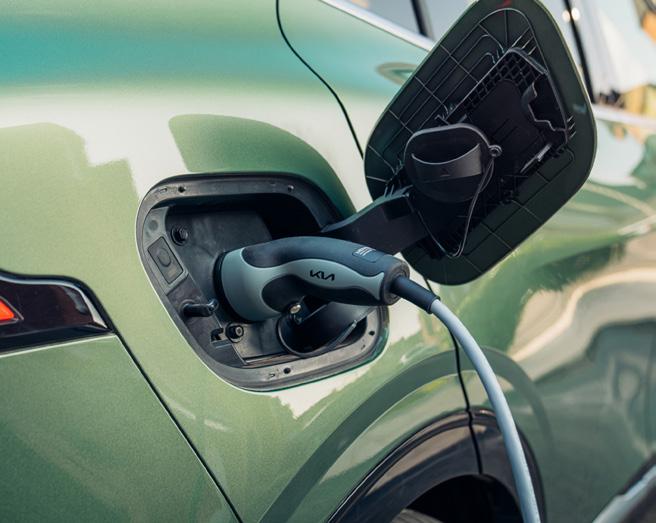
Kia is currently the number one fleet brand in the UK, with a market share of 8.8 per cent, and almost 50,000 vehicles (49,866) registered year-to-date up to the end of September 2022.
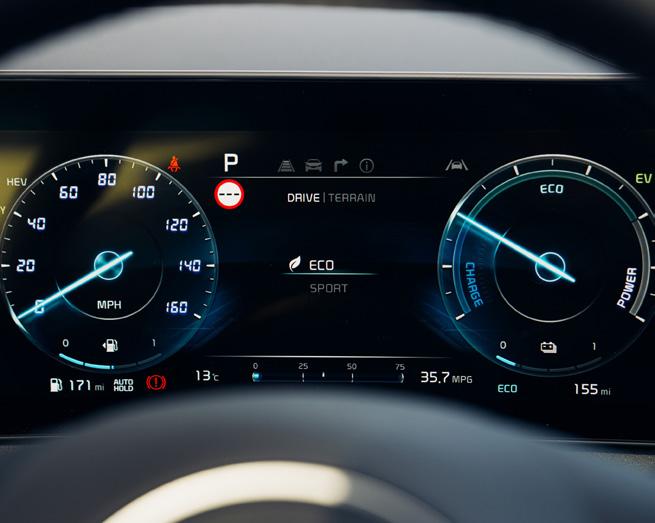
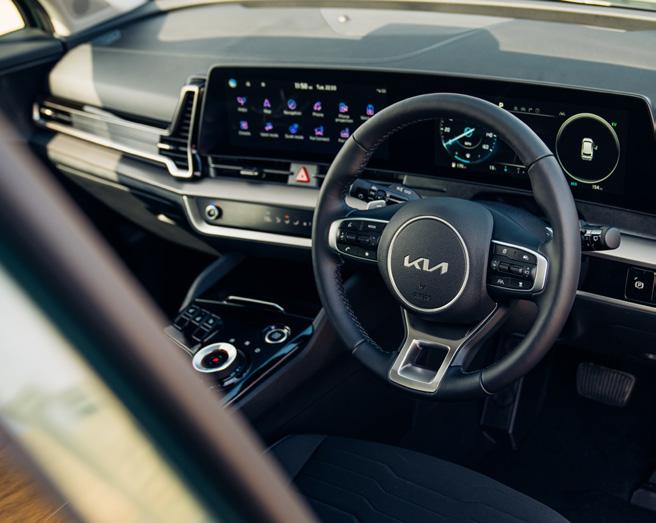
Competing in the highly important C-SUV segment, the Grandland plays a vital role in the UK for Vauxhall. Richard Gooding discovers the improved levels of technology and low emission PHEV powertrain should appeal to fleet drivers and managers alike
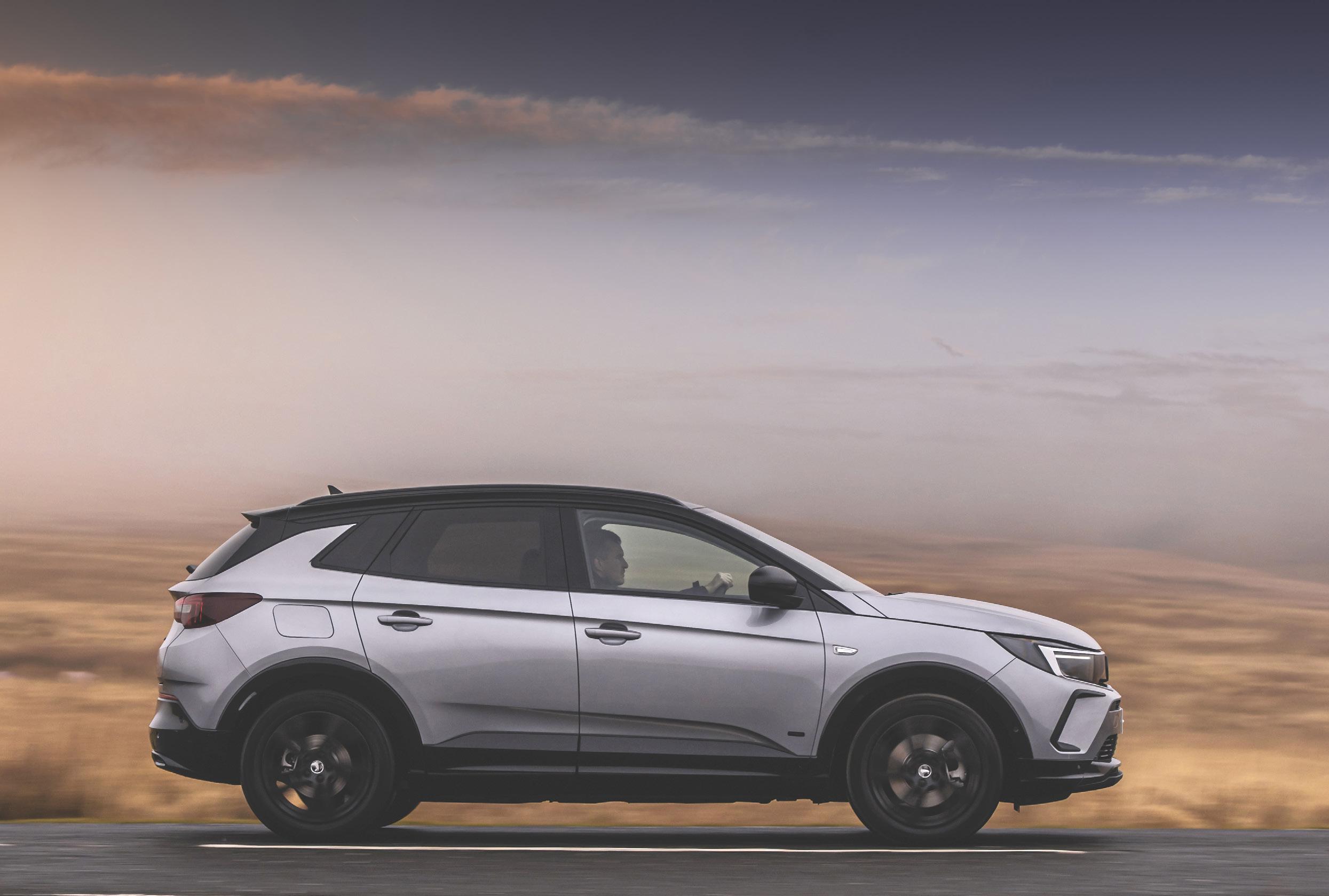
Launched in 2018, the Vauxhall Grandland is a family sized SUV which shares technology with other Stellantis group models, including the Peugeot 3008 and 5008. Then called the Grandland X, a revised model was announced in summer 2021. Once again available with a plug-in hybrid powertrain – as tested here – the Grandland Plug-in Hybride’s ‘Efficient Modular Platform 2’ (EMP2) multi-energy platform is also shared with its non-electrified petrol and diesel siblings.
In line with other cars of its type – a plug-in hybrid with a petrol engine and an electric motor and battery – the Grandland PHEV has a WLTPcertified zero-emission range of up to 39 miles.
Vauxhall quotes a charging time of one hour and 45 minutes to charge the Grandland Plug-in Hybrid-e’s 13.2kWh lithium-ion battery when using a 7.4kW home wall box charger. On a domestic mains socket, that time increases to five hours and 45 minutes. A 3.3kW on-board charger is standard, with a 6.6kW device available as a £500 option.
Externally, the new Grandland has more of a visual impact than before. It wears the latest Vauxhall ‘Vizor’ face, combining a single smooth panel which runs between the LED headlights. This houses sensors and radar for the numerous driver assistance technologies fitted as standard. GS Line and Ultimate-spec cars gain high-gloss black exterior fittings that smarten up the appearance still further.
Interior changes are equally visible. The refreshed Grandland is fitted with Vauxhall’s ‘Pure Panel’ dashboard, as seen on other models such as the Mokka Electric. Effectively two digital
10-inch infotainment display – the set-up looks good and works well. Physical shortcut buttons underneath the infotainment display also mean you’re not needlessly prodding a screen, and we’re also pleased to see similar controls for the climate control.
On Plug-in Hybrid-e models, the central touchscreen shows powertrain information, including an energy flow display, and drivers can also manage the e-Save function. This sets aside a specific level of battery charge to be preserved for later parts of a journey. Preset levels of six, 12 or the maximum EV range can be chosen.
On the move, the 1.6-litre petrol engine offers up good acceleration and is smooth when in default ‘Hybrid’ mode. Two additional driving modes – ‘Sport’ and ‘Electric’ – engage more performance and zero-emissions running, with an additional ‘B’ setting on the eight-speed automatic gearbox for increased regenerative braking. As on other so-equipped Stellantis models, this works well, and you can almost ‘onepedal’ drive.
The Grandland Plug-in Hybrid-e handles neatly enough, but it’s best not to hustle the Vauxhall SUV and enjoy its long-legged refinement. While comfort suffers a little when compared to ICEengined versions due to its firmer suspension, the plug-in hybrid Grandland’s ride is by no means jarring. There are good levels of grip, too, although the extra weight of the PHEV powertrain means a little of its siblings’ agility is lost. All Grandland Plug-in Hybrid-e models are front-wheel drive.
Prices for Plug-in Hybrid-e versions of the Vauxhall Grandland begin at £37,455 for the GS Line model tested here. Standard equipment includes automatic lights and wipers, dualzone climate control, a heated steering wheel, LED headlamps, power folding door mirrors,
Move up to the £41,010 Ultimate and you gain driver drowsiness alert, ‘IntelliLux’ adaptive LED headlamps, keyless entry and start, power operated tailgate, speed sign recognition, a wireless smartphone charger, a 360-degree parking camera, and 19-inch alloy wheels. Unlike the petrol and diesel-engined models, the Grandland Plug-in Hybrid-e isn’t available in entry level Design trim.
How much does it cost to tax?
The Grandland Plug-in Hybrid-e is classed as an ultra-low emission vehicle so qualifies for the £10 Alternative Fuelled Vehicle (AFV) VED discount. This effectively wipes out its first year registration charge of £10. Thereafter, at the time of writing, drivers of the Vauxhall PHEV will pay £155 with the AFV discount applied. Benefit in Kind (BIK) for 2022-2023 is 14 per cent.
Why does my fleet need one?
Neatly and thoughtfully upgraded, the Grandland Plug-in Hybrid-e offers a decent zero-emission range, with a comprehensive standard equipment list, as well as much improved onboard technology. Potentially low running costs promised by the PHEV powertrain should further entice fleet drivers. L
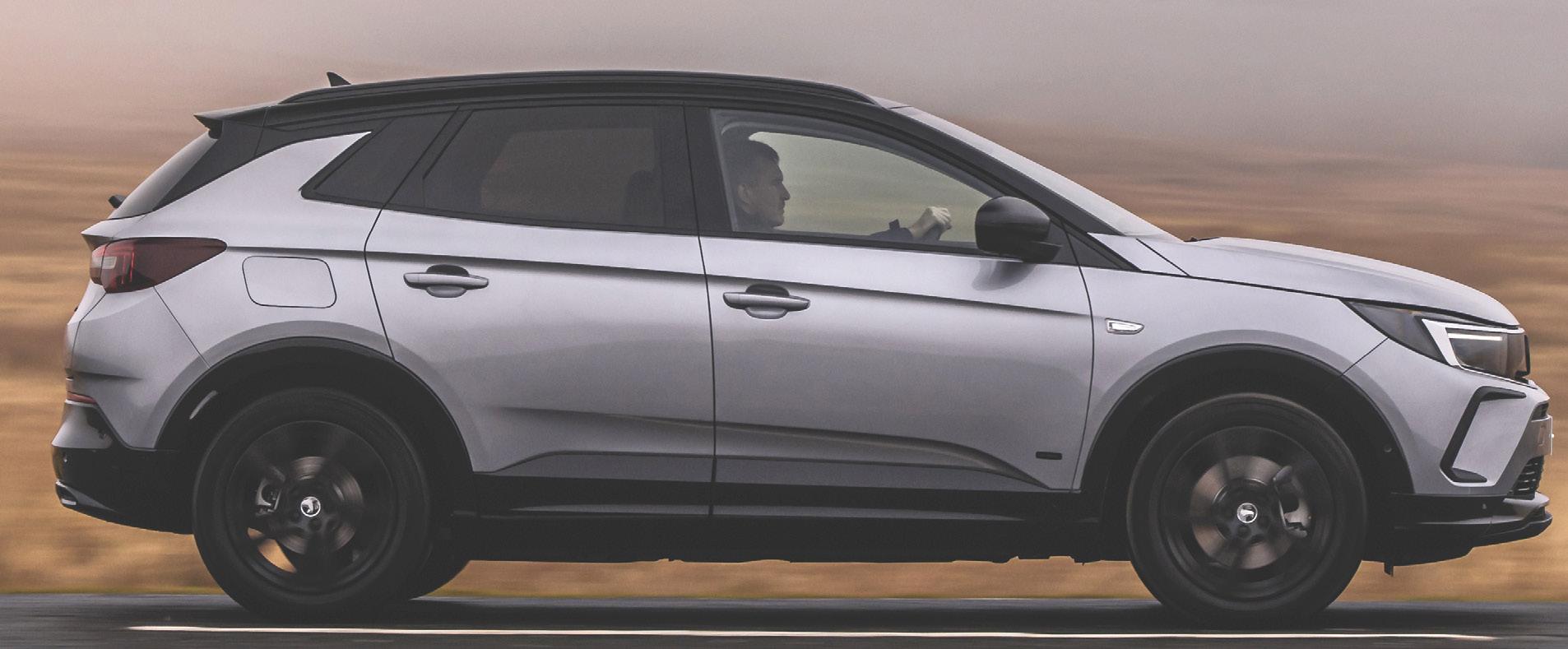
INFORMATION
www.vauxhall.co.uk
ENGINE: 177bhp 1,598cc petrol engine / 81kW electric motor / 13.2kWh lithiumion battery / 222bhp system output
ELECTRIC RANGE (WLTP): 39 miles
MPG (combined, WLTP): 192 31g/km
£0 first-year, £155 thereafter 14% £37,455
Vauxhall Grandland GS Line Plus-in Hybrid-eA hydrogen fuel cell electric vehicle pioneer, the Toyota Mirai has been comprehensively updated. Richard Gooding discovers the all-new second-generation model has a greatly improved driving range as well as many luxurious features
The Toyota Mirai is one of the only hydrogen fuel cell (FCEV) powered cars on sale in the UK, the other being the Hyundai Nexo. The first generation was introduced in 2014, and has proved popular with private hire and professional driver fleets due to the long single refill driving range on offer, which is more than most electric cars currently on sale.
The second-generation model was announced in 2020, landing in the UK in 2021. Based on the new GA-L platform, there are improvements to aerodynamics, responsiveness and refinement, while the addition of a third hydrogen tank allows for an increase in range of 30 per cent.
Toyota quotes an official single refill driving range of up to 400 miles from the Mirai’s three hydrogen tanks that hold a combined 5.6kg/142 litres. To enable range, the on-board fuel cell stack converts compressed hydrogen into electricity. This then powers the electric motor.
Refueling at a hydrogen filling station takes around five minutes and is almost as straightforward as filling up a combustionengined car with fuel. The only downside is that, according to Hydrogen Insight, there are only 11 hydrogen refuelling stations open publicly in the UK.
First impressions of the new Mirai is that while it is much more conventional looking than its predecessor, it is also more handsomely striking. Its gently sloping silhouette is coupélike and it exudes a premium appearance. It’s the same inside, the driver cocooned by the wraparound centre console and faced by an eight-inch digital driver’s display, and a 12.3inch multimedia screen.
It feels very luxurious, just as it should at the price. That luxurious impression continues on the move, with very little wind or road noise entering the cabin on most road surfaces. There’s a little whine from the FCEV powertrain, but on the whole, the Mirai feels just like a conventional EV to drive.
The car generally belies its size and feels smaller than it is. It corners very flatly, and handles well with plenty of grip from the 20inch tyres. There is a weight to the steering which makes for easy placement on the road and allows the car to feel quite agile, despite its near two-tonne kerb weight. The only blots we found were the gear selector, which is an odd shape, and the infotainment system graphics, which look dated.
Toyota gives drivers the option of three Mirai trims. The £49,995 Design model is the entry level model with 19-inch alloy wheels, adaptive cruise control, dual-zone climate control, a JBL Premium sound system and Toyota’s Touch 2 with Go Navigation system. Upgrade to the £53,995 Mirai Design Plus and gain a blind spot monitoring system, heated front seats, parking sensors, a reversing camera, and synthetic leather upholstery.
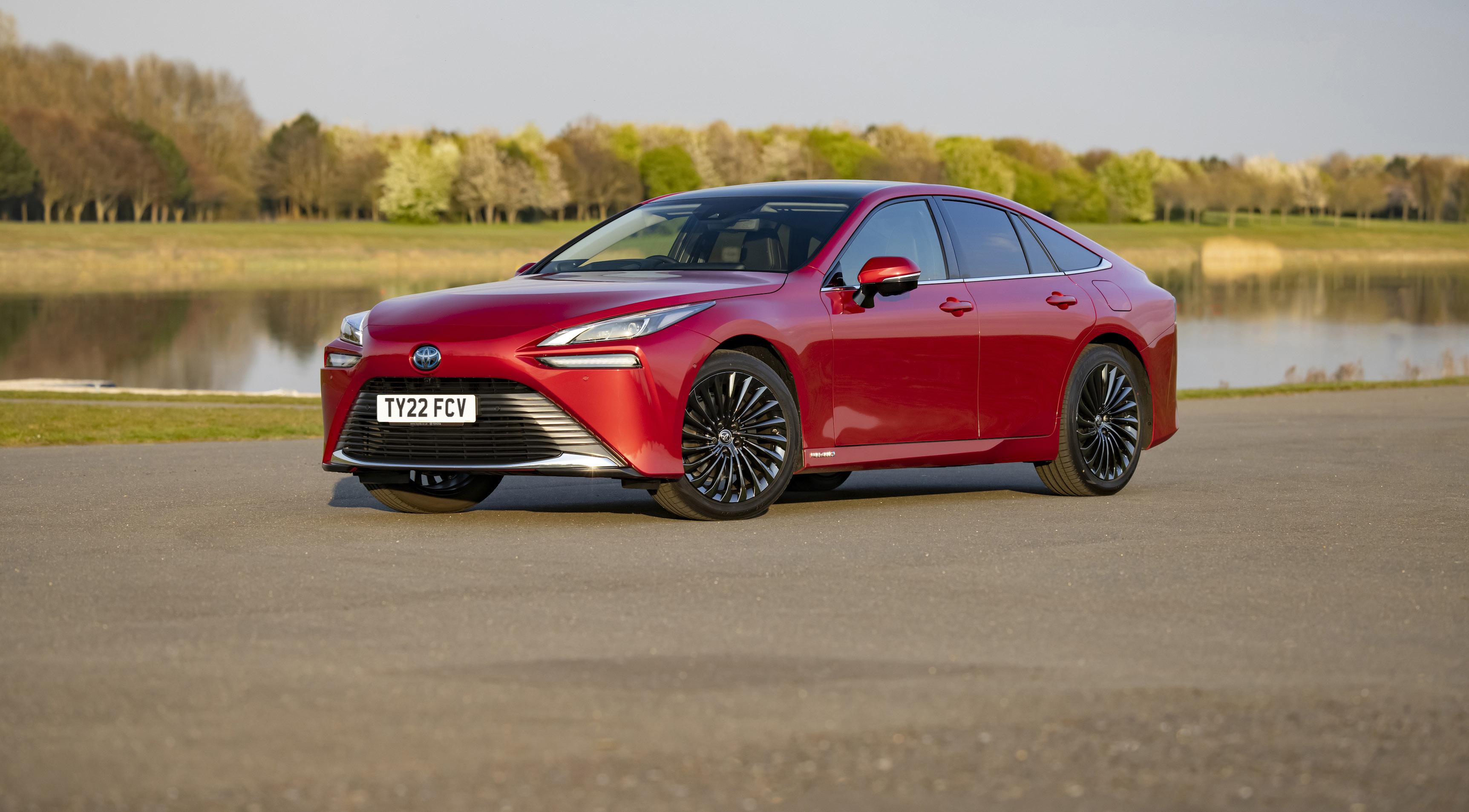
The top Design Premium tested here adds a colour head-up display, a digital rear view mirror, a heated steering wheel, a rear armrest multifunction panel, triple-zone air conditioning, ventilated front seats, heated and ventilated outer rear seats, as well as a panoramic sunroof and 20-inch alloy wheels. All Mirais come with Toyota’s full suite of Safety Sense driver assist technologies.
Just as with a conventional electric car, as the Toyota Mirai emits no CO2, it is currently exempt from any VED charges in the first and subsequent registration years. Two per cent
Benefit in Kind (BIK) tax is charged for 20222023, with the same charge applying to 2025.
Why does my fleet need one? While not a big seller, the Mirai plays an important role in Toyota’s fleet offering, and provides businesses with a luxurious and long range, zero-emissions vehicle. The changes introduced with the second generation Mirai make it a more appealing car, if still an expensive one. The limited refueling infrastructure may prove a challenge to some fleets, but ignoring that, the Mirai is a comfortable, refined and upmarket-feeling zero-emissions car. It proves the technology works, even if the commercial vehicle market will be infinitely better suited to the advantages it brings, such as large battery weight savings and faster refuel times. L
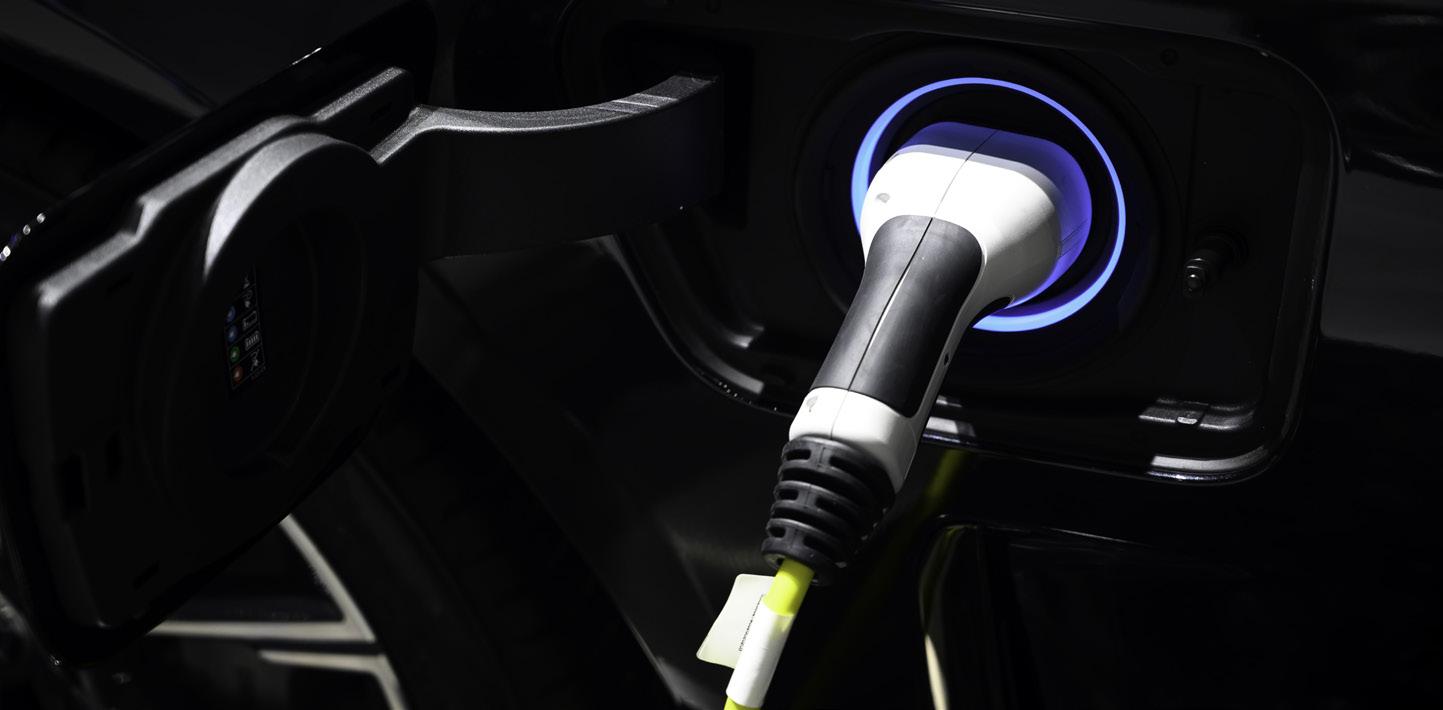

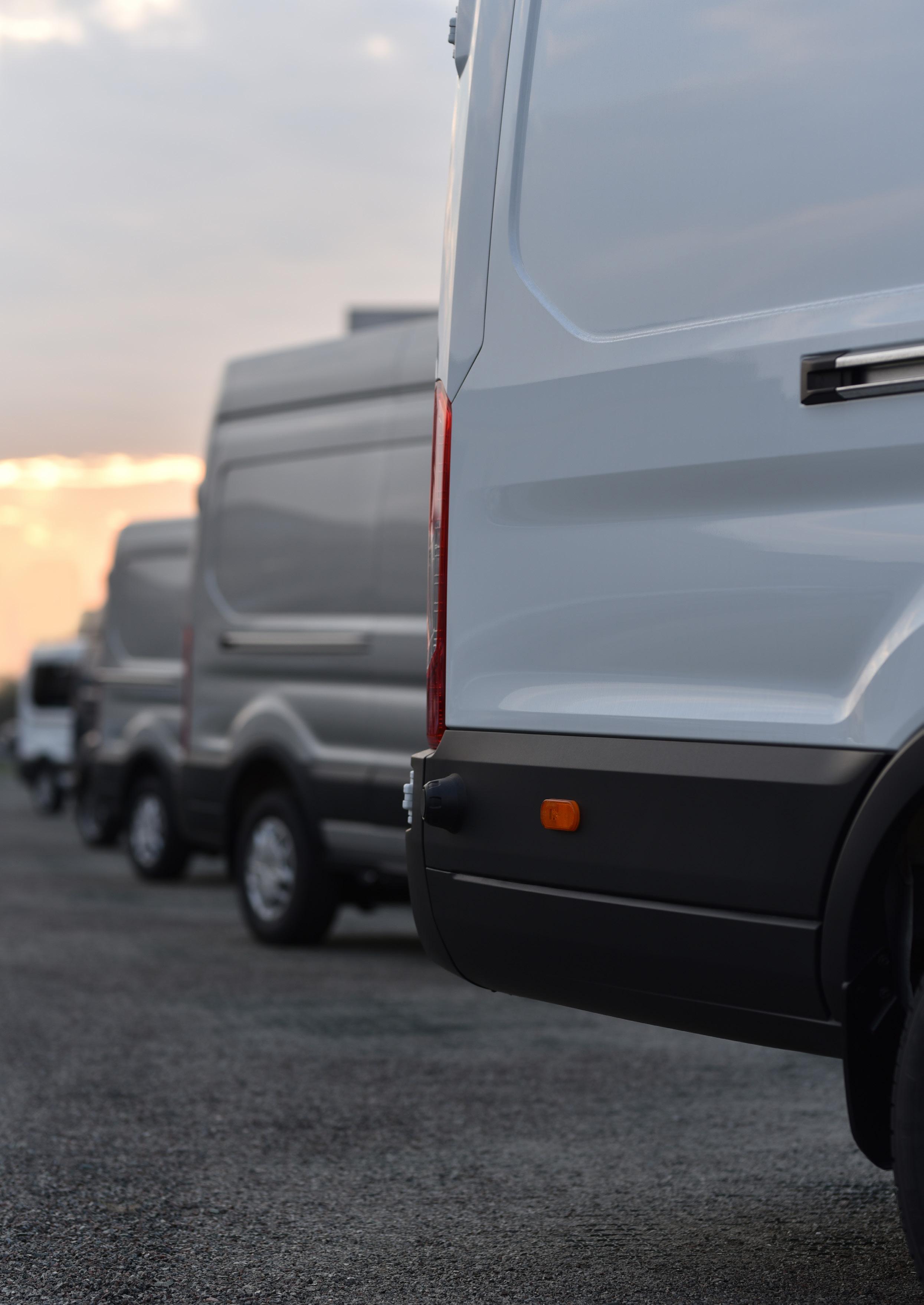
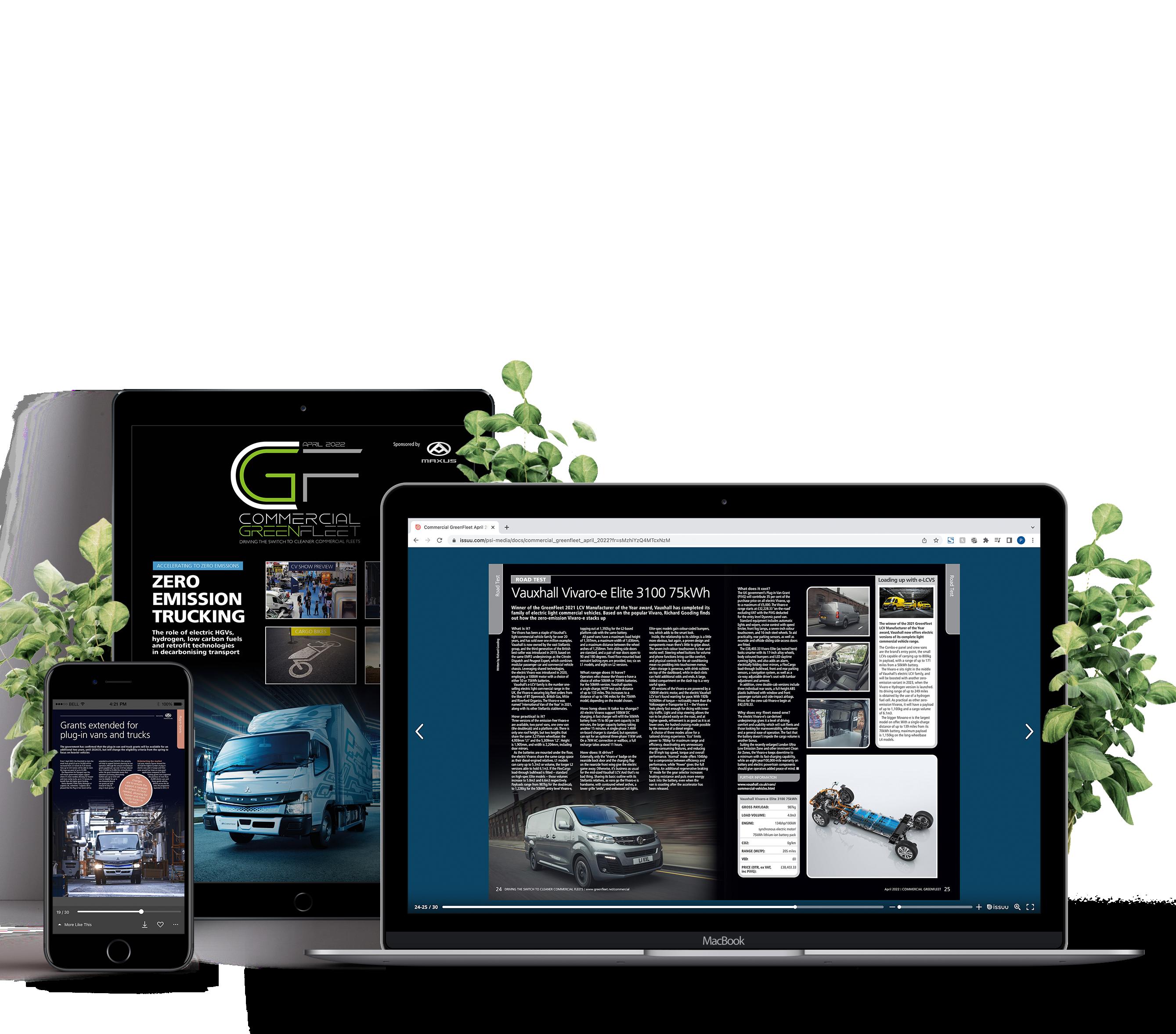
















Keeping in touch Your support makes a life-changing difference to people in crisis. We write to our supporters to update you about the work of the British Red Cross, and how you can help and donate in other ways. You can change the way we contact you at any time by visiting redcross.org.uk/keepingintouch or calling Freephone 0800 2800 491.
Privacy statement The British Red Cross is committed to privacy and will use personal data for the purpose it was collected or other legitimate purposes we tell you about: for example, to provide goods, services or information you have requested or to administer donations or services we provide. We may also analyse data we collect to better understand the people who support us or those who use or deliver our services. Sometimes this means us combining that data with information from reliable public sources. Our research allows us to tailor communications and services in a more focused and cost-effective way, as well as better meeting your needs and the needs of others like you. However, we will never do this in a way that intrudes on personal privacy and will not use your data for a purpose that conflicts with previously expressed privacy preferences. For full details about how we use personal data, our legal basis for doing so and your privacy rights, please see our privacy notice online at redcross.org.uk/privacy.
The DEC Ukraine Humanitarian Appeal will support people in areas currently affected and those potentially affected in the future by the crisis. In the unlikely event that we raise more money than can be reasonably and efficiently spent, any surplus funds will be used to help us prepare for and respond to other humanitarian disasters anywhere in the world. For more information visit https://donate. redcross.org.uk/appeal/disaster-fund



*Texts cost £10 +1 standard message (we receive 100%). For full T&Cs visit redcross.org.uk/mobile, must be 16+.











The British Red Cross Society, incorporated by Royal Charter 1908, is a charity registered in England and Wales (220949), Scotland (SC037738), Isle of Man (0752) and Jersey (430).



